New paper by SAFRING ringers on Lesser Grey Shrike Janine Dunlop (2024-03-18) | |||||||||||||||||||||||||||||||||||||||||||||||||||||||||||||||||||||||||||||||||||||||||||||||||||||||||||||||||||||||||||||||||||||||||||||||||||||||||||||||||||||||||||||||||||||||||||||||||||||||||||||||||||||||||||||||||||||||||||||||||||||||||||||||||||||||||||||||||||||||||||||||||||||||||||||||||||||||||||||||||||||||||||||||||||||||||||||||||||||||||||||||||||||||||||||||||||||||||||||||||||||||||||||||||||||||||||||||||||||||||||||||||||||||||||||||||||||||||||||||||||||||||||||||||||||||||||||||||||||||||||||||||||||||||||||||||||||||||||||||||||||||||||||||||||||||||||||
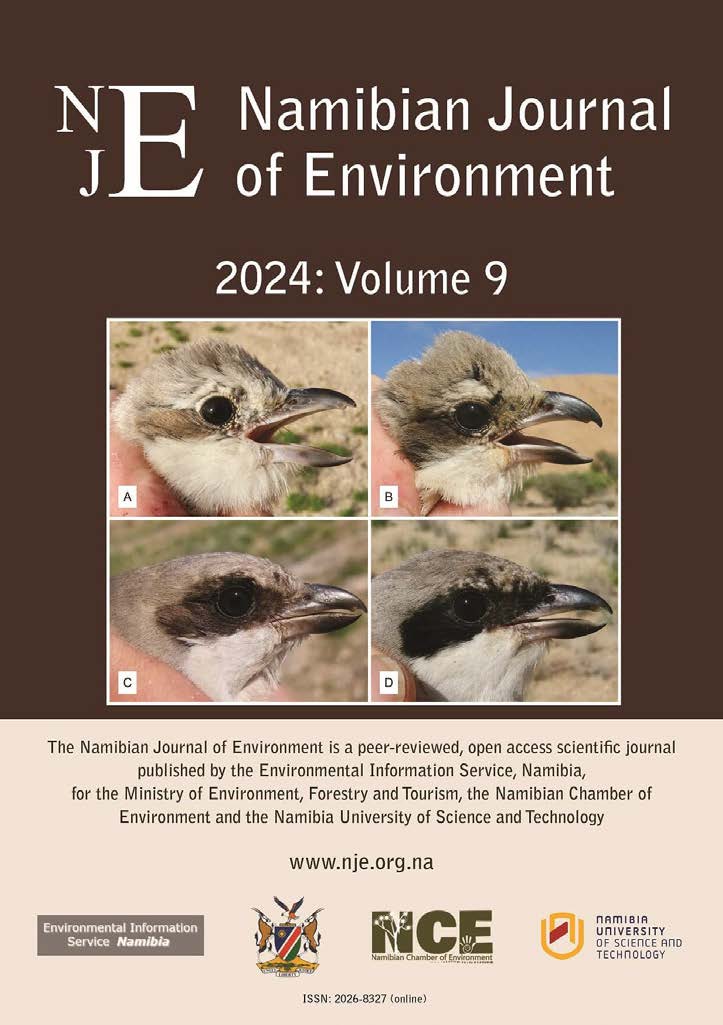 | A paper by Ursula Bryson and Dane Paijmans, published in the Namibian Journal of Environment, presents biometric data on 356 Lesser Grey Shrikes Lanius minorthat the authors ringed during their non-breeding season in Namibia. The paper addresses critical gaps in knowledge about the species' plumage and also provides essential information for accurate ageing. | ||||||||||||||||||||||||||||||||||||||||||||||||||||||||||||||||||||||||||||||||||||||||||||||||||||||||||||||||||||||||||||||||||||||||||||||||||||||||||||||||||||||||||||||||||||||||||||||||||||||||||||||||||||||||||||||||||||||||||||||||||||||||||||||||||||||||||||||||||||||||||||||||||||||||||||||||||||||||||||||||||||||||||||||||||||||||||||||||||||||||||||||||||||||||||||||||||||||||||||||||||||||||||||||||||||||||||||||||||||||||||||||||||||||||||||||||||||||||||||||||||||||||||||||||||||||||||||||||||||||||||||||||||||||||||||||||||||||||||||||||||||||||||||||||||||||||||||
African Oystercather resighting Janine Dunlop (2023-02-22) | |||||||||||||||||||||||||||||||||||||||||||||||||||||||||||||||||||||||||||||||||||||||||||||||||||||||||||||||||||||||||||||||||||||||||||||||||||||||||||||||||||||||||||||||||||||||||||||||||||||||||||||||||||||||||||||||||||||||||||||||||||||||||||||||||||||||||||||||||||||||||||||||||||||||||||||||||||||||||||||||||||||||||||||||||||||||||||||||||||||||||||||||||||||||||||||||||||||||||||||||||||||||||||||||||||||||||||||||||||||||||||||||||||||||||||||||||||||||||||||||||||||||||||||||||||||||||||||||||||||||||||||||||||||||||||||||||||||||||||||||||||||||||||||||||||||||||||||
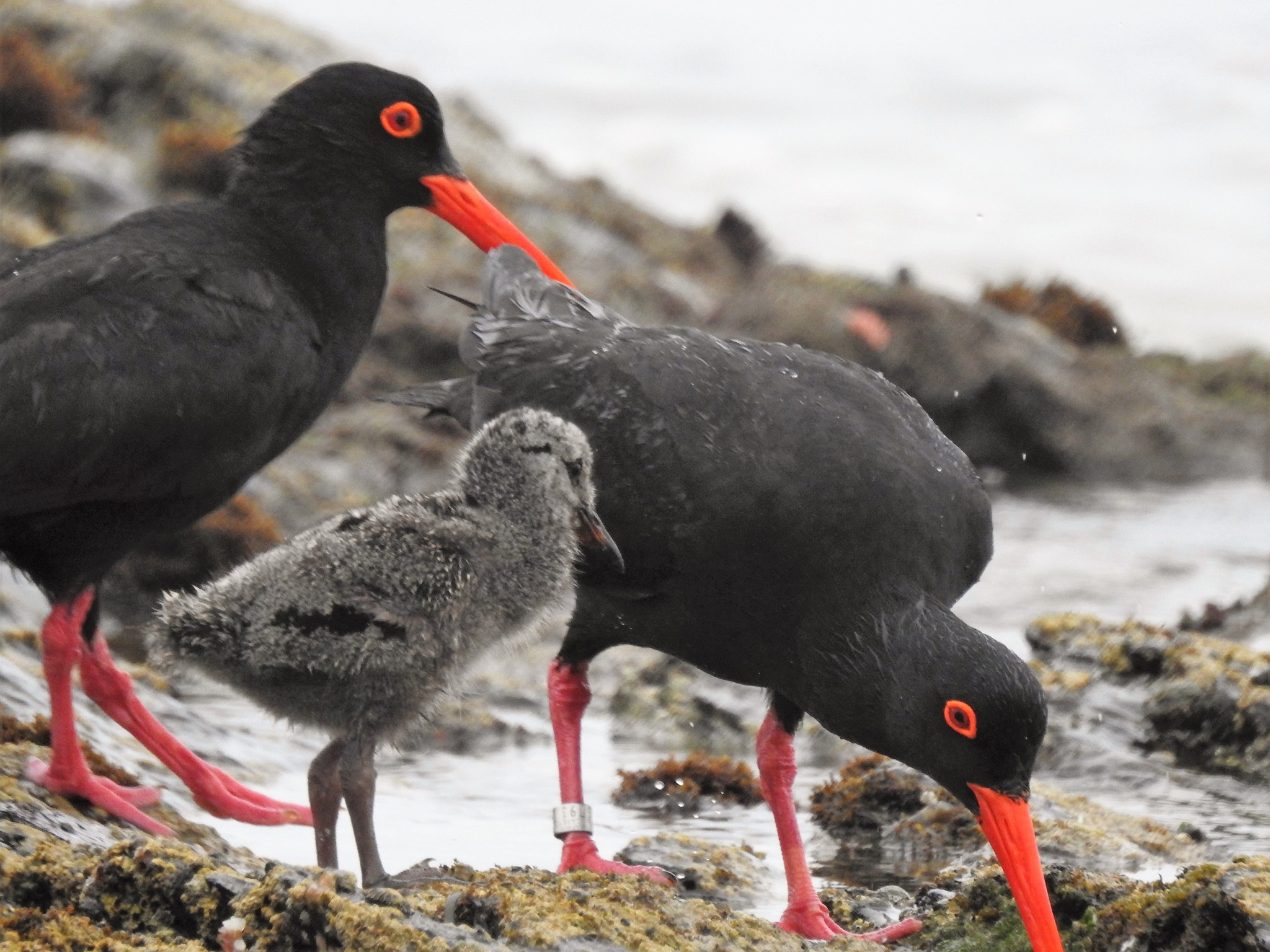 | Discover Eden posted this announcement to our Facebook group: Check out this awesome resighting of one of our African Oystercatchers! Our Conservation Director, Mark Brown ringed this individual near the Keurbooms River mouth as a chick on 16th December 2012. There are no sightings of this bird recorded until just the other day when on 17 January 2023, Andrew & Sandy Siebörger photographed it with its breeding partner and two chicks just south of the caravan park in Jeffrey's Bay! Truus Hedding contacted Safring who processed the data. We absolutely LOVE African Oystercatchers, and this resighting shows the value of the ongoing bird ringing (banding) work that we do. This is not the oldest oyk of ours - we have had a few around 20 years old, with the species record being around 30 years, but it is our first movement to Jeffrey's Bay. We have had movements between Knysna and Plett a few times, mostly chicks ringed in Knysna breeding in Plett as adults), and one nice movement of a Knysna born chick, that bred in Plett for a few years before being seen in Boggomsbaai, near Vleesbaai - a similar distance from Plett to JBay. Keep an eye out for ringed birds and take some pics - you never know - you might be able to help with our next exciting story!" | ||||||||||||||||||||||||||||||||||||||||||||||||||||||||||||||||||||||||||||||||||||||||||||||||||||||||||||||||||||||||||||||||||||||||||||||||||||||||||||||||||||||||||||||||||||||||||||||||||||||||||||||||||||||||||||||||||||||||||||||||||||||||||||||||||||||||||||||||||||||||||||||||||||||||||||||||||||||||||||||||||||||||||||||||||||||||||||||||||||||||||||||||||||||||||||||||||||||||||||||||||||||||||||||||||||||||||||||||||||||||||||||||||||||||||||||||||||||||||||||||||||||||||||||||||||||||||||||||||||||||||||||||||||||||||||||||||||||||||||||||||||||||||||||||||||||||||||
Resighting of a 23 year-old Black-browed Albatross Janine Dunlop (2022-06-07) | |||||||||||||||||||||||||||||||||||||||||||||||||||||||||||||||||||||||||||||||||||||||||||||||||||||||||||||||||||||||||||||||||||||||||||||||||||||||||||||||||||||||||||||||||||||||||||||||||||||||||||||||||||||||||||||||||||||||||||||||||||||||||||||||||||||||||||||||||||||||||||||||||||||||||||||||||||||||||||||||||||||||||||||||||||||||||||||||||||||||||||||||||||||||||||||||||||||||||||||||||||||||||||||||||||||||||||||||||||||||||||||||||||||||||||||||||||||||||||||||||||||||||||||||||||||||||||||||||||||||||||||||||||||||||||||||||||||||||||||||||||||||||||||||||||||||||||||
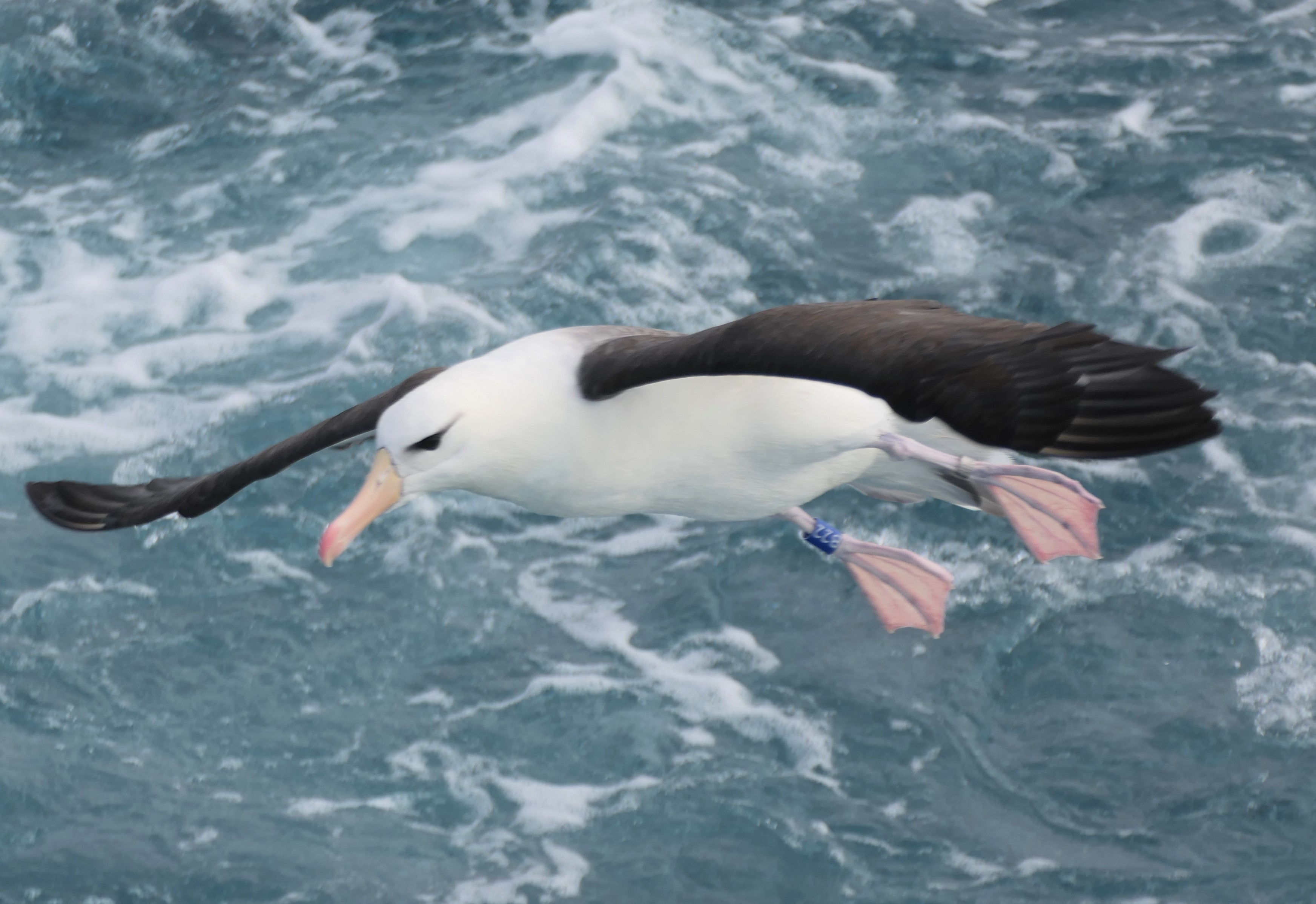 | A resighting of a Black-browed Albatross from a fishing vessel 60 miles from the coast of Lüderitz was reported to us by Juan Martín Bermúdez ( @juan_martin_martinete and @salarteorg). The SAFRING record can be viewed here. Read ACAP's (Agreement on the Conservation of Albatrosses and Petrels) report on this amazing sighting. | ||||||||||||||||||||||||||||||||||||||||||||||||||||||||||||||||||||||||||||||||||||||||||||||||||||||||||||||||||||||||||||||||||||||||||||||||||||||||||||||||||||||||||||||||||||||||||||||||||||||||||||||||||||||||||||||||||||||||||||||||||||||||||||||||||||||||||||||||||||||||||||||||||||||||||||||||||||||||||||||||||||||||||||||||||||||||||||||||||||||||||||||||||||||||||||||||||||||||||||||||||||||||||||||||||||||||||||||||||||||||||||||||||||||||||||||||||||||||||||||||||||||||||||||||||||||||||||||||||||||||||||||||||||||||||||||||||||||||||||||||||||||||||||||||||||||||||||
New paper about ringed Southern and Northern Fiscals Janine Dunlop (2022-04-22) | |||||||||||||||||||||||||||||||||||||||||||||||||||||||||||||||||||||||||||||||||||||||||||||||||||||||||||||||||||||||||||||||||||||||||||||||||||||||||||||||||||||||||||||||||||||||||||||||||||||||||||||||||||||||||||||||||||||||||||||||||||||||||||||||||||||||||||||||||||||||||||||||||||||||||||||||||||||||||||||||||||||||||||||||||||||||||||||||||||||||||||||||||||||||||||||||||||||||||||||||||||||||||||||||||||||||||||||||||||||||||||||||||||||||||||||||||||||||||||||||||||||||||||||||||||||||||||||||||||||||||||||||||||||||||||||||||||||||||||||||||||||||||||||||||||||||||||||
 | In "Common Fiscal (Lanius collaris) Linnaeus, 1766: comparative biometrics, moult data and criteria for the determination of age and sex", published in the Namibian Journal of Environment, authors Ursula Bryson and Dane Paijmans present biometrics, moult data and criteria for the determination of age and sex for both subspecies groups of Common Fiscal (Lanius collaris) that occur in Namibia. 235 birds were ringed, mainly in Namibia, between 2002 and 2020. They were measured and moult scores were taken in accordance with SAFRING guidelines. Read the paper. | ||||||||||||||||||||||||||||||||||||||||||||||||||||||||||||||||||||||||||||||||||||||||||||||||||||||||||||||||||||||||||||||||||||||||||||||||||||||||||||||||||||||||||||||||||||||||||||||||||||||||||||||||||||||||||||||||||||||||||||||||||||||||||||||||||||||||||||||||||||||||||||||||||||||||||||||||||||||||||||||||||||||||||||||||||||||||||||||||||||||||||||||||||||||||||||||||||||||||||||||||||||||||||||||||||||||||||||||||||||||||||||||||||||||||||||||||||||||||||||||||||||||||||||||||||||||||||||||||||||||||||||||||||||||||||||||||||||||||||||||||||||||||||||||||||||||||||||
Do you know this bird? Janine Dunlop (2022-03-24) | |||||||||||||||||||||||||||||||||||||||||||||||||||||||||||||||||||||||||||||||||||||||||||||||||||||||||||||||||||||||||||||||||||||||||||||||||||||||||||||||||||||||||||||||||||||||||||||||||||||||||||||||||||||||||||||||||||||||||||||||||||||||||||||||||||||||||||||||||||||||||||||||||||||||||||||||||||||||||||||||||||||||||||||||||||||||||||||||||||||||||||||||||||||||||||||||||||||||||||||||||||||||||||||||||||||||||||||||||||||||||||||||||||||||||||||||||||||||||||||||||||||||||||||||||||||||||||||||||||||||||||||||||||||||||||||||||||||||||||||||||||||||||||||||||||||||||||||
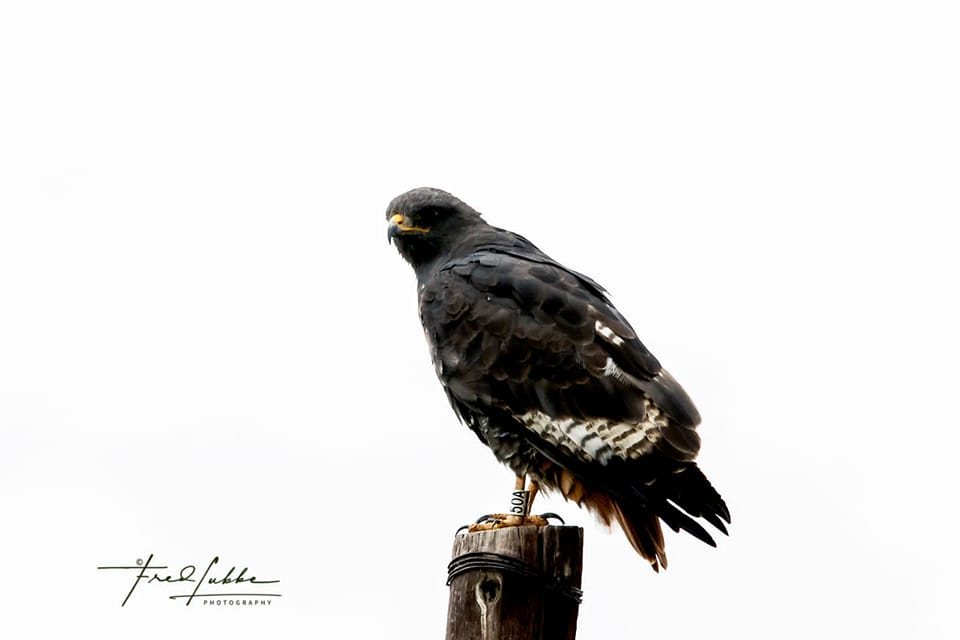 | No, this isn't a case of not knowing the species. We want to know who the ringer was! A photograph by Fred Lubbe of a Jackal buzzard, spotted in Bushman's Nek road near Underberg, was posted to our Facebook group on the 11th of March, 2022, with a plea for more information. Unfortunately, there is no information in the SAFRING database about this bird. It turns out that the ringing origins of this bird, colour ring 50A, have been a mystery for eight years! In 2014, it was spotted in the same area. Attempts were made then to trap the bird to get a read on the metal ring, but they were unsuccessful. 2022 Facebook post: https://www.facebook.com/photo?fbid=5068685403178542&set=gm.5511644235530411 2014 Facebook post: https://www.facebook.com/photo/?fbid=10152322965460586&set=gm.820150701346478 Did you ring this bird? Or do you know who did? Please get in touch with us at safring@birdmap.africa! | ||||||||||||||||||||||||||||||||||||||||||||||||||||||||||||||||||||||||||||||||||||||||||||||||||||||||||||||||||||||||||||||||||||||||||||||||||||||||||||||||||||||||||||||||||||||||||||||||||||||||||||||||||||||||||||||||||||||||||||||||||||||||||||||||||||||||||||||||||||||||||||||||||||||||||||||||||||||||||||||||||||||||||||||||||||||||||||||||||||||||||||||||||||||||||||||||||||||||||||||||||||||||||||||||||||||||||||||||||||||||||||||||||||||||||||||||||||||||||||||||||||||||||||||||||||||||||||||||||||||||||||||||||||||||||||||||||||||||||||||||||||||||||||||||||||||||||||
Common Tern visiting SA Janine Dunlop (2022-02-15) | |||||||||||||||||||||||||||||||||||||||||||||||||||||||||||||||||||||||||||||||||||||||||||||||||||||||||||||||||||||||||||||||||||||||||||||||||||||||||||||||||||||||||||||||||||||||||||||||||||||||||||||||||||||||||||||||||||||||||||||||||||||||||||||||||||||||||||||||||||||||||||||||||||||||||||||||||||||||||||||||||||||||||||||||||||||||||||||||||||||||||||||||||||||||||||||||||||||||||||||||||||||||||||||||||||||||||||||||||||||||||||||||||||||||||||||||||||||||||||||||||||||||||||||||||||||||||||||||||||||||||||||||||||||||||||||||||||||||||||||||||||||||||||||||||||||||||||||
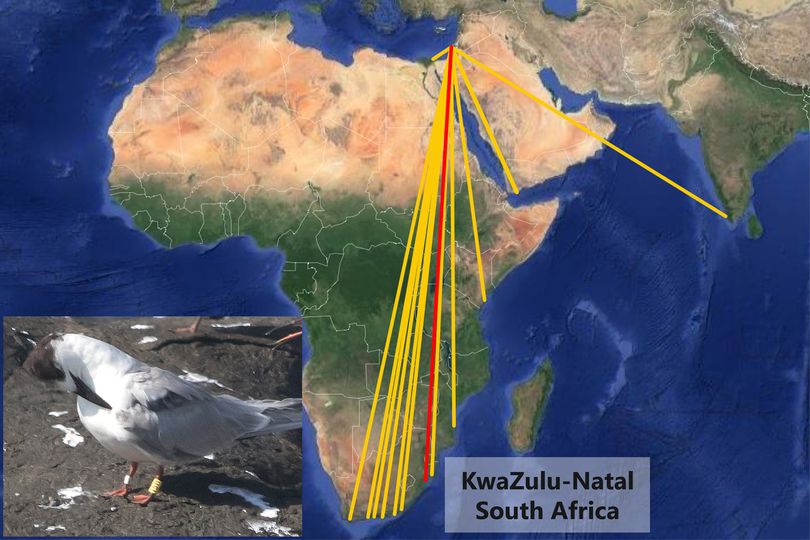 | Yosef Kiat, of the Israeli Bird Ringing Center, reports that a Common Tern that was ringed as part of a Spring 2017 project in Israel was found on the 12th February at Mvoti estuary, KwaZulu-Natal, South Africa (6,883 km) by Darren Van Eyssen and Nick Schaller. The red line on the image denotes this Tern's journey, while the orange lines are for those of terns spotted in recent years. Look out for white, green, red, black, and yellow rings with the letters, I or G on the legs of terns that are wintering in the southern hemisphere at the moment, and report them to the Israeli Bird Ringing Center: ibrc.israel@gmail.com. Original post: https://www.facebook.com/permalink.php?story_fbid=3039986492982917&id=100009147896231 | ||||||||||||||||||||||||||||||||||||||||||||||||||||||||||||||||||||||||||||||||||||||||||||||||||||||||||||||||||||||||||||||||||||||||||||||||||||||||||||||||||||||||||||||||||||||||||||||||||||||||||||||||||||||||||||||||||||||||||||||||||||||||||||||||||||||||||||||||||||||||||||||||||||||||||||||||||||||||||||||||||||||||||||||||||||||||||||||||||||||||||||||||||||||||||||||||||||||||||||||||||||||||||||||||||||||||||||||||||||||||||||||||||||||||||||||||||||||||||||||||||||||||||||||||||||||||||||||||||||||||||||||||||||||||||||||||||||||||||||||||||||||||||||||||||||||||||||
African Bird Fair: September 2019 Janine Dunlop (2019-09-02) | |||||||||||||||||||||||||||||||||||||||||||||||||||||||||||||||||||||||||||||||||||||||||||||||||||||||||||||||||||||||||||||||||||||||||||||||||||||||||||||||||||||||||||||||||||||||||||||||||||||||||||||||||||||||||||||||||||||||||||||||||||||||||||||||||||||||||||||||||||||||||||||||||||||||||||||||||||||||||||||||||||||||||||||||||||||||||||||||||||||||||||||||||||||||||||||||||||||||||||||||||||||||||||||||||||||||||||||||||||||||||||||||||||||||||||||||||||||||||||||||||||||||||||||||||||||||||||||||||||||||||||||||||||||||||||||||||||||||||||||||||||||||||||||||||||||||||||||
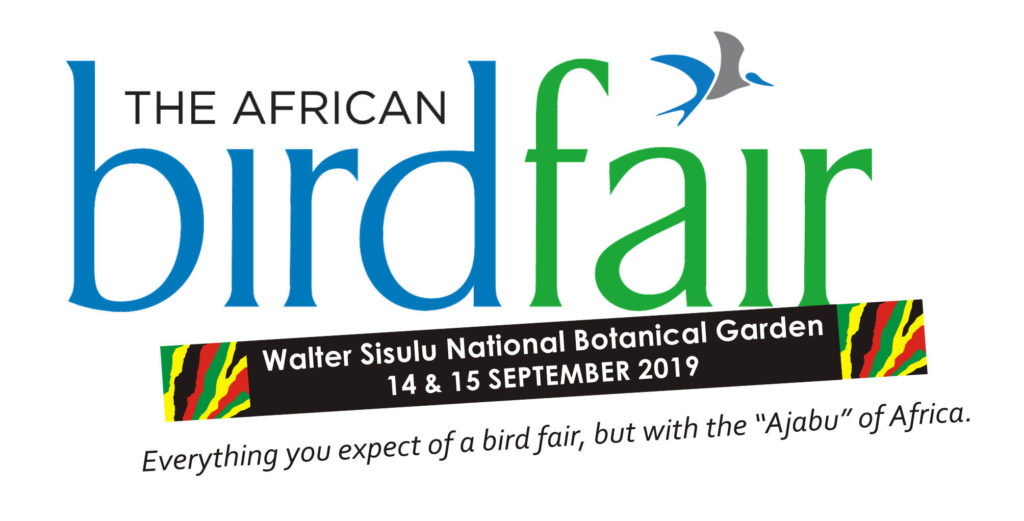 | BirdLife South Africa (https://www.birdlife.org.za) is hosting this year's African Bird Fair on the 14th and 15th September, at the Walter Sisulu National Botanical Garden, Roodepoort. There will be a citizen science stand, a photography workshop, guided walks, and many presentations. If you live in the wider Gauteng region, please visit and enjoy some amazing talks and opportunity to network! We hope to see you there! For more information see: https://www.birdlife.org.za/support-us/events/the-african-bird-fair | ||||||||||||||||||||||||||||||||||||||||||||||||||||||||||||||||||||||||||||||||||||||||||||||||||||||||||||||||||||||||||||||||||||||||||||||||||||||||||||||||||||||||||||||||||||||||||||||||||||||||||||||||||||||||||||||||||||||||||||||||||||||||||||||||||||||||||||||||||||||||||||||||||||||||||||||||||||||||||||||||||||||||||||||||||||||||||||||||||||||||||||||||||||||||||||||||||||||||||||||||||||||||||||||||||||||||||||||||||||||||||||||||||||||||||||||||||||||||||||||||||||||||||||||||||||||||||||||||||||||||||||||||||||||||||||||||||||||||||||||||||||||||||||||||||||||||||||
Introducing: Janine Dunlop Janine Dunlop (2019-08-28) | |||||||||||||||||||||||||||||||||||||||||||||||||||||||||||||||||||||||||||||||||||||||||||||||||||||||||||||||||||||||||||||||||||||||||||||||||||||||||||||||||||||||||||||||||||||||||||||||||||||||||||||||||||||||||||||||||||||||||||||||||||||||||||||||||||||||||||||||||||||||||||||||||||||||||||||||||||||||||||||||||||||||||||||||||||||||||||||||||||||||||||||||||||||||||||||||||||||||||||||||||||||||||||||||||||||||||||||||||||||||||||||||||||||||||||||||||||||||||||||||||||||||||||||||||||||||||||||||||||||||||||||||||||||||||||||||||||||||||||||||||||||||||||||||||||||||||||||
 | While I've been in contact with some of you over the past few months, either on our Facebook group, or via email, others might still be in the dark about who I am and where I fit in to the SAFRING family. To clear the confusion, here's a short introduction: I started at UCT's FitzPatrick Institute of African Ornithology in March 2019. My main job is librarian at the FitzPatrick's Niven Library. Part of the job is to assist with SAFRING tasks. I'm in charge of ring orders and registration of new ringers. I'm also one of the administrators of the SAFRING Facebook group and I maintain the Twitter account. You can either contact me via the SAFRING email address (safring@adu.org.za), or you can phone me at the Library: 0216503305. I'm not situated in the SAFRING office with Kim, but we're in regular contact. | ||||||||||||||||||||||||||||||||||||||||||||||||||||||||||||||||||||||||||||||||||||||||||||||||||||||||||||||||||||||||||||||||||||||||||||||||||||||||||||||||||||||||||||||||||||||||||||||||||||||||||||||||||||||||||||||||||||||||||||||||||||||||||||||||||||||||||||||||||||||||||||||||||||||||||||||||||||||||||||||||||||||||||||||||||||||||||||||||||||||||||||||||||||||||||||||||||||||||||||||||||||||||||||||||||||||||||||||||||||||||||||||||||||||||||||||||||||||||||||||||||||||||||||||||||||||||||||||||||||||||||||||||||||||||||||||||||||||||||||||||||||||||||||||||||||||||||||
On today’s menu, Cape Gannet Kim Hunt (2019-04-11) | |||||||||||||||||||||||||||||||||||||||||||||||||||||||||||||||||||||||||||||||||||||||||||||||||||||||||||||||||||||||||||||||||||||||||||||||||||||||||||||||||||||||||||||||||||||||||||||||||||||||||||||||||||||||||||||||||||||||||||||||||||||||||||||||||||||||||||||||||||||||||||||||||||||||||||||||||||||||||||||||||||||||||||||||||||||||||||||||||||||||||||||||||||||||||||||||||||||||||||||||||||||||||||||||||||||||||||||||||||||||||||||||||||||||||||||||||||||||||||||||||||||||||||||||||||||||||||||||||||||||||||||||||||||||||||||||||||||||||||||||||||||||||||||||||||||||||||||
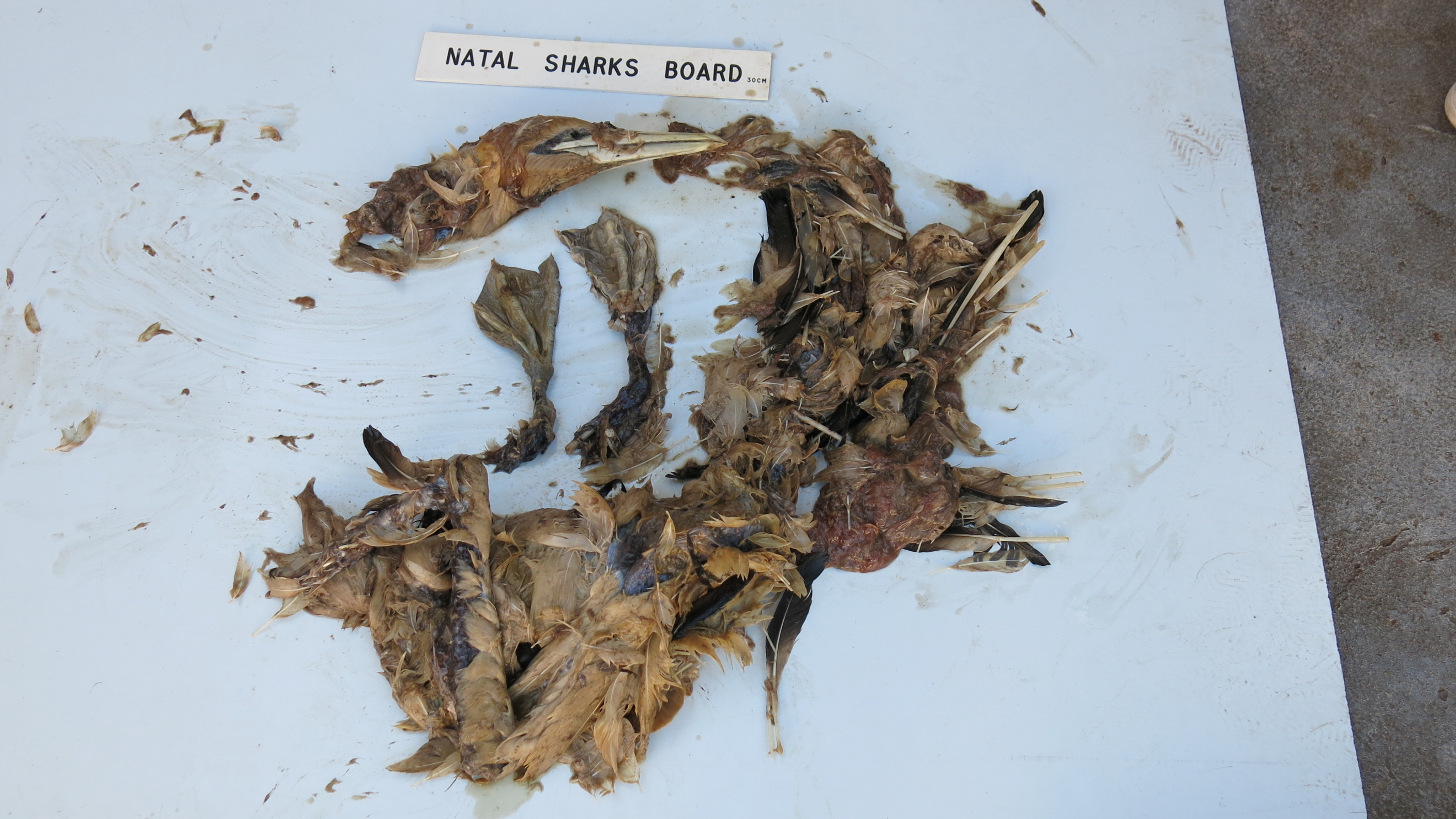 | This week we received a phone call from the KZN Sharks Board, reporting one of our more interesting ring recoveries. They had found the remains of a Cape Gannet in the stomach of an 87 kg male Tiger Shark, while performing a dissection. The shark was caught in a shark net, set up to protect beach goers at Margate Beach in Kwa-Zulu Natal. The Cape Gannet was originally ringed by Dr Klages, on Bird Island and Seal Island in Algoa Bay, on the 16th of July 2003. The Gannet remains were recovered by the KZN Sharks Board on the 4th of October 2018, approximately 507 km away from the initial ringing site. | ||||||||||||||||||||||||||||||||||||||||||||||||||||||||||||||||||||||||||||||||||||||||||||||||||||||||||||||||||||||||||||||||||||||||||||||||||||||||||||||||||||||||||||||||||||||||||||||||||||||||||||||||||||||||||||||||||||||||||||||||||||||||||||||||||||||||||||||||||||||||||||||||||||||||||||||||||||||||||||||||||||||||||||||||||||||||||||||||||||||||||||||||||||||||||||||||||||||||||||||||||||||||||||||||||||||||||||||||||||||||||||||||||||||||||||||||||||||||||||||||||||||||||||||||||||||||||||||||||||||||||||||||||||||||||||||||||||||||||||||||||||||||||||||||||||||||||||
A Short History of SAFRING - Part 9 Dieter Oschadleus (2018-09-11) | |||||||||||||||||||||||||||||||||||||||||||||||||||||||||||||||||||||||||||||||||||||||||||||||||||||||||||||||||||||||||||||||||||||||||||||||||||||||||||||||||||||||||||||||||||||||||||||||||||||||||||||||||||||||||||||||||||||||||||||||||||||||||||||||||||||||||||||||||||||||||||||||||||||||||||||||||||||||||||||||||||||||||||||||||||||||||||||||||||||||||||||||||||||||||||||||||||||||||||||||||||||||||||||||||||||||||||||||||||||||||||||||||||||||||||||||||||||||||||||||||||||||||||||||||||||||||||||||||||||||||||||||||||||||||||||||||||||||||||||||||||||||||||||||||||||||||||||
 | Bird ringing (or bird banding) in South Africa began in August 1948, exactly 70 years ago. In a series of short articles Dane Paijmans and I have presented an overview of ringing in southern Africa, largely by looking at the successive ringing organisers and what they achieved. This set of news items can be read on the SAFRING web site, or a slightly updated version may be read on the Biodiversity and Development Instituteweb site. In 2018 SAFRING moved back to the FitzPatrick Institute of African Ornithology, where it had been prior to being part of the Animal Demography Unit. | ||||||||||||||||||||||||||||||||||||||||||||||||||||||||||||||||||||||||||||||||||||||||||||||||||||||||||||||||||||||||||||||||||||||||||||||||||||||||||||||||||||||||||||||||||||||||||||||||||||||||||||||||||||||||||||||||||||||||||||||||||||||||||||||||||||||||||||||||||||||||||||||||||||||||||||||||||||||||||||||||||||||||||||||||||||||||||||||||||||||||||||||||||||||||||||||||||||||||||||||||||||||||||||||||||||||||||||||||||||||||||||||||||||||||||||||||||||||||||||||||||||||||||||||||||||||||||||||||||||||||||||||||||||||||||||||||||||||||||||||||||||||||||||||||||||||||||||
A Short History of SAFRING - Part 8 Dane Paijmans (2018-07-29) | |||||||||||||||||||||||||||||||||||||||||||||||||||||||||||||||||||||||||||||||||||||||||||||||||||||||||||||||||||||||||||||||||||||||||||||||||||||||||||||||||||||||||||||||||||||||||||||||||||||||||||||||||||||||||||||||||||||||||||||||||||||||||||||||||||||||||||||||||||||||||||||||||||||||||||||||||||||||||||||||||||||||||||||||||||||||||||||||||||||||||||||||||||||||||||||||||||||||||||||||||||||||||||||||||||||||||||||||||||||||||||||||||||||||||||||||||||||||||||||||||||||||||||||||||||||||||||||||||||||||||||||||||||||||||||||||||||||||||||||||||||||||||||||||||||||||||||||
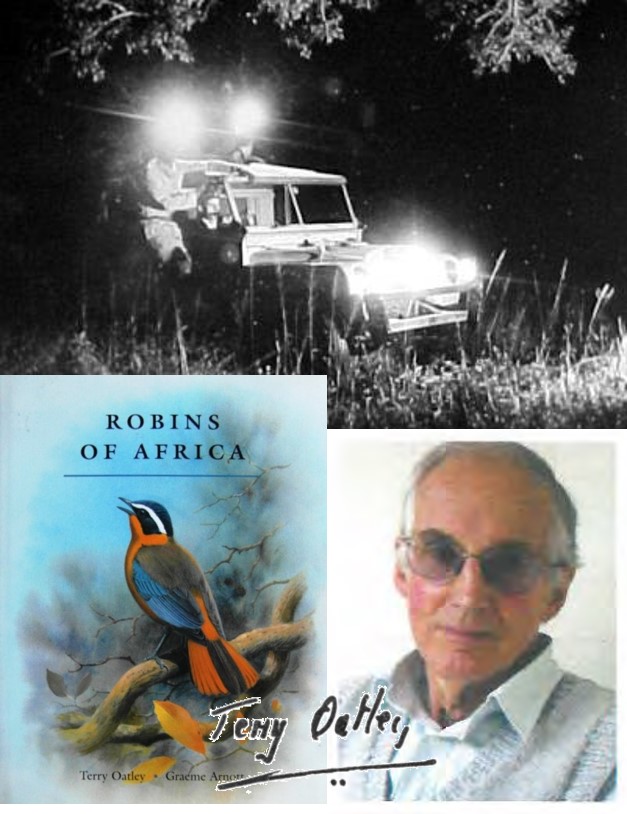 | The early years - Terry OatleyAfter Patrick Morant left in 1981, the position of SAFRING coordinator was filled by Terry Oatley, this time as a permanent post. With the assistance of Mirella Rammesmayer, Terry set out to; “make SAFRING a top flight service organisation and to give every encouragement and assistance possible to ringers, be they amateurs or professionals” – quote from his first SAFRING News editorial. Over the next 17 years he did just this with the number of active ringers increasing each year. Prior to SAFRING, Terry spent 22 years working at the Natal Parks Board (Terry can be seen sitting in a game vehicle in the photos attached). He was passionate about studying robins (a passion seeded in child hood – Read his daughters (Jenny Freemans') account in Ostrich), and published a book – Robins of Africa - and many papers on this group. In 1993, while he was at SAFRING, Terry was awarded his PhD by Wits for his work on the Ground Woodpecker. It would be impossible to capture all that Terry did over his 17 years as SAFRING coordinator in this short web article. To read more, please go through all his editorials from SAFRING News and end off with his light hearted final editorial where he comments on his highs and lows as coordinator. Following his retirement, in 1998 he was awarded the Gill Memorial Medal in recognition of his outstanding contribution to ornithology in the southern African region. To read more on SAFRINGs history please Click Here. | ||||||||||||||||||||||||||||||||||||||||||||||||||||||||||||||||||||||||||||||||||||||||||||||||||||||||||||||||||||||||||||||||||||||||||||||||||||||||||||||||||||||||||||||||||||||||||||||||||||||||||||||||||||||||||||||||||||||||||||||||||||||||||||||||||||||||||||||||||||||||||||||||||||||||||||||||||||||||||||||||||||||||||||||||||||||||||||||||||||||||||||||||||||||||||||||||||||||||||||||||||||||||||||||||||||||||||||||||||||||||||||||||||||||||||||||||||||||||||||||||||||||||||||||||||||||||||||||||||||||||||||||||||||||||||||||||||||||||||||||||||||||||||||||||||||||||||||
Historic photo Dieter Oschadleus (2017-11-14) | |||||||||||||||||||||||||||||||||||||||||||||||||||||||||||||||||||||||||||||||||||||||||||||||||||||||||||||||||||||||||||||||||||||||||||||||||||||||||||||||||||||||||||||||||||||||||||||||||||||||||||||||||||||||||||||||||||||||||||||||||||||||||||||||||||||||||||||||||||||||||||||||||||||||||||||||||||||||||||||||||||||||||||||||||||||||||||||||||||||||||||||||||||||||||||||||||||||||||||||||||||||||||||||||||||||||||||||||||||||||||||||||||||||||||||||||||||||||||||||||||||||||||||||||||||||||||||||||||||||||||||||||||||||||||||||||||||||||||||||||||||||||||||||||||||||||||||||
 | Photo from around 1998! Some of the Pretoria Bird Club members. L to R, top: Robert Thomson, Riaan Marais (recently deceased), Rihaan Geyser, Andrew Tucker Bottom: Philip Grobler, Dieter Oschadleus, Henk Bouwman | ||||||||||||||||||||||||||||||||||||||||||||||||||||||||||||||||||||||||||||||||||||||||||||||||||||||||||||||||||||||||||||||||||||||||||||||||||||||||||||||||||||||||||||||||||||||||||||||||||||||||||||||||||||||||||||||||||||||||||||||||||||||||||||||||||||||||||||||||||||||||||||||||||||||||||||||||||||||||||||||||||||||||||||||||||||||||||||||||||||||||||||||||||||||||||||||||||||||||||||||||||||||||||||||||||||||||||||||||||||||||||||||||||||||||||||||||||||||||||||||||||||||||||||||||||||||||||||||||||||||||||||||||||||||||||||||||||||||||||||||||||||||||||||||||||||||||||||
A Short History of SAFRING - Part 7 Dane Paijmans (2017-11-02) | |||||||||||||||||||||||||||||||||||||||||||||||||||||||||||||||||||||||||||||||||||||||||||||||||||||||||||||||||||||||||||||||||||||||||||||||||||||||||||||||||||||||||||||||||||||||||||||||||||||||||||||||||||||||||||||||||||||||||||||||||||||||||||||||||||||||||||||||||||||||||||||||||||||||||||||||||||||||||||||||||||||||||||||||||||||||||||||||||||||||||||||||||||||||||||||||||||||||||||||||||||||||||||||||||||||||||||||||||||||||||||||||||||||||||||||||||||||||||||||||||||||||||||||||||||||||||||||||||||||||||||||||||||||||||||||||||||||||||||||||||||||||||||||||||||||||||||||
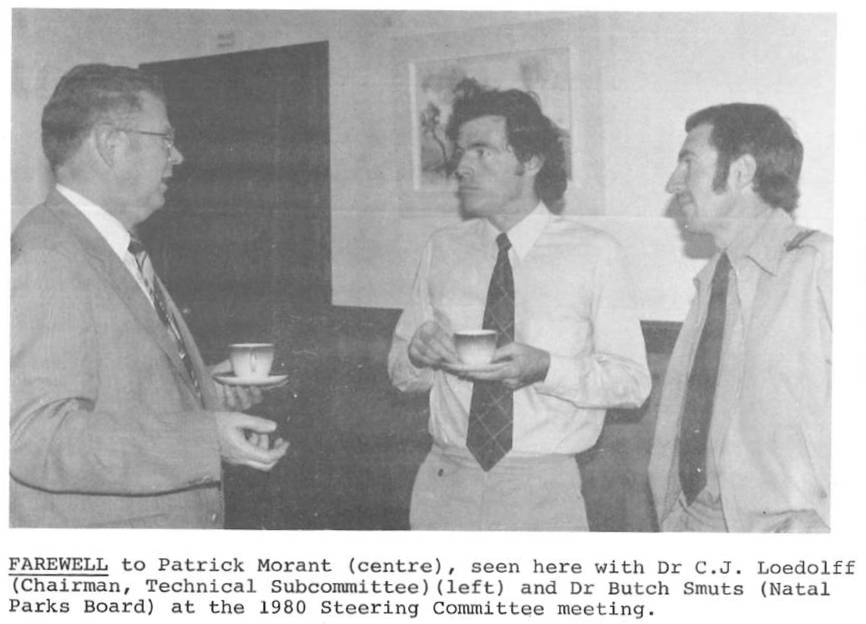 | The early years - Patrick D. MorantAfter Carl Vernon took up the post as ornithologist at the East London Museum, NUBRA (National Unit for Bird-Ringing Administration), now known as SAFRING (South African Bird Ringing Unit), stood leaderless once again. With this opening Patrick Morant (an MSc Student) was found to coordinate the Unit (with help from John Ledger). One of the first problems Patrick identified was the lack of communication between the amateurs and the professional ornithologists. As a result, one of his goals was to bridge this gap in what he called "Let's communicate '78'" (Read more in his editorial entitled, Communication). Continuing with this mantra he encouraged amateur ringers to send in their ideas and observations for the SAFRING News letter, in his Editorial - Write It Up! In addition to this sharing of knowledge through newsletters he also discussed the requirements around the sharing of ringing data and potential use thereof.
This was not a permanent post (still housed at the Percy FitzPatrick Institute of African Ornithology) and Patrick left in 1981 to pursue other projects in Estuarine Ecology. During his stay Patrick authored three Annual Reports (the twentieth, twenty-first and twenty-second).
To read more on SAFRINGs history please Click Here. | ||||||||||||||||||||||||||||||||||||||||||||||||||||||||||||||||||||||||||||||||||||||||||||||||||||||||||||||||||||||||||||||||||||||||||||||||||||||||||||||||||||||||||||||||||||||||||||||||||||||||||||||||||||||||||||||||||||||||||||||||||||||||||||||||||||||||||||||||||||||||||||||||||||||||||||||||||||||||||||||||||||||||||||||||||||||||||||||||||||||||||||||||||||||||||||||||||||||||||||||||||||||||||||||||||||||||||||||||||||||||||||||||||||||||||||||||||||||||||||||||||||||||||||||||||||||||||||||||||||||||||||||||||||||||||||||||||||||||||||||||||||||||||||||||||||||||||||
A Short History of SAFRING - Part 6 Dane Paijmans (2017-10-24) | |||||||||||||||||||||||||||||||||||||||||||||||||||||||||||||||||||||||||||||||||||||||||||||||||||||||||||||||||||||||||||||||||||||||||||||||||||||||||||||||||||||||||||||||||||||||||||||||||||||||||||||||||||||||||||||||||||||||||||||||||||||||||||||||||||||||||||||||||||||||||||||||||||||||||||||||||||||||||||||||||||||||||||||||||||||||||||||||||||||||||||||||||||||||||||||||||||||||||||||||||||||||||||||||||||||||||||||||||||||||||||||||||||||||||||||||||||||||||||||||||||||||||||||||||||||||||||||||||||||||||||||||||||||||||||||||||||||||||||||||||||||||||||||||||||||||||||||
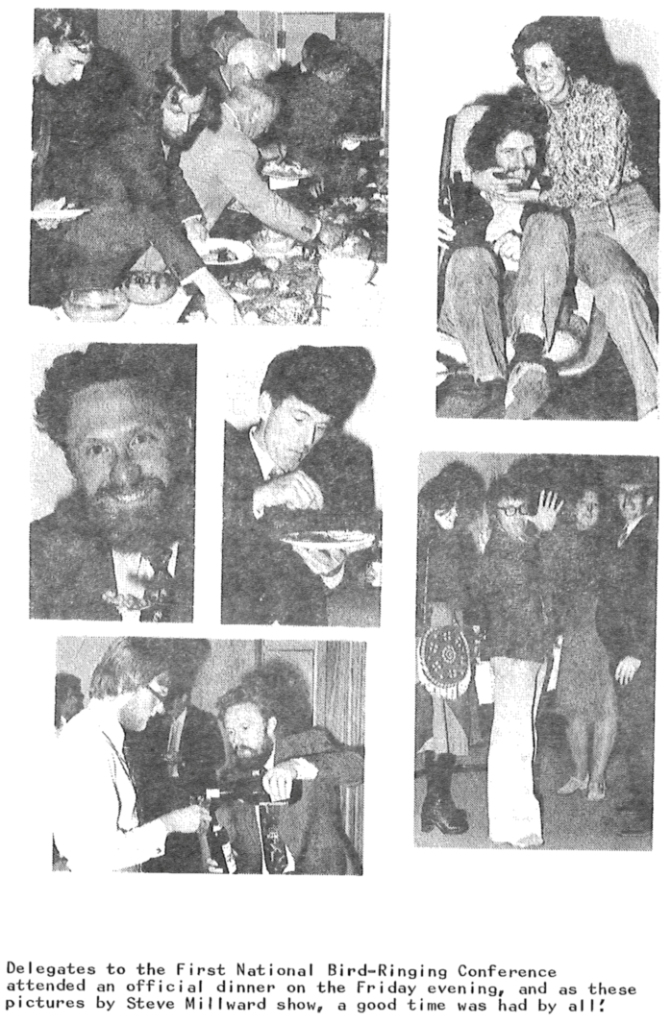 | The early years - Dr Carl J. VernonWith Sir Clive Elliott leaving the NUBRA (National Unit for Bird-Ringing Administration) in 1974 to work for the Food and Agriculture Organization of the United Nations, the Post for Bird Ringing Coordinator was once again opened. As a result Dr Carl J. Vernon took the post in 1975. At the time the Ringing Scheme was still hosted by the Percy FitzPatrick Institute of African Ornithology, University of Cape Town. One of the big projects Carl took over from Clive was the computerisation of ringing data onto Hollerith cards (punch cards). Close friend Dr Steven Piper (founder of the Steven Piper SAFRING Trust) assisted in this, although all did not go to plan (Read further details in Carls' Obituary for Steven). Carl has a noted interest in shorebirds which can be seen in the topics chosen for the SAFRING News Articles during his term (Read SAFRING News). Additionally Carl put a lot of effort in promoting colour ringing as a means of improving the resighting counts (Read his first Editorial), and authored three Annual Reports (the seventeenth, eighteenth and nineteenth). During his term at the ringing unit, the First National Ringing Conference was held in Gauteng. Carl was then offered the post as ornithologist at the East London Museum and left in 1976. To read more on SAFRINGs history please Click Here. | ||||||||||||||||||||||||||||||||||||||||||||||||||||||||||||||||||||||||||||||||||||||||||||||||||||||||||||||||||||||||||||||||||||||||||||||||||||||||||||||||||||||||||||||||||||||||||||||||||||||||||||||||||||||||||||||||||||||||||||||||||||||||||||||||||||||||||||||||||||||||||||||||||||||||||||||||||||||||||||||||||||||||||||||||||||||||||||||||||||||||||||||||||||||||||||||||||||||||||||||||||||||||||||||||||||||||||||||||||||||||||||||||||||||||||||||||||||||||||||||||||||||||||||||||||||||||||||||||||||||||||||||||||||||||||||||||||||||||||||||||||||||||||||||||||||||||||||
A Short History of SAFRING - Part 5 Dane Paijmans (2017-10-19) | |||||||||||||||||||||||||||||||||||||||||||||||||||||||||||||||||||||||||||||||||||||||||||||||||||||||||||||||||||||||||||||||||||||||||||||||||||||||||||||||||||||||||||||||||||||||||||||||||||||||||||||||||||||||||||||||||||||||||||||||||||||||||||||||||||||||||||||||||||||||||||||||||||||||||||||||||||||||||||||||||||||||||||||||||||||||||||||||||||||||||||||||||||||||||||||||||||||||||||||||||||||||||||||||||||||||||||||||||||||||||||||||||||||||||||||||||||||||||||||||||||||||||||||||||||||||||||||||||||||||||||||||||||||||||||||||||||||||||||||||||||||||||||||||||||||||||||||
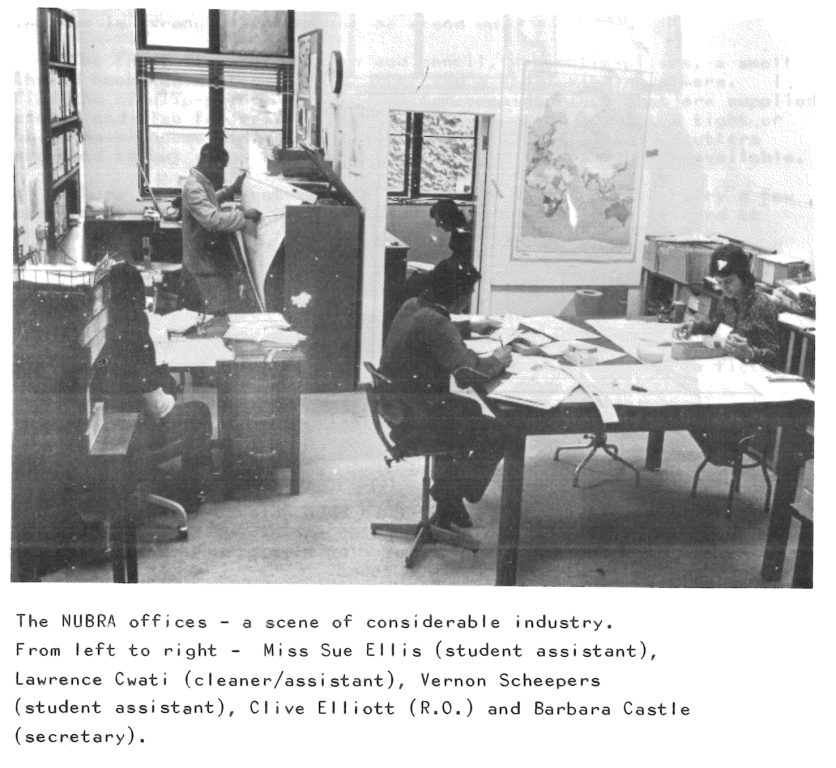 | The early years - Sir Clive C.H. ElliottAfter Dr Geoffrey Roy McLachlan moved from Museum in Port Elizabeth in 1966 (read Dr McLachlans note), it was decided that the Ringing Scheme be handed over to a larger organisation with proper funding and staff. As a result the entire scheme was moved to the FitzPatrick Unit in Cape Town. The scheme was still administered by the South African Ornithological Society (SAOS - Now BirdLife South Africa) until 1972 when the first full time coordinator was employed, Dr Clive Elliott. With this new leadership the Scheme was renamed the National Unit for Bird-Ringing Administration (NUBRA). This new unit struggled initially as the ringing data had been neglected over the previous five years. It soon made some great steps forward and one of the great improvements Clive made was the creation of "SAFRING News". In the first editorial entitled "Overcoming Isolation" Clive details the need for communication between ringers (to share knowledge, techniques, downfalls and interesting observations) and thus emphasising the need for such a magazine (written for the ringers, by the ringers). During his time at NUBRA Clive authored (along with Mike Jarvis) three Annual Reports (the fourteenth, fifteenth and sixteenth). Although he only stayed for three years he was able to achieve a lot (to read a short account of his years click here).
To read more on SAFRINGs history please Click Here. | ||||||||||||||||||||||||||||||||||||||||||||||||||||||||||||||||||||||||||||||||||||||||||||||||||||||||||||||||||||||||||||||||||||||||||||||||||||||||||||||||||||||||||||||||||||||||||||||||||||||||||||||||||||||||||||||||||||||||||||||||||||||||||||||||||||||||||||||||||||||||||||||||||||||||||||||||||||||||||||||||||||||||||||||||||||||||||||||||||||||||||||||||||||||||||||||||||||||||||||||||||||||||||||||||||||||||||||||||||||||||||||||||||||||||||||||||||||||||||||||||||||||||||||||||||||||||||||||||||||||||||||||||||||||||||||||||||||||||||||||||||||||||||||||||||||||||||||
A Short History of SAFRING - Part 4 Dane Paijmans (2017-10-09) | |||||||||||||||||||||||||||||||||||||||||||||||||||||||||||||||||||||||||||||||||||||||||||||||||||||||||||||||||||||||||||||||||||||||||||||||||||||||||||||||||||||||||||||||||||||||||||||||||||||||||||||||||||||||||||||||||||||||||||||||||||||||||||||||||||||||||||||||||||||||||||||||||||||||||||||||||||||||||||||||||||||||||||||||||||||||||||||||||||||||||||||||||||||||||||||||||||||||||||||||||||||||||||||||||||||||||||||||||||||||||||||||||||||||||||||||||||||||||||||||||||||||||||||||||||||||||||||||||||||||||||||||||||||||||||||||||||||||||||||||||||||||||||||||||||||||||||||
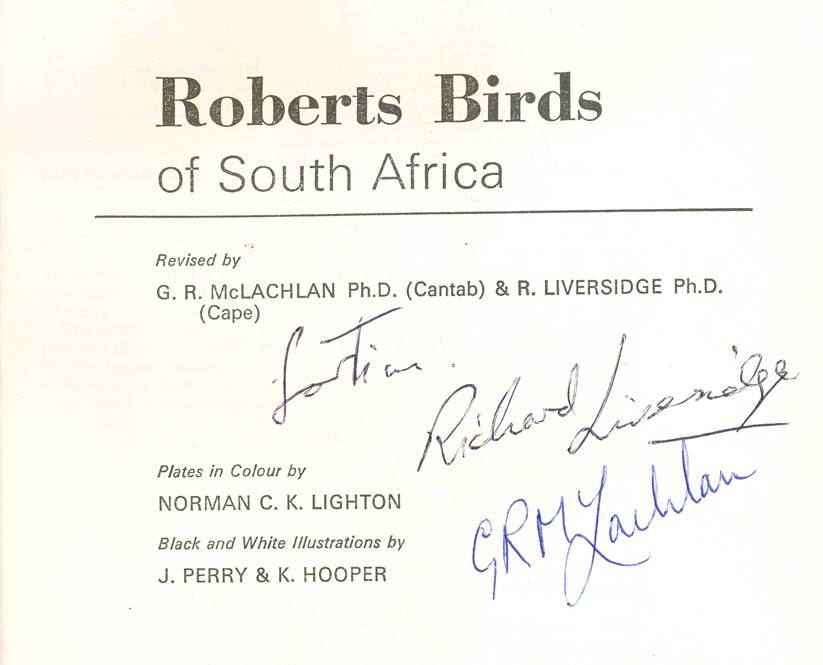 | The early years - Dr Geoffrey Roy McLachlanAfter the first South African Bird Ringing Scheme Coordinator, Dr Hugh Ashton, retired his position on July 1st, 1956, Dr Geoffrey Roy McLachlan took over the reins. After an initial trail period, where the treasurer, Mr Heard, and Dr McLachlan worked through correspondence, the whole scheme was relocated to Port Elizabeth. Dr McLachlan had his work cut out for him, as a number of problems arose with the growing ringing dataset. Some of these problems included; data storage, data submissions and costs of ringing (Read Dr GR McLachlan's Account). One of the drastic moves he made to improve data submissions, was to drive across the country visiting all ringing hot spots to help ringers in person. During his time as coordinator he authored eight ringing reports (Read Here; seventh, eighth, ninth, tenth, eleventh, twelfth, thirteenth), as well as many papers, Roberts' Birds of South Africa (2nd, 3rd and 4th) and a ten year summary.
Dr GR McLachlan left the Ringing Unit at the end of 1966 to persue other projects and passed away at age 81 on January 17th 2005 (obituary).
Photo taken at the 1964 Pan-African Ornithological Congress. Dr McLachlan, Dr Niven and Mr JP Niven were the Organising Committee for the First Pan African Congress held in Livingstone, Zambia, from 15–19 July 1957. To read more on SAFRINGs history please Click Here. | ||||||||||||||||||||||||||||||||||||||||||||||||||||||||||||||||||||||||||||||||||||||||||||||||||||||||||||||||||||||||||||||||||||||||||||||||||||||||||||||||||||||||||||||||||||||||||||||||||||||||||||||||||||||||||||||||||||||||||||||||||||||||||||||||||||||||||||||||||||||||||||||||||||||||||||||||||||||||||||||||||||||||||||||||||||||||||||||||||||||||||||||||||||||||||||||||||||||||||||||||||||||||||||||||||||||||||||||||||||||||||||||||||||||||||||||||||||||||||||||||||||||||||||||||||||||||||||||||||||||||||||||||||||||||||||||||||||||||||||||||||||||||||||||||||||||||||||
A Short History of SAFRING - Part 3 Dane Paijmans (2017-10-02) | |||||||||||||||||||||||||||||||||||||||||||||||||||||||||||||||||||||||||||||||||||||||||||||||||||||||||||||||||||||||||||||||||||||||||||||||||||||||||||||||||||||||||||||||||||||||||||||||||||||||||||||||||||||||||||||||||||||||||||||||||||||||||||||||||||||||||||||||||||||||||||||||||||||||||||||||||||||||||||||||||||||||||||||||||||||||||||||||||||||||||||||||||||||||||||||||||||||||||||||||||||||||||||||||||||||||||||||||||||||||||||||||||||||||||||||||||||||||||||||||||||||||||||||||||||||||||||||||||||||||||||||||||||||||||||||||||||||||||||||||||||||||||||||||||||||||||||||
 | The early years - Dr Hugh AshtonBird ringing was initially organized in 1948 by the Southern African Ornithological Society, SAOS (Read the meeting minutes). Dr Hugh Ashton from the Witwaterstrand Bird Club played a big part in this development and later coordinated the scheme until 1 July 1956 (Read Dr Hugh Ashtons Account). During this time he authored the first six ringing reports (Read Here; First, Second, Third, Forth, Fifth, Sixth). From the first ringing session where simple numeric rings (produced by the SA mint) were used, the scheme quickly developed and established itself at the Zoological Gardens in Pretoria. This led to the use of "INFORM ZOO PRETORIA" ring inscription which can still sometimes be seen today. The first retrap of a ring inscribed in this way was sighted in 1948(a juvenile Yellow-billed Kiteref)
To read more on SAFRINGs history please Click Here. | ||||||||||||||||||||||||||||||||||||||||||||||||||||||||||||||||||||||||||||||||||||||||||||||||||||||||||||||||||||||||||||||||||||||||||||||||||||||||||||||||||||||||||||||||||||||||||||||||||||||||||||||||||||||||||||||||||||||||||||||||||||||||||||||||||||||||||||||||||||||||||||||||||||||||||||||||||||||||||||||||||||||||||||||||||||||||||||||||||||||||||||||||||||||||||||||||||||||||||||||||||||||||||||||||||||||||||||||||||||||||||||||||||||||||||||||||||||||||||||||||||||||||||||||||||||||||||||||||||||||||||||||||||||||||||||||||||||||||||||||||||||||||||||||||||||||||||||
A chance to volunteer in Eilat Dane Paijmans (2017-09-21) | |||||||||||||||||||||||||||||||||||||||||||||||||||||||||||||||||||||||||||||||||||||||||||||||||||||||||||||||||||||||||||||||||||||||||||||||||||||||||||||||||||||||||||||||||||||||||||||||||||||||||||||||||||||||||||||||||||||||||||||||||||||||||||||||||||||||||||||||||||||||||||||||||||||||||||||||||||||||||||||||||||||||||||||||||||||||||||||||||||||||||||||||||||||||||||||||||||||||||||||||||||||||||||||||||||||||||||||||||||||||||||||||||||||||||||||||||||||||||||||||||||||||||||||||||||||||||||||||||||||||||||||||||||||||||||||||||||||||||||||||||||||||||||||||||||||||||||||
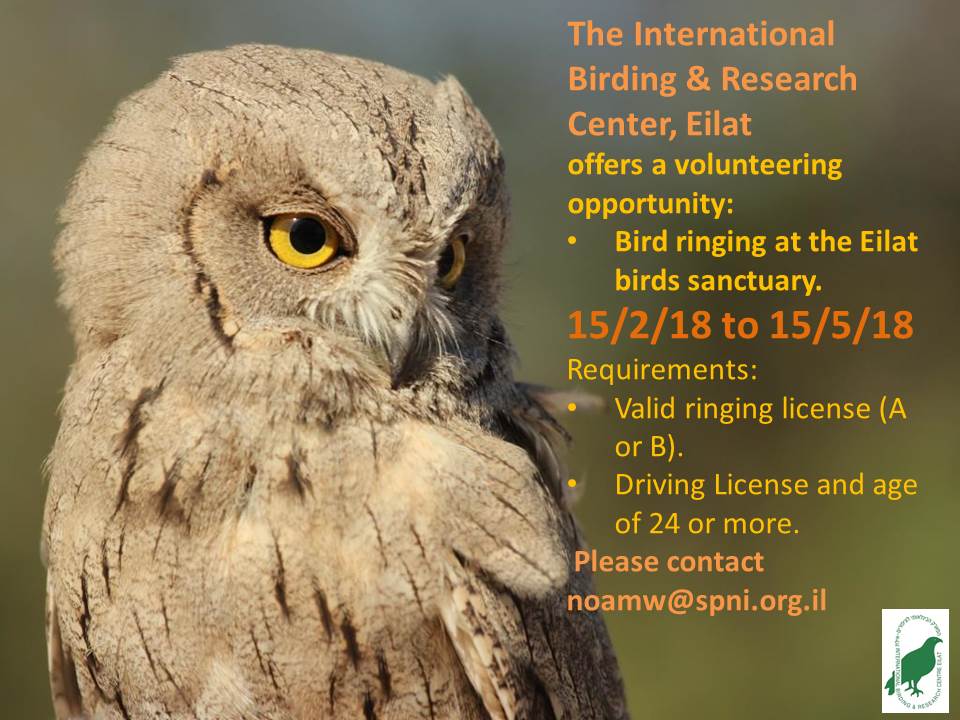 |
| ||||||||||||||||||||||||||||||||||||||||||||||||||||||||||||||||||||||||||||||||||||||||||||||||||||||||||||||||||||||||||||||||||||||||||||||||||||||||||||||||||||||||||||||||||||||||||||||||||||||||||||||||||||||||||||||||||||||||||||||||||||||||||||||||||||||||||||||||||||||||||||||||||||||||||||||||||||||||||||||||||||||||||||||||||||||||||||||||||||||||||||||||||||||||||||||||||||||||||||||||||||||||||||||||||||||||||||||||||||||||||||||||||||||||||||||||||||||||||||||||||||||||||||||||||||||||||||||||||||||||||||||||||||||||||||||||||||||||||||||||||||||||||||||||||||||||||||
A Short History of SAFRING - Part 2 Dieter Oschadleus (2017-09-08) | |||||||||||||||||||||||||||||||||||||||||||||||||||||||||||||||||||||||||||||||||||||||||||||||||||||||||||||||||||||||||||||||||||||||||||||||||||||||||||||||||||||||||||||||||||||||||||||||||||||||||||||||||||||||||||||||||||||||||||||||||||||||||||||||||||||||||||||||||||||||||||||||||||||||||||||||||||||||||||||||||||||||||||||||||||||||||||||||||||||||||||||||||||||||||||||||||||||||||||||||||||||||||||||||||||||||||||||||||||||||||||||||||||||||||||||||||||||||||||||||||||||||||||||||||||||||||||||||||||||||||||||||||||||||||||||||||||||||||||||||||||||||||||||||||||||||||||||
 | The First Ringing Session
To read more on SAFRINGs history please Click Here. | ||||||||||||||||||||||||||||||||||||||||||||||||||||||||||||||||||||||||||||||||||||||||||||||||||||||||||||||||||||||||||||||||||||||||||||||||||||||||||||||||||||||||||||||||||||||||||||||||||||||||||||||||||||||||||||||||||||||||||||||||||||||||||||||||||||||||||||||||||||||||||||||||||||||||||||||||||||||||||||||||||||||||||||||||||||||||||||||||||||||||||||||||||||||||||||||||||||||||||||||||||||||||||||||||||||||||||||||||||||||||||||||||||||||||||||||||||||||||||||||||||||||||||||||||||||||||||||||||||||||||||||||||||||||||||||||||||||||||||||||||||||||||||||||||||||||||||||
A Short History of SAFRING - Part 1 Dane Paijmans and Dieter Oschadleus (2017-09-01) | |||||||||||||||||||||||||||||||||||||||||||||||||||||||||||||||||||||||||||||||||||||||||||||||||||||||||||||||||||||||||||||||||||||||||||||||||||||||||||||||||||||||||||||||||||||||||||||||||||||||||||||||||||||||||||||||||||||||||||||||||||||||||||||||||||||||||||||||||||||||||||||||||||||||||||||||||||||||||||||||||||||||||||||||||||||||||||||||||||||||||||||||||||||||||||||||||||||||||||||||||||||||||||||||||||||||||||||||||||||||||||||||||||||||||||||||||||||||||||||||||||||||||||||||||||||||||||||||||||||||||||||||||||||||||||||||||||||||||||||||||||||||||||||||||||||||||||||
 | The First South African Ring Record!Even at the age of 69, SAFRING is still young in comparison to some of the worlds oldest ringing/banding schemes (British Trust for Ornithology >100 years (1909), Bird Banding Laboratory - Patuxent Wildlife Research Center >90 years (1923), Australian Bird and Bat Banding Scheme >60 years (1953), and EURING > 50 years (1963); which comprises the oldest active ringing schemes (i.e. the Hungarian Ornithological Centre est. 1908)). As a result of these schemes earlier efforts, we have many retrap/recovery records dating back to the early 1900s. The earliest record in our system dates back to 1909 where a White Stork ring was recovered after being shot in KwaZulu-Natal. It had a Hungarian ring 209 which had been put on the stork chick in Romania in the previous year. This was the first scientific evidence of a migrant crossing the equator. Following this recovery there were many more White Stork ring sightings over the following years (Ring: VIB00198 in 1911 from Denmark, Ring: 287 in 1910 from Hungary, Ring: 2199 in 1910 from Hungary, Ring: 2298 in 1909 from Romania). The first sighting of a bird ringed in Britain was a swallow seen in 1911 (Ring: B830). To read more on this sighting please Click Here. To read more on SAFRINGs history please Click Here. | ||||||||||||||||||||||||||||||||||||||||||||||||||||||||||||||||||||||||||||||||||||||||||||||||||||||||||||||||||||||||||||||||||||||||||||||||||||||||||||||||||||||||||||||||||||||||||||||||||||||||||||||||||||||||||||||||||||||||||||||||||||||||||||||||||||||||||||||||||||||||||||||||||||||||||||||||||||||||||||||||||||||||||||||||||||||||||||||||||||||||||||||||||||||||||||||||||||||||||||||||||||||||||||||||||||||||||||||||||||||||||||||||||||||||||||||||||||||||||||||||||||||||||||||||||||||||||||||||||||||||||||||||||||||||||||||||||||||||||||||||||||||||||||||||||||||||||||
It's Our 69th Birthday Dane Paijmans (2017-08-01) | |||||||||||||||||||||||||||||||||||||||||||||||||||||||||||||||||||||||||||||||||||||||||||||||||||||||||||||||||||||||||||||||||||||||||||||||||||||||||||||||||||||||||||||||||||||||||||||||||||||||||||||||||||||||||||||||||||||||||||||||||||||||||||||||||||||||||||||||||||||||||||||||||||||||||||||||||||||||||||||||||||||||||||||||||||||||||||||||||||||||||||||||||||||||||||||||||||||||||||||||||||||||||||||||||||||||||||||||||||||||||||||||||||||||||||||||||||||||||||||||||||||||||||||||||||||||||||||||||||||||||||||||||||||||||||||||||||||||||||||||||||||||||||||||||||||||||||||
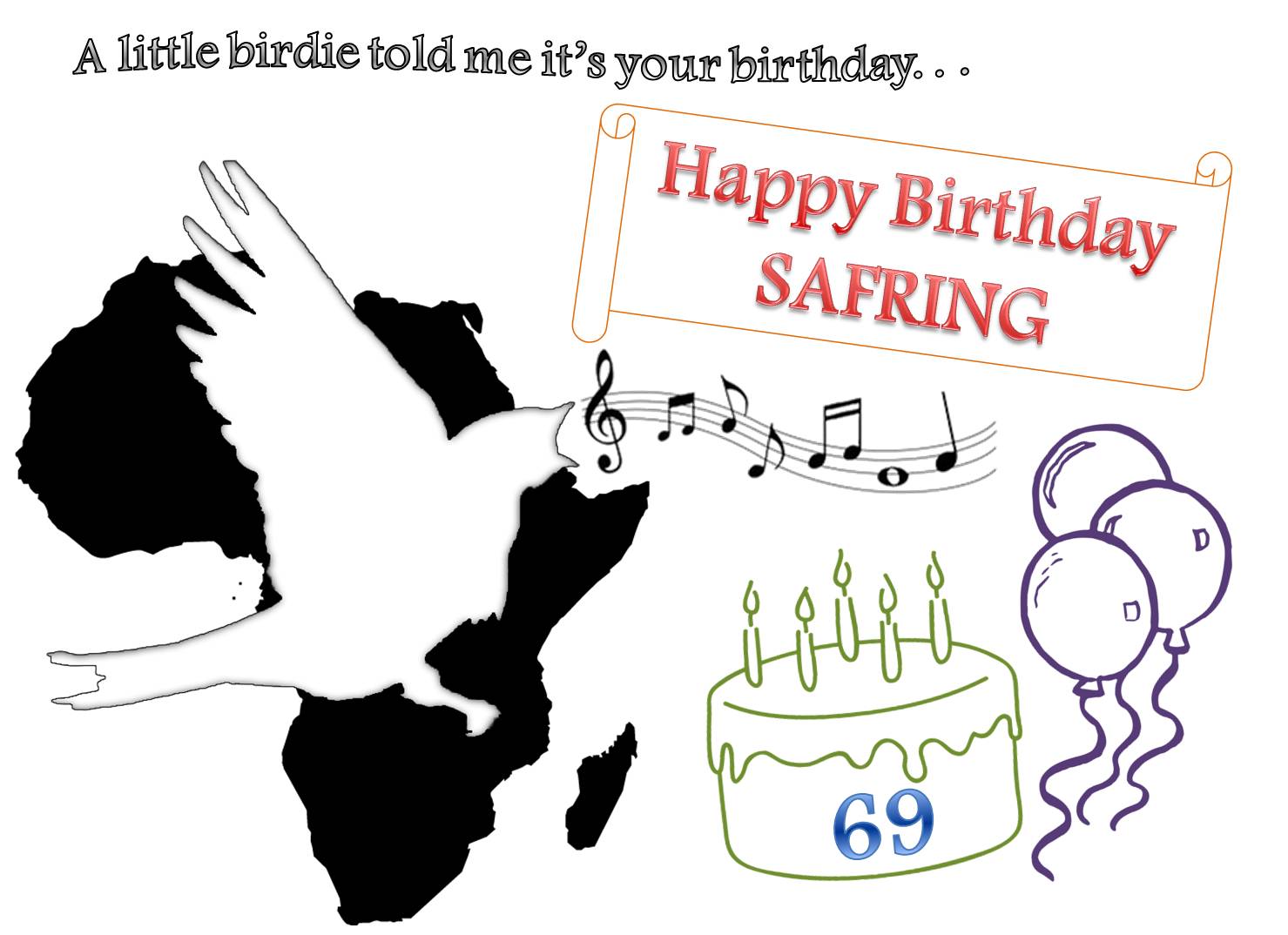 | 2.6 million records and 69 years in, and we are still going strong. From our humble beginnings on August 1st, 1948, when a Cape Vulture chick (Ring: C00086) was ringed at Kransberg in the Transvaal, we have grown and expanded into what we are today.
If you would like to wish us a Happy Birthday and send us a gift; please click on our Donate Link and make a donation to the Stephen Piper Trust and ensure the long-term survival of SAFRING. We at SAFRING really appreciate the ongoing effort of all the ringers and the general public (for reporting resightings/recoveries), and would like to thank everyone that has taken part in ringing and resighting in Southern Africa over the last 69 years. A Big Thank You To Everyone | ||||||||||||||||||||||||||||||||||||||||||||||||||||||||||||||||||||||||||||||||||||||||||||||||||||||||||||||||||||||||||||||||||||||||||||||||||||||||||||||||||||||||||||||||||||||||||||||||||||||||||||||||||||||||||||||||||||||||||||||||||||||||||||||||||||||||||||||||||||||||||||||||||||||||||||||||||||||||||||||||||||||||||||||||||||||||||||||||||||||||||||||||||||||||||||||||||||||||||||||||||||||||||||||||||||||||||||||||||||||||||||||||||||||||||||||||||||||||||||||||||||||||||||||||||||||||||||||||||||||||||||||||||||||||||||||||||||||||||||||||||||||||||||||||||||||||||||
2016/17 Migrating White Stork (Ciconia ciconia) Summary Dane Paijmans (2017-07-27) | |||||||||||||||||||||||||||||||||||||||||||||||||||||||||||||||||||||||||||||||||||||||||||||||||||||||||||||||||||||||||||||||||||||||||||||||||||||||||||||||||||||||||||||||||||||||||||||||||||||||||||||||||||||||||||||||||||||||||||||||||||||||||||||||||||||||||||||||||||||||||||||||||||||||||||||||||||||||||||||||||||||||||||||||||||||||||||||||||||||||||||||||||||||||||||||||||||||||||||||||||||||||||||||||||||||||||||||||||||||||||||||||||||||||||||||||||||||||||||||||||||||||||||||||||||||||||||||||||||||||||||||||||||||||||||||||||||||||||||||||||||||||||||||||||||||||||||||
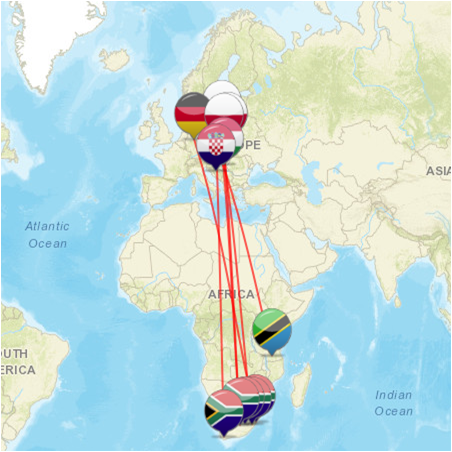 | White Storks are commonly seen migrants during our summer months, flying south once breeding or fledging in Europe and North Africa (with ringed individuals being sighted since 1909). After receiving an interesting stork resighting from the top of Sani Pass, by citizen scientist Doggy Kewley (Polish Ring: PLG04P23), I thought it appropriate to summaries some of our recent foreign visitors. SAFRING has received a total of 1,843 White Stork ring records (953 initial, 214 retrap/resighting and 676 recoveries). These are predominantly made up of foreign ringed birds; with 1,650 being foreign (804 initial, 182 retrap/resightings and 664 recoveries), and only 193 being SAFRING records (149 initial, 32 retrap/resighting and 12 recoveries). Most of these foreign records were generated when SAFRING received recovery reports of deceased storks found in South Africa (78 % of cases), with only 22% being reported as a result of live resightings. Through the use of inscribed hexagonal (ELSA) rings, resightings are increasing in recent years. These are easily seen while in the field and offer significantly more detail than conventional colour rings. In an attempt to discover the migration routes of these species, 60 registered studies monitored by 28 ringing schemes, ring 100s of chicks across most European countries each breeding season, and have discovered some interesting movement patterns. The greatest distance between two sightings of a White Stork in our database is 10 114 km (from Lading, Denmark to Alexandria Beach, Eastern Cape; Ring: VIB00465). Most adult White Stork ringing and all chick ringing in South Africa has been done in Bredasdorp, Western Cape as this is the only area they are known to breed. Some of the interesting reports from the 2016/17 migration are as follows; Ring: HN941 – Initially ringed as a chick in Germany on May 26th, 2015, and recovered August 3rd, 2016 in Kamberg, KwaZulu-Natal. Ring: 8P560 – Initially ringed as a chick in Poland on June 13th, 2016, and recovered December 15th, 2016 in the Freestate. Ring: TA12113 – Initially ringed as a chick in Croatia on June 17th, 2016, and resighted January 5th, 2017 in Laaiplaats, Western Cape. Ring: PLG04P23 – Initially ringed as a chick in Poland on June 27th, 2016, and resighted January 23rd, 2017 on Sani Pass. Ring: PH06766 – Initially ringed as a chick in Hungary on July 11th, 2014, and recovered January 26th, 2017 in Ludewa district, Tanzania. Ring: PLG2P399 – Initially ringed as a chick in Poland on June 1st, 2010, and sighted February 6th, 2017 in Bultfontein, Freestate. To help with these studies please keep a lookout for ringed White Storks in your areas. These are likely seen between September and March as these are the months most foreign birds will likely be in South Africa. If you do see one please contact us at SAFRING with the details and photos, and be sure to record the full ring number. We at SAFRING really appreciate all the effort of ringers and the general public (the latter in reporting recoveries), and would like to thank everyone that has taken part in ringing and resighting in Southern Africa | ||||||||||||||||||||||||||||||||||||||||||||||||||||||||||||||||||||||||||||||||||||||||||||||||||||||||||||||||||||||||||||||||||||||||||||||||||||||||||||||||||||||||||||||||||||||||||||||||||||||||||||||||||||||||||||||||||||||||||||||||||||||||||||||||||||||||||||||||||||||||||||||||||||||||||||||||||||||||||||||||||||||||||||||||||||||||||||||||||||||||||||||||||||||||||||||||||||||||||||||||||||||||||||||||||||||||||||||||||||||||||||||||||||||||||||||||||||||||||||||||||||||||||||||||||||||||||||||||||||||||||||||||||||||||||||||||||||||||||||||||||||||||||||||||||||||||||||
Exciting Russian Western Osprey Pandion haliaetus resighting near Kleinmond, Western Cape and a brief overview of P. haliaetus migration in Africa. Sanjo Rose (2017-05-23) | |||||||||||||||||||||||||||||||||||||||||||||||||||||||||||||||||||||||||||||||||||||||||||||||||||||||||||||||||||||||||||||||||||||||||||||||||||||||||||||||||||||||||||||||||||||||||||||||||||||||||||||||||||||||||||||||||||||||||||||||||||||||||||||||||||||||||||||||||||||||||||||||||||||||||||||||||||||||||||||||||||||||||||||||||||||||||||||||||||||||||||||||||||||||||||||||||||||||||||||||||||||||||||||||||||||||||||||||||||||||||||||||||||||||||||||||||||||||||||||||||||||||||||||||||||||||||||||||||||||||||||||||||||||||||||||||||||||||||||||||||||||||||||||||||||||||||||||
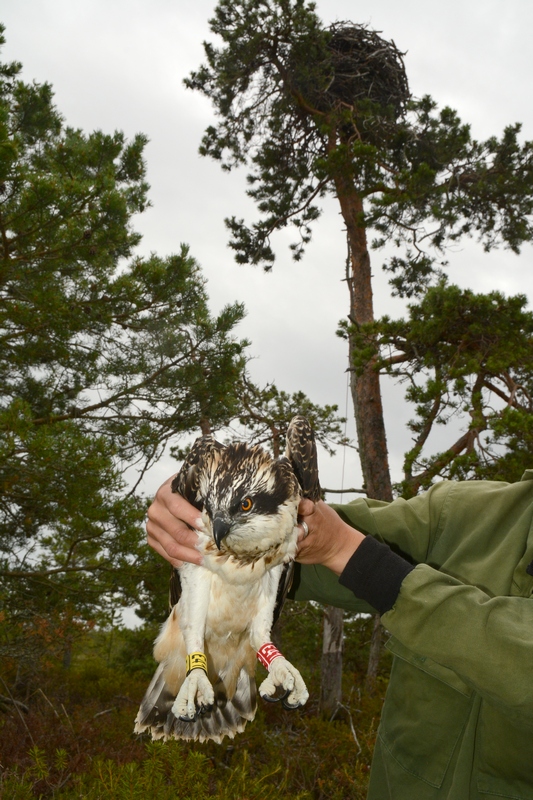 | Figure 1. Ringing of YE41RE41 at Onezhskoe Lake, Russia. Photo by Miroslav Babushkin. Western Ospreys Pandion haliaetus are Palearctic migrants that breed in the northern hemisphere and over-winter predominantly in West Africa, and to a lesser extent, in southern Africa (Kjellen et al., 1997, Hake et al., 2001). Each year large numbers of Osprey chicks are ringed by European, Scandinavian and Russian ringing schemes. Over 15 000 chicks since 1995 in Sweden alone (Hake et al., 2001), yet resightings of ringed individuals are rare in their overwintering grounds. For example, only 29 ringed individuals have been reported to the South African Bird Ringing Scheme (SAFRING) since 1972 (SAFRING database accessed on 5th of May 2017) from around Africa. A number of traits contribute to these poor ‘recapture’ rates: Ospreys are considered ‘broad-front migrants’ (Osterlof 1977) meaning that they tend not to migrate in concentrated groups, which means that individuals can easily be over-looked. They travel rapidly and tend not to strictly follow thermal conditions (Kjellen et al., 1997) and some individuals appear to prefer travelling at night (Vali and Sellis, 2016). Although little is known, the few studies that have explored migratory behaviour have made interesting discoveries. Ospreys travel fast, averaging 270km per day (Kjellen et al., 1997) with a maximum of 763km reported by Vali and Sellis (2016). GPS-tagged Estonian females left breeding grounds late July to mid-August, leaving males to finish rearing chicks, and return journeys starting from late February-mid March (Vali and Sellis 2016). The authors also showed that individuals were relatively faithful to their overwintering sites but that the location of sites varied a lot between individuals. Their conclusions were based on four radio-tagged Estonian Ospreys over approximately six migration seasons. Hake et al. (2001) provided further insight into the movement of 13 Ospreys: adults showed high site fidelity and tend to stay within 10km from a central spot (Prevost 1982; Hake et al., 2001) whilst juveniles roamed wider. Hake et al. (2001) suggested that juvenile roaming could be the result of the best sites having been selected by adults. Potentially, the low migration densities and inconsistent use of thermals could result from a need to reduce foraging competition caused by their almost exclusively piscivorous diet (Kjellen et al., 1997). Recently, a resighting was reported to SAFRING of a Russian Osprey. This young bird was first ringed as a juvenile on the 11th of July 2015. Subsequently it had been seen in South Africa in the West Coast National Park 33°07’48.0”S 18°05’24.0”E on the 13th of February 2016 by Michael Buckham and Rooisand Nature Reserve, Kleinmond 34°21’35.4”S 19°05’40.5”E on the 30th of April 2017 by Carin Malan. It is the first Russian individual to be recorded in South Africa. Two colour rings: yellow E41 on the right leg and red E41 on the left leg allowed for confident positive identification of the individual (http://safring.adu.org.za/ring_info.php?ring=YE41RE41&project=FOREIGN_RUP). Originally ringed the vicinity of Onezhskoe Lake in the Vologda region this individual would have travelled at least 10 500 km in one direction this year alone. There was a second unringed individual in the vicinity. It is interesting that both sightings were in protected areas and in localities that are relatively far apart (approximately 200km). This supports a previous suggestion that juveniles need a couple of seasons to select a site (Hake et al., 2001), either as a result of inexperience or because of competition with adults.
Figure 2. YE41RE41 at Rooisand Nature Reserve, South Africa. Photo by Carin Malan. These were exciting records for South Africa and hopefully the first of many more which will hopefully lead to a better understanding of migratory dynamics in this species. .
References: Hake, M., Kjellén, N. & Alerstam, T. 2001, "Satellite Tracking of Swedish Ospreys Pandion haliaetus: Autumn Migration Routes and Orientation", Journal of Avian Biology, vol. 32, no. 1, pp. 47-56. Kjellen N, Hake M, Alerstam T 1997. Strategies of two Osprey Pandion haliaetus migrating between Sweden and tropical Africa as revealed by satellite tracking. Journal of Avian Biology 28(1): 15-23. Österlöf, S. 1977, "Migration, Wintering Areas, and Site Tenacity of the European Osprey Pandion h. haliaetus (L.)", Ornis Scandinavica (Scandinavian Journal of Ornithology), vol. 8, no. 1, pp. 61-78. Prevost, Y.A. 1982, Wintering ecology of ospreys in Senegambia, PhD edn, The University of Edinburgh. Vali, U. & Sellis, U. 2016, "Migration patterns of the Osprey Pandion haliaetus on the Eastern European-East African flyway.” Ostrich, vol. 87, no. 1, pp. 23-28.
| ||||||||||||||||||||||||||||||||||||||||||||||||||||||||||||||||||||||||||||||||||||||||||||||||||||||||||||||||||||||||||||||||||||||||||||||||||||||||||||||||||||||||||||||||||||||||||||||||||||||||||||||||||||||||||||||||||||||||||||||||||||||||||||||||||||||||||||||||||||||||||||||||||||||||||||||||||||||||||||||||||||||||||||||||||||||||||||||||||||||||||||||||||||||||||||||||||||||||||||||||||||||||||||||||||||||||||||||||||||||||||||||||||||||||||||||||||||||||||||||||||||||||||||||||||||||||||||||||||||||||||||||||||||||||||||||||||||||||||||||||||||||||||||||||||||||||||||
Ringed "Elegant" Tern in Rooi Els Dane Paijmans (2017-03-16) | |||||||||||||||||||||||||||||||||||||||||||||||||||||||||||||||||||||||||||||||||||||||||||||||||||||||||||||||||||||||||||||||||||||||||||||||||||||||||||||||||||||||||||||||||||||||||||||||||||||||||||||||||||||||||||||||||||||||||||||||||||||||||||||||||||||||||||||||||||||||||||||||||||||||||||||||||||||||||||||||||||||||||||||||||||||||||||||||||||||||||||||||||||||||||||||||||||||||||||||||||||||||||||||||||||||||||||||||||||||||||||||||||||||||||||||||||||||||||||||||||||||||||||||||||||||||||||||||||||||||||||||||||||||||||||||||||||||||||||||||||||||||||||||||||||||||||||||
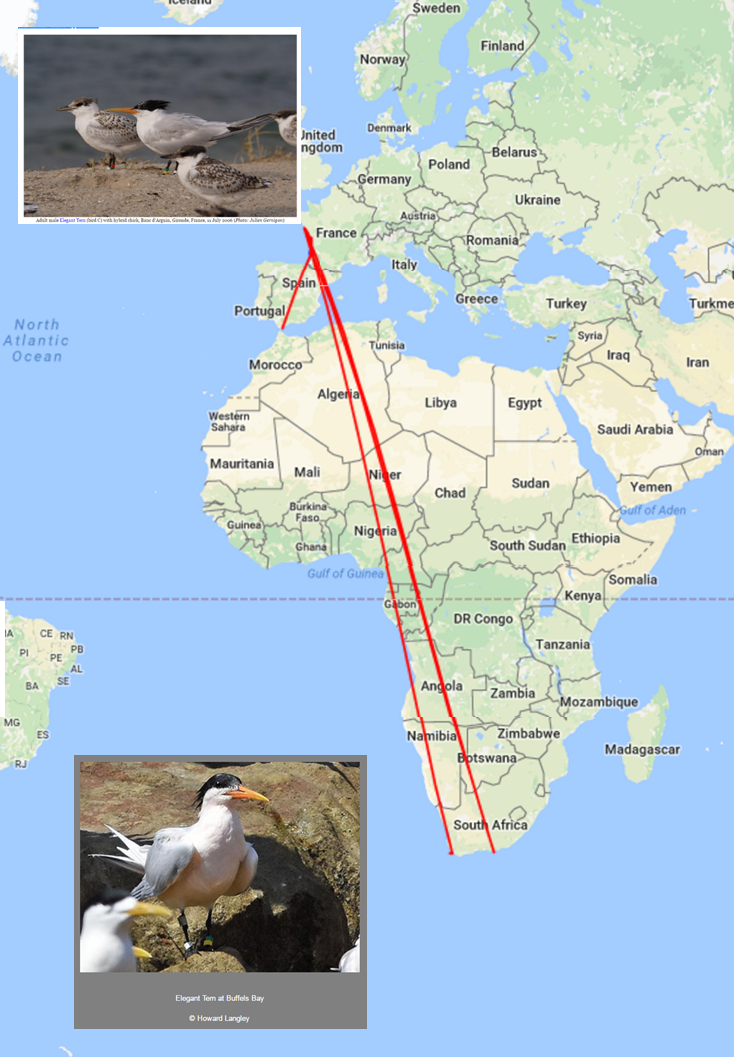 | If you haven't been keeping up to date with Trevor Hardakers Rare Bird News Report (Facebook Group, Google Group) then the recent Elegant Tern (Thalasseus elegans) sightings may come as a surprise, and it is likely you have already missed out on a chance to view these two individuals. As one of the birds seen at Rooi Els, Western Cape was colour ringed, I thought it would be interesting to take a look at some of the details discovered.
| ||||||||||||||||||||||||||||||||||||||||||||||||||||||||||||||||||||||||||||||||||||||||||||||||||||||||||||||||||||||||||||||||||||||||||||||||||||||||||||||||||||||||||||||||||||||||||||||||||||||||||||||||||||||||||||||||||||||||||||||||||||||||||||||||||||||||||||||||||||||||||||||||||||||||||||||||||||||||||||||||||||||||||||||||||||||||||||||||||||||||||||||||||||||||||||||||||||||||||||||||||||||||||||||||||||||||||||||||||||||||||||||||||||||||||||||||||||||||||||||||||||||||||||||||||||||||||||||||||||||||||||||||||||||||||||||||||||||||||||||||||||||||||||||||||||||||||||
Top ringer: Ursula Franke-Bryson Dieter Oschadleus (2017-02-10) | |||||||||||||||||||||||||||||||||||||||||||||||||||||||||||||||||||||||||||||||||||||||||||||||||||||||||||||||||||||||||||||||||||||||||||||||||||||||||||||||||||||||||||||||||||||||||||||||||||||||||||||||||||||||||||||||||||||||||||||||||||||||||||||||||||||||||||||||||||||||||||||||||||||||||||||||||||||||||||||||||||||||||||||||||||||||||||||||||||||||||||||||||||||||||||||||||||||||||||||||||||||||||||||||||||||||||||||||||||||||||||||||||||||||||||||||||||||||||||||||||||||||||||||||||||||||||||||||||||||||||||||||||||||||||||||||||||||||||||||||||||||||||||||||||||||||||||||
 | Ursula started ringing in South Africa in 2002, after many training sessions at Wakkerstroom and with individual ringers. Ursula and her husband Tom live in Germany but spend a lot of their time in southern Africa, especially Namibia. She has now ringed over 50000 birds in Africa, probably more than any other single ringer. Barberspan and Ocean and Coasts teams have ringed a lot more than this, but we do not know the totals for individual team members. Ursula has ringed 518 species in African countries, and this number is only surpassed by Malcolm Wilson. Ursula’s top species is the Lark-like Bunting with over 11000 ringed, followed by Cape Sparrow. Ursula has also supported SAFRING with many financial donations over the years. Ringing is not a competition for most birds or species ringed, and we value all data. However, Ursula’s achievement deserves recognition. | ||||||||||||||||||||||||||||||||||||||||||||||||||||||||||||||||||||||||||||||||||||||||||||||||||||||||||||||||||||||||||||||||||||||||||||||||||||||||||||||||||||||||||||||||||||||||||||||||||||||||||||||||||||||||||||||||||||||||||||||||||||||||||||||||||||||||||||||||||||||||||||||||||||||||||||||||||||||||||||||||||||||||||||||||||||||||||||||||||||||||||||||||||||||||||||||||||||||||||||||||||||||||||||||||||||||||||||||||||||||||||||||||||||||||||||||||||||||||||||||||||||||||||||||||||||||||||||||||||||||||||||||||||||||||||||||||||||||||||||||||||||||||||||||||||||||||||||
Estonian Osprey in KwaZulu-Natal Dane Paijmans (2017-02-06) | |||||||||||||||||||||||||||||||||||||||||||||||||||||||||||||||||||||||||||||||||||||||||||||||||||||||||||||||||||||||||||||||||||||||||||||||||||||||||||||||||||||||||||||||||||||||||||||||||||||||||||||||||||||||||||||||||||||||||||||||||||||||||||||||||||||||||||||||||||||||||||||||||||||||||||||||||||||||||||||||||||||||||||||||||||||||||||||||||||||||||||||||||||||||||||||||||||||||||||||||||||||||||||||||||||||||||||||||||||||||||||||||||||||||||||||||||||||||||||||||||||||||||||||||||||||||||||||||||||||||||||||||||||||||||||||||||||||||||||||||||||||||||||||||||||||||||||||
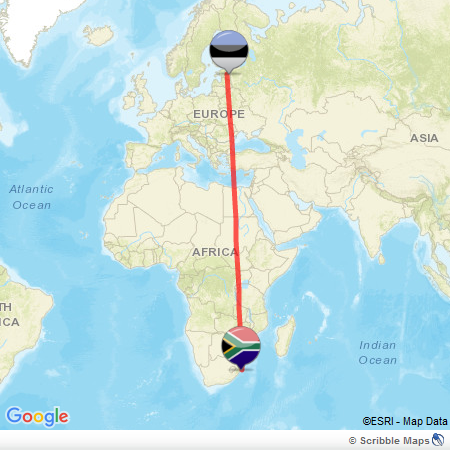 | We received an interesting recovery recently from one of our ADU members; Frank Rautenbach. This sighting is not only interesting due to it being one of only a few Osprey (Pandion haliaetus) records, but also due the fact that this is the first SAFRING recorded Osprey from Estonia.
| ||||||||||||||||||||||||||||||||||||||||||||||||||||||||||||||||||||||||||||||||||||||||||||||||||||||||||||||||||||||||||||||||||||||||||||||||||||||||||||||||||||||||||||||||||||||||||||||||||||||||||||||||||||||||||||||||||||||||||||||||||||||||||||||||||||||||||||||||||||||||||||||||||||||||||||||||||||||||||||||||||||||||||||||||||||||||||||||||||||||||||||||||||||||||||||||||||||||||||||||||||||||||||||||||||||||||||||||||||||||||||||||||||||||||||||||||||||||||||||||||||||||||||||||||||||||||||||||||||||||||||||||||||||||||||||||||||||||||||||||||||||||||||||||||||||||||||||
New longevity record for the Red-winged Starling Dane Paijmans (2016-11-22) | |||||||||||||||||||||||||||||||||||||||||||||||||||||||||||||||||||||||||||||||||||||||||||||||||||||||||||||||||||||||||||||||||||||||||||||||||||||||||||||||||||||||||||||||||||||||||||||||||||||||||||||||||||||||||||||||||||||||||||||||||||||||||||||||||||||||||||||||||||||||||||||||||||||||||||||||||||||||||||||||||||||||||||||||||||||||||||||||||||||||||||||||||||||||||||||||||||||||||||||||||||||||||||||||||||||||||||||||||||||||||||||||||||||||||||||||||||||||||||||||||||||||||||||||||||||||||||||||||||||||||||||||||||||||||||||||||||||||||||||||||||||||||||||||||||||||||||||
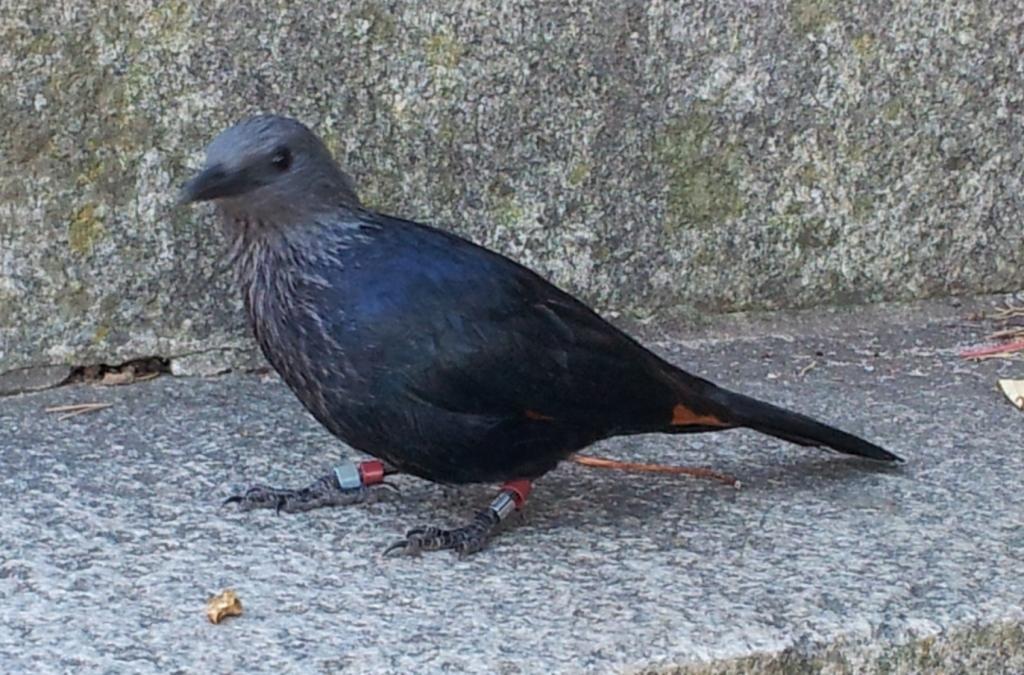 |
A resighting of an old colour ringed Red-winged Starling (Onychognathus morio) (age: 18y 2m; ring number: D22802) (seen in the photo) was made near our offices here at UCT early last year. At the time I was a little apprehensive on verifying this record. Even though the colour ring combination was clear and easily matched to the individual, I was only able to see a few of the metal ring digits. Being that this would have been a new longevity at the time and that most colour rings do not last this long, I marked this individual as an unconfirmed sighting. Earlier this year the sighting was substantiated however when an older recovery (our new longevity) was reported with similar colour rings (a different combination).
| ||||||||||||||||||||||||||||||||||||||||||||||||||||||||||||||||||||||||||||||||||||||||||||||||||||||||||||||||||||||||||||||||||||||||||||||||||||||||||||||||||||||||||||||||||||||||||||||||||||||||||||||||||||||||||||||||||||||||||||||||||||||||||||||||||||||||||||||||||||||||||||||||||||||||||||||||||||||||||||||||||||||||||||||||||||||||||||||||||||||||||||||||||||||||||||||||||||||||||||||||||||||||||||||||||||||||||||||||||||||||||||||||||||||||||||||||||||||||||||||||||||||||||||||||||||||||||||||||||||||||||||||||||||||||||||||||||||||||||||||||||||||||||||||||||||||||||||
Longevity record for the Bearded Vulture Dane Paijmans (2016-11-10) | |||||||||||||||||||||||||||||||||||||||||||||||||||||||||||||||||||||||||||||||||||||||||||||||||||||||||||||||||||||||||||||||||||||||||||||||||||||||||||||||||||||||||||||||||||||||||||||||||||||||||||||||||||||||||||||||||||||||||||||||||||||||||||||||||||||||||||||||||||||||||||||||||||||||||||||||||||||||||||||||||||||||||||||||||||||||||||||||||||||||||||||||||||||||||||||||||||||||||||||||||||||||||||||||||||||||||||||||||||||||||||||||||||||||||||||||||||||||||||||||||||||||||||||||||||||||||||||||||||||||||||||||||||||||||||||||||||||||||||||||||||||||||||||||||||||||||||||
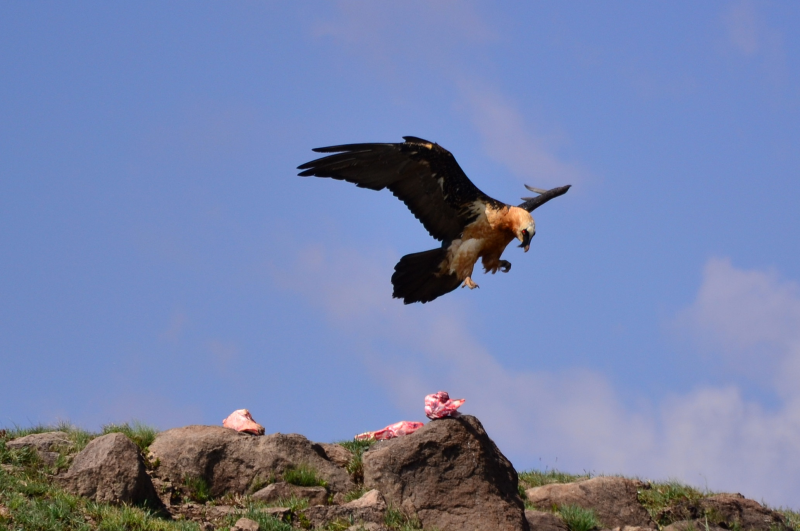 |
A record previously overlooked during our vulture longevity stories was that of the Bearded Vulture (Gypaetus barbatus). The SAFRING database has only 47 records in total for this species, and of these there is only one retrap/recovery (this longevity record). This low record number is understandable owing to an estimated population of only 100 breeding pairs in South Africa. The global population is estimated at 2000-10000 individuals (an estimated 1,300-6,700 mature individuals) [ref]. As a result of this low global population and the current decline in numbers this species is listed as Near Threatened by the IUCN. The major factors in this decline are reduced food availability, persecution, power line/ wind turbine collisions and poisoning.
| ||||||||||||||||||||||||||||||||||||||||||||||||||||||||||||||||||||||||||||||||||||||||||||||||||||||||||||||||||||||||||||||||||||||||||||||||||||||||||||||||||||||||||||||||||||||||||||||||||||||||||||||||||||||||||||||||||||||||||||||||||||||||||||||||||||||||||||||||||||||||||||||||||||||||||||||||||||||||||||||||||||||||||||||||||||||||||||||||||||||||||||||||||||||||||||||||||||||||||||||||||||||||||||||||||||||||||||||||||||||||||||||||||||||||||||||||||||||||||||||||||||||||||||||||||||||||||||||||||||||||||||||||||||||||||||||||||||||||||||||||||||||||||||||||||||||||||||
New longevity record for the Rock Kestrel Dane Paijmans (2016-10-14) | |||||||||||||||||||||||||||||||||||||||||||||||||||||||||||||||||||||||||||||||||||||||||||||||||||||||||||||||||||||||||||||||||||||||||||||||||||||||||||||||||||||||||||||||||||||||||||||||||||||||||||||||||||||||||||||||||||||||||||||||||||||||||||||||||||||||||||||||||||||||||||||||||||||||||||||||||||||||||||||||||||||||||||||||||||||||||||||||||||||||||||||||||||||||||||||||||||||||||||||||||||||||||||||||||||||||||||||||||||||||||||||||||||||||||||||||||||||||||||||||||||||||||||||||||||||||||||||||||||||||||||||||||||||||||||||||||||||||||||||||||||||||||||||||||||||||||||||
 |
A new longevity record was recently reported for the Rock Kestrel (Falco rupicolus). This individual was resighted most recently by its initial ringer Dr Anthony Van Zyl. It was seen on September 25th, 2016 in the same quarry (Dorstberg Quarry) it was ringed in; on June 17th, 2007. As this individual was initially ringed as an adult and was last seen alive; it would likely be older than the calculated age of 9 years 3 months and 13 days. This Rock Kestrel was ringed as part of a study looking at the population dynamics of the Rock Kestrel on the Cape Peninsula and forms part of the Migrating Kestrel Project; one of the projects run by the Birds of Prey Working Group, Endangered Wildlife Trust. At her last sighting she doing well and was incubating eggs in the quarry. As she was colour ringed during the initial ringing (Black over Green) she is easily distinguished and has been seen on one other occasion near Spes Bona Road, Durbanville on the January 9th, 2016 by Cathy Kent. There are a number of other individuals in our database aged at ±8 years old (one of which is reported in Roberts 7). As many individuals were colour ringed at a similar time, please keep an eye out for them so that we can expect to see other records soon.
| ||||||||||||||||||||||||||||||||||||||||||||||||||||||||||||||||||||||||||||||||||||||||||||||||||||||||||||||||||||||||||||||||||||||||||||||||||||||||||||||||||||||||||||||||||||||||||||||||||||||||||||||||||||||||||||||||||||||||||||||||||||||||||||||||||||||||||||||||||||||||||||||||||||||||||||||||||||||||||||||||||||||||||||||||||||||||||||||||||||||||||||||||||||||||||||||||||||||||||||||||||||||||||||||||||||||||||||||||||||||||||||||||||||||||||||||||||||||||||||||||||||||||||||||||||||||||||||||||||||||||||||||||||||||||||||||||||||||||||||||||||||||||||||||||||||||||||||
New longevity record for the Lappet-Faced Vulture Sarah Catto (2016-09-23) | |||||||||||||||||||||||||||||||||||||||||||||||||||||||||||||||||||||||||||||||||||||||||||||||||||||||||||||||||||||||||||||||||||||||||||||||||||||||||||||||||||||||||||||||||||||||||||||||||||||||||||||||||||||||||||||||||||||||||||||||||||||||||||||||||||||||||||||||||||||||||||||||||||||||||||||||||||||||||||||||||||||||||||||||||||||||||||||||||||||||||||||||||||||||||||||||||||||||||||||||||||||||||||||||||||||||||||||||||||||||||||||||||||||||||||||||||||||||||||||||||||||||||||||||||||||||||||||||||||||||||||||||||||||||||||||||||||||||||||||||||||||||||||||||||||||||||||||
 | A great sighting was recently reported to us from Coen van den Berg, who spotted a number of ringed and/or tagged vultures feeding on a Zebra carcass at Sable Dam in Kruger National Park. Among these birds was a Lappet-Faced Vulture with a SAFRING ring (G19378) who was initially ringed as a nestling by Dr Pat Benson on October 23rd, 1992. Coen saw the individual on the 2nd September 2016, meaning this bird is nearly 24 years old! SAFRING's previous longevity record for the Lappet-Faced Vulture was just under 10 years in the wild (Ring: G00247), and Roberts' maximum longevity is 23 years for a captive bird. So this was an exciting record for us, oustripping both of these and with the possibility of further extension in age. This bird was initially fitted with wing tags which have since come off, and it was only through Coen's great photography and a bit of luck that the ring number was legible. If you feel you know of an older record for Lappet-Faced Vultures, please contact us at SAFRING with the details. The great photo accompanying this article is accredited to Coen van den Berg and was linked from BirdPix. | ||||||||||||||||||||||||||||||||||||||||||||||||||||||||||||||||||||||||||||||||||||||||||||||||||||||||||||||||||||||||||||||||||||||||||||||||||||||||||||||||||||||||||||||||||||||||||||||||||||||||||||||||||||||||||||||||||||||||||||||||||||||||||||||||||||||||||||||||||||||||||||||||||||||||||||||||||||||||||||||||||||||||||||||||||||||||||||||||||||||||||||||||||||||||||||||||||||||||||||||||||||||||||||||||||||||||||||||||||||||||||||||||||||||||||||||||||||||||||||||||||||||||||||||||||||||||||||||||||||||||||||||||||||||||||||||||||||||||||||||||||||||||||||||||||||||||||||
SAFRING Longevity record of the Glossy Ibis Dane Paijmans (2016-08-30) | |||||||||||||||||||||||||||||||||||||||||||||||||||||||||||||||||||||||||||||||||||||||||||||||||||||||||||||||||||||||||||||||||||||||||||||||||||||||||||||||||||||||||||||||||||||||||||||||||||||||||||||||||||||||||||||||||||||||||||||||||||||||||||||||||||||||||||||||||||||||||||||||||||||||||||||||||||||||||||||||||||||||||||||||||||||||||||||||||||||||||||||||||||||||||||||||||||||||||||||||||||||||||||||||||||||||||||||||||||||||||||||||||||||||||||||||||||||||||||||||||||||||||||||||||||||||||||||||||||||||||||||||||||||||||||||||||||||||||||||||||||||||||||||||||||||||||||||
 |
After calculating the longevities of two of the South Africa ibis species, I figured that I ought to do the rest as well. This week I will be looking at the Glossy Ibis (Plegadis falcinellus). Similar to the African Sacred and Hadeda Ibis, this record has been held for many years (1988; Ring: 710876). The individual was initially ringed on December 4th, 1971 and recovered on April 1st, 1988. The individual was found at Brakpan Dam (by a member of public; Pieter Potgieter), 9 km from its intial ringing/ hatching site at Westdene Pan, Benoni. As this individual was ringed as a chick it would not have been much older than the calculated age of 16 years 4 months. The cause of death is unknown as no details were reported at the time. As this species is known to occur in many parts of the world, I was able to find a greater longevity record from the United States of America (21 years Ref ). Greater yet was a captive bred individual that was reported to have reached 26 years 9 months and 26 days Ref.
If you feel you know of an older record please contact us at SAFRING with the details.
| ||||||||||||||||||||||||||||||||||||||||||||||||||||||||||||||||||||||||||||||||||||||||||||||||||||||||||||||||||||||||||||||||||||||||||||||||||||||||||||||||||||||||||||||||||||||||||||||||||||||||||||||||||||||||||||||||||||||||||||||||||||||||||||||||||||||||||||||||||||||||||||||||||||||||||||||||||||||||||||||||||||||||||||||||||||||||||||||||||||||||||||||||||||||||||||||||||||||||||||||||||||||||||||||||||||||||||||||||||||||||||||||||||||||||||||||||||||||||||||||||||||||||||||||||||||||||||||||||||||||||||||||||||||||||||||||||||||||||||||||||||||||||||||||||||||||||||||
Longevity record of the Hadeda Ibis Dane Paijmans (2016-08-19) | |||||||||||||||||||||||||||||||||||||||||||||||||||||||||||||||||||||||||||||||||||||||||||||||||||||||||||||||||||||||||||||||||||||||||||||||||||||||||||||||||||||||||||||||||||||||||||||||||||||||||||||||||||||||||||||||||||||||||||||||||||||||||||||||||||||||||||||||||||||||||||||||||||||||||||||||||||||||||||||||||||||||||||||||||||||||||||||||||||||||||||||||||||||||||||||||||||||||||||||||||||||||||||||||||||||||||||||||||||||||||||||||||||||||||||||||||||||||||||||||||||||||||||||||||||||||||||||||||||||||||||||||||||||||||||||||||||||||||||||||||||||||||||||||||||||||||||||
 |
Continuing on with our ibis longevities, I thought we could take a look at my personal 3 am alarm clock; the Hadeda Ibis (Bostrychia hagedash). The longevity record calculated for this species is another older one from 1999 (Ring: 836378). This individual was initially ringed on February 20th, 1989 and recovered on July 11th, 1999. It was initially ringed as a juvenile at CROW (Centre for Rehabilitation of Wildlife) in Yellowwood Park, KZN. After being attacked by a dog, it was then returned to CROW over ten years later. Through some great work and effort it was rehabilitated and released back into the wild. Since its release this individual has not been reported again. The next oldest individual we have record of reached 9 years old, with a number of other records falling into this similar age group. As a fair number of chicks have been ringed since 2006, for a colour ringing project in the southern suburbs, Cape Town (Colour-ringing of Hadeda Ibis on the Cape Peninsula), there should be more decade old individuals appearing, and this longevity may soon be bested.
| ||||||||||||||||||||||||||||||||||||||||||||||||||||||||||||||||||||||||||||||||||||||||||||||||||||||||||||||||||||||||||||||||||||||||||||||||||||||||||||||||||||||||||||||||||||||||||||||||||||||||||||||||||||||||||||||||||||||||||||||||||||||||||||||||||||||||||||||||||||||||||||||||||||||||||||||||||||||||||||||||||||||||||||||||||||||||||||||||||||||||||||||||||||||||||||||||||||||||||||||||||||||||||||||||||||||||||||||||||||||||||||||||||||||||||||||||||||||||||||||||||||||||||||||||||||||||||||||||||||||||||||||||||||||||||||||||||||||||||||||||||||||||||||||||||||||||||||
Longevity record of the African Sacred Ibis Dane Paijmans (2016-08-11) | |||||||||||||||||||||||||||||||||||||||||||||||||||||||||||||||||||||||||||||||||||||||||||||||||||||||||||||||||||||||||||||||||||||||||||||||||||||||||||||||||||||||||||||||||||||||||||||||||||||||||||||||||||||||||||||||||||||||||||||||||||||||||||||||||||||||||||||||||||||||||||||||||||||||||||||||||||||||||||||||||||||||||||||||||||||||||||||||||||||||||||||||||||||||||||||||||||||||||||||||||||||||||||||||||||||||||||||||||||||||||||||||||||||||||||||||||||||||||||||||||||||||||||||||||||||||||||||||||||||||||||||||||||||||||||||||||||||||||||||||||||||||||||||||||||||||||||||
 |
After recieving an interesting African Sacred Ibis (Threskiornis aethiopicus) recovery, I decided to take a look at the longevity records of this species. The record calculated is an old one from 1974 (Ring: 52601770). The individual was initially ringed on December 20th, 1952 and recovered on January 26th, 1974. This individual was found at Aasvoelkrans, Rustenburg, 134 km from its intial ringing/ hatching site; Modderdam, Benoni. As this individual was ringed as a chick it would not have been much older than the calculated record (21y 1m 12d). The death of this individual was caused by a collision with a wire so it may have still reached an older age if it had died naturally. The next oldest individual reached 16 years old, with a number of other records exceeding 15 years. As a large number of chicks have been ringed over the years through colour ringing projects (such as the Robben Island Colour Ringing Project) there may be many more "old" individuals still out there waiting to be seen.
If you feel you know of an older record please contact us at SAFRING with the details.
| ||||||||||||||||||||||||||||||||||||||||||||||||||||||||||||||||||||||||||||||||||||||||||||||||||||||||||||||||||||||||||||||||||||||||||||||||||||||||||||||||||||||||||||||||||||||||||||||||||||||||||||||||||||||||||||||||||||||||||||||||||||||||||||||||||||||||||||||||||||||||||||||||||||||||||||||||||||||||||||||||||||||||||||||||||||||||||||||||||||||||||||||||||||||||||||||||||||||||||||||||||||||||||||||||||||||||||||||||||||||||||||||||||||||||||||||||||||||||||||||||||||||||||||||||||||||||||||||||||||||||||||||||||||||||||||||||||||||||||||||||||||||||||||||||||||||||||||
New Longevity record of the Southern Red Bishop Dane Paijmans (2016-07-06) | |||||||||||||||||||||||||||||||||||||||||||||||||||||||||||||||||||||||||||||||||||||||||||||||||||||||||||||||||||||||||||||||||||||||||||||||||||||||||||||||||||||||||||||||||||||||||||||||||||||||||||||||||||||||||||||||||||||||||||||||||||||||||||||||||||||||||||||||||||||||||||||||||||||||||||||||||||||||||||||||||||||||||||||||||||||||||||||||||||||||||||||||||||||||||||||||||||||||||||||||||||||||||||||||||||||||||||||||||||||||||||||||||||||||||||||||||||||||||||||||||||||||||||||||||||||||||||||||||||||||||||||||||||||||||||||||||||||||||||||||||||||||||||||||||||||||||||||
 |
After one of Peter Dearloves' regular ringing trips to the Dundee Sewage Works he noticed an interesting retrap of a Southern Red Bishop (Euplectes orix). This individual was initially ringed in the Dundee quarry (the other side of town) on December 20, 2000 by Dieter Oschadleus. Being retrapped on February 25, 2016 made this individual over 15 years old. This record easily exceeded our previous longevity record for this species (13 years 6 months 4 days (Ring: F65391)) and is now our new longevity record. This previous longevity record was held by an individual from the Darvill Sewage Works, Pietermaritzburg. In both cases the birds were retrapped so further extensions to their ages are possible.
If you feel you know of an older record please contact us at SAFRING with the details.
| ||||||||||||||||||||||||||||||||||||||||||||||||||||||||||||||||||||||||||||||||||||||||||||||||||||||||||||||||||||||||||||||||||||||||||||||||||||||||||||||||||||||||||||||||||||||||||||||||||||||||||||||||||||||||||||||||||||||||||||||||||||||||||||||||||||||||||||||||||||||||||||||||||||||||||||||||||||||||||||||||||||||||||||||||||||||||||||||||||||||||||||||||||||||||||||||||||||||||||||||||||||||||||||||||||||||||||||||||||||||||||||||||||||||||||||||||||||||||||||||||||||||||||||||||||||||||||||||||||||||||||||||||||||||||||||||||||||||||||||||||||||||||||||||||||||||||||||
Request for info on oral fistulas in birds Sarah Catto (2016-06-09) | |||||||||||||||||||||||||||||||||||||||||||||||||||||||||||||||||||||||||||||||||||||||||||||||||||||||||||||||||||||||||||||||||||||||||||||||||||||||||||||||||||||||||||||||||||||||||||||||||||||||||||||||||||||||||||||||||||||||||||||||||||||||||||||||||||||||||||||||||||||||||||||||||||||||||||||||||||||||||||||||||||||||||||||||||||||||||||||||||||||||||||||||||||||||||||||||||||||||||||||||||||||||||||||||||||||||||||||||||||||||||||||||||||||||||||||||||||||||||||||||||||||||||||||||||||||||||||||||||||||||||||||||||||||||||||||||||||||||||||||||||||||||||||||||||||||||||||||
We have received a request from Dr Jim Reynolds of the Centre for Ornithology at the University of Birmingham for any information ringers may have concerning sublingual oral fistulas in wild birds. This condition has been considered a rare one and involves an abnormality where the skin and muscle of the lower mandible is missing, and the tongue protrudes through this opening, often remaining there permanently. Jim is embarking on a study of this condition (attempting to determine its prevalence across all bird species), which he documented a few years ago in two seabird species (Sooty Tern and Masked Booby) on Ascension Island. Apart from these species, oral fistulas have only been described in two other species, first in the 'Vulnerable' Stitchbird and later in Eurasian Griffon Vultures. Jim asks that if you have ever encountered a bird with an oral fistula, to complete a Reporting Form with as much information as possible, and send this to him with any pictures you may have. See this Information Sheet which contains more info about the condition, and download this Reporting Sheet which you can fill in and return by email to Jim (email address on the form). You can also use this link provided by the University of Birmingham to access all the information and forms. | |||||||||||||||||||||||||||||||||||||||||||||||||||||||||||||||||||||||||||||||||||||||||||||||||||||||||||||||||||||||||||||||||||||||||||||||||||||||||||||||||||||||||||||||||||||||||||||||||||||||||||||||||||||||||||||||||||||||||||||||||||||||||||||||||||||||||||||||||||||||||||||||||||||||||||||||||||||||||||||||||||||||||||||||||||||||||||||||||||||||||||||||||||||||||||||||||||||||||||||||||||||||||||||||||||||||||||||||||||||||||||||||||||||||||||||||||||||||||||||||||||||||||||||||||||||||||||||||||||||||||||||||||||||||||||||||||||||||||||||||||||||||||||||||||||||||||||||
Peregrine Falcon collision with window Sarah Catto (2016-06-01) | |||||||||||||||||||||||||||||||||||||||||||||||||||||||||||||||||||||||||||||||||||||||||||||||||||||||||||||||||||||||||||||||||||||||||||||||||||||||||||||||||||||||||||||||||||||||||||||||||||||||||||||||||||||||||||||||||||||||||||||||||||||||||||||||||||||||||||||||||||||||||||||||||||||||||||||||||||||||||||||||||||||||||||||||||||||||||||||||||||||||||||||||||||||||||||||||||||||||||||||||||||||||||||||||||||||||||||||||||||||||||||||||||||||||||||||||||||||||||||||||||||||||||||||||||||||||||||||||||||||||||||||||||||||||||||||||||||||||||||||||||||||||||||||||||||||||||||||
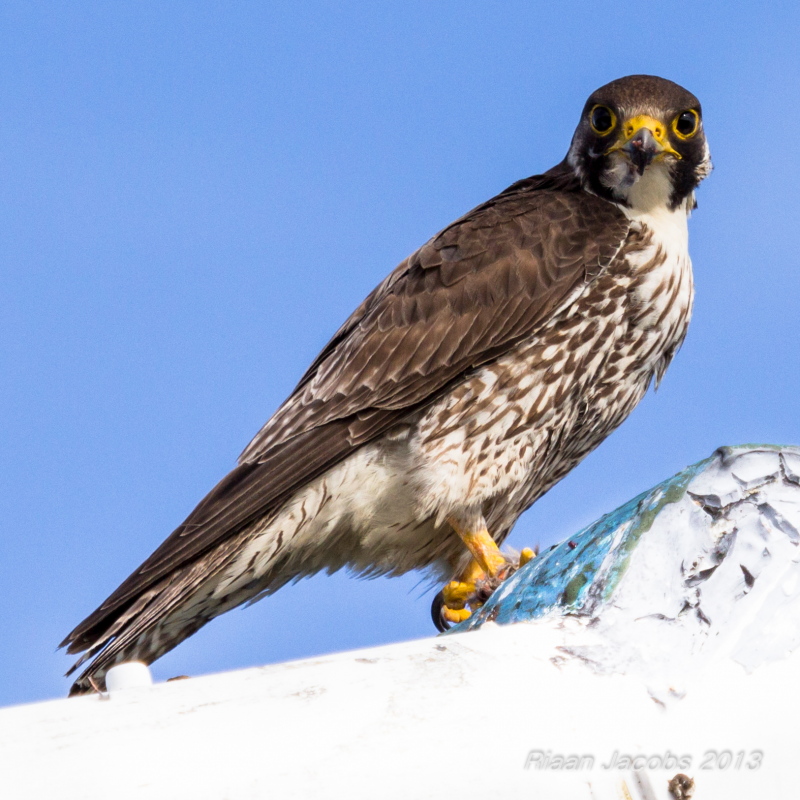 | We received a sad recovery report on the 8th January 2016 from Kathy Marsburg regarding a young Peregrine Falcon who had collided with a reflective window of a building in Brackenfell. This female individual was ringed by Andrew Jenkins as a nestling on the 7th December 2015, meaning this was one of her very early flights (see here for ringing record). Kathy told us that the reflective coating on their office windows has often led to birds flying into them, and that during breeding season many smaller birds such as Cape White-eyes and sunbirds have 'protracted fights' with their reflections. Clear and reflective panes of glass/plastic used as windows have been claimed as the second-greatest threat to wild birds (after habitat destruction). This is because birds behave as if the glass is invisible to them, causing collision casualties and fatalities. Even when the collision isn't fatal and only stuns or concusses the bird, this leaves them especially vulnerable to predators [ref]. Despite the widespread occurence of bird-window collisions, this source of bird fatalities receives little attention in terms of trying to mitigate its impact. Short-term solutions that can be implemented in your own home include covering problem windows in garden netting/insect screening, and moving feeding stations as close as possible to the window. This prevents birds from being able to build up enough speed to injure themselves if there is a collision. A hopeful long-term solution involves UV reflecting and absorbing patterns visible to birds but not to humans that can be used to cover whole windows[ref]. Although this is an unfortunate recovery event, all bird recovery records provide us with important info regarding migration, breeding grounds, distribution, and many others. Human impacts are also important to document so please report any ringed birds you may find having collided with a window to SAFRING using this link. The picture associated with this story is credited to Riaan Jacobs and was sourced from BirdPix.
| ||||||||||||||||||||||||||||||||||||||||||||||||||||||||||||||||||||||||||||||||||||||||||||||||||||||||||||||||||||||||||||||||||||||||||||||||||||||||||||||||||||||||||||||||||||||||||||||||||||||||||||||||||||||||||||||||||||||||||||||||||||||||||||||||||||||||||||||||||||||||||||||||||||||||||||||||||||||||||||||||||||||||||||||||||||||||||||||||||||||||||||||||||||||||||||||||||||||||||||||||||||||||||||||||||||||||||||||||||||||||||||||||||||||||||||||||||||||||||||||||||||||||||||||||||||||||||||||||||||||||||||||||||||||||||||||||||||||||||||||||||||||||||||||||||||||||||||
Longevity of the White-headed Vulture Dane Paijmans (2016-05-26) | |||||||||||||||||||||||||||||||||||||||||||||||||||||||||||||||||||||||||||||||||||||||||||||||||||||||||||||||||||||||||||||||||||||||||||||||||||||||||||||||||||||||||||||||||||||||||||||||||||||||||||||||||||||||||||||||||||||||||||||||||||||||||||||||||||||||||||||||||||||||||||||||||||||||||||||||||||||||||||||||||||||||||||||||||||||||||||||||||||||||||||||||||||||||||||||||||||||||||||||||||||||||||||||||||||||||||||||||||||||||||||||||||||||||||||||||||||||||||||||||||||||||||||||||||||||||||||||||||||||||||||||||||||||||||||||||||||||||||||||||||||||||||||||||||||||||||||||
 |
To complete our analysis of the SAFRING vulture longevity records we have one final species to calculate; the White-headed Vulture (Trigonoceps occipitalis). With an estimated global population of between 10,500-18,750 individuals this species is listed as Critically Endangered by the IUCN redlist[ref]. The major factors for this decline are similar to that of the other vultures (previous Safring Stories), and include reduced food availability (carrion), hunting for trade (muti), persecution, power line collisions poisoning (accidental strychnine poisoning) and loss of habitat.
| ||||||||||||||||||||||||||||||||||||||||||||||||||||||||||||||||||||||||||||||||||||||||||||||||||||||||||||||||||||||||||||||||||||||||||||||||||||||||||||||||||||||||||||||||||||||||||||||||||||||||||||||||||||||||||||||||||||||||||||||||||||||||||||||||||||||||||||||||||||||||||||||||||||||||||||||||||||||||||||||||||||||||||||||||||||||||||||||||||||||||||||||||||||||||||||||||||||||||||||||||||||||||||||||||||||||||||||||||||||||||||||||||||||||||||||||||||||||||||||||||||||||||||||||||||||||||||||||||||||||||||||||||||||||||||||||||||||||||||||||||||||||||||||||||||||||||||||
RIP Methuselah Dane Paijmans (2016-03-23) | |||||||||||||||||||||||||||||||||||||||||||||||||||||||||||||||||||||||||||||||||||||||||||||||||||||||||||||||||||||||||||||||||||||||||||||||||||||||||||||||||||||||||||||||||||||||||||||||||||||||||||||||||||||||||||||||||||||||||||||||||||||||||||||||||||||||||||||||||||||||||||||||||||||||||||||||||||||||||||||||||||||||||||||||||||||||||||||||||||||||||||||||||||||||||||||||||||||||||||||||||||||||||||||||||||||||||||||||||||||||||||||||||||||||||||||||||||||||||||||||||||||||||||||||||||||||||||||||||||||||||||||||||||||||||||||||||||||||||||||||||||||||||||||||||||||||||||||
 | In January 2015 we reported on a resighting of "Methuselah" our oldest Great White Pelican (Pelecanus onocrotalus) (Safring Report). Sadly Methuselah was reported to us as a recovery on the 26th November 2015. After an autopsy it was established that he/she died of natural causes as there were only post-mortem wounds.
| ||||||||||||||||||||||||||||||||||||||||||||||||||||||||||||||||||||||||||||||||||||||||||||||||||||||||||||||||||||||||||||||||||||||||||||||||||||||||||||||||||||||||||||||||||||||||||||||||||||||||||||||||||||||||||||||||||||||||||||||||||||||||||||||||||||||||||||||||||||||||||||||||||||||||||||||||||||||||||||||||||||||||||||||||||||||||||||||||||||||||||||||||||||||||||||||||||||||||||||||||||||||||||||||||||||||||||||||||||||||||||||||||||||||||||||||||||||||||||||||||||||||||||||||||||||||||||||||||||||||||||||||||||||||||||||||||||||||||||||||||||||||||||||||||||||||||||||
New longevity record for the Crowned Lapwing Dane Paijmans (2016-03-11) | |||||||||||||||||||||||||||||||||||||||||||||||||||||||||||||||||||||||||||||||||||||||||||||||||||||||||||||||||||||||||||||||||||||||||||||||||||||||||||||||||||||||||||||||||||||||||||||||||||||||||||||||||||||||||||||||||||||||||||||||||||||||||||||||||||||||||||||||||||||||||||||||||||||||||||||||||||||||||||||||||||||||||||||||||||||||||||||||||||||||||||||||||||||||||||||||||||||||||||||||||||||||||||||||||||||||||||||||||||||||||||||||||||||||||||||||||||||||||||||||||||||||||||||||||||||||||||||||||||||||||||||||||||||||||||||||||||||||||||||||||||||||||||||||||||||||||||||
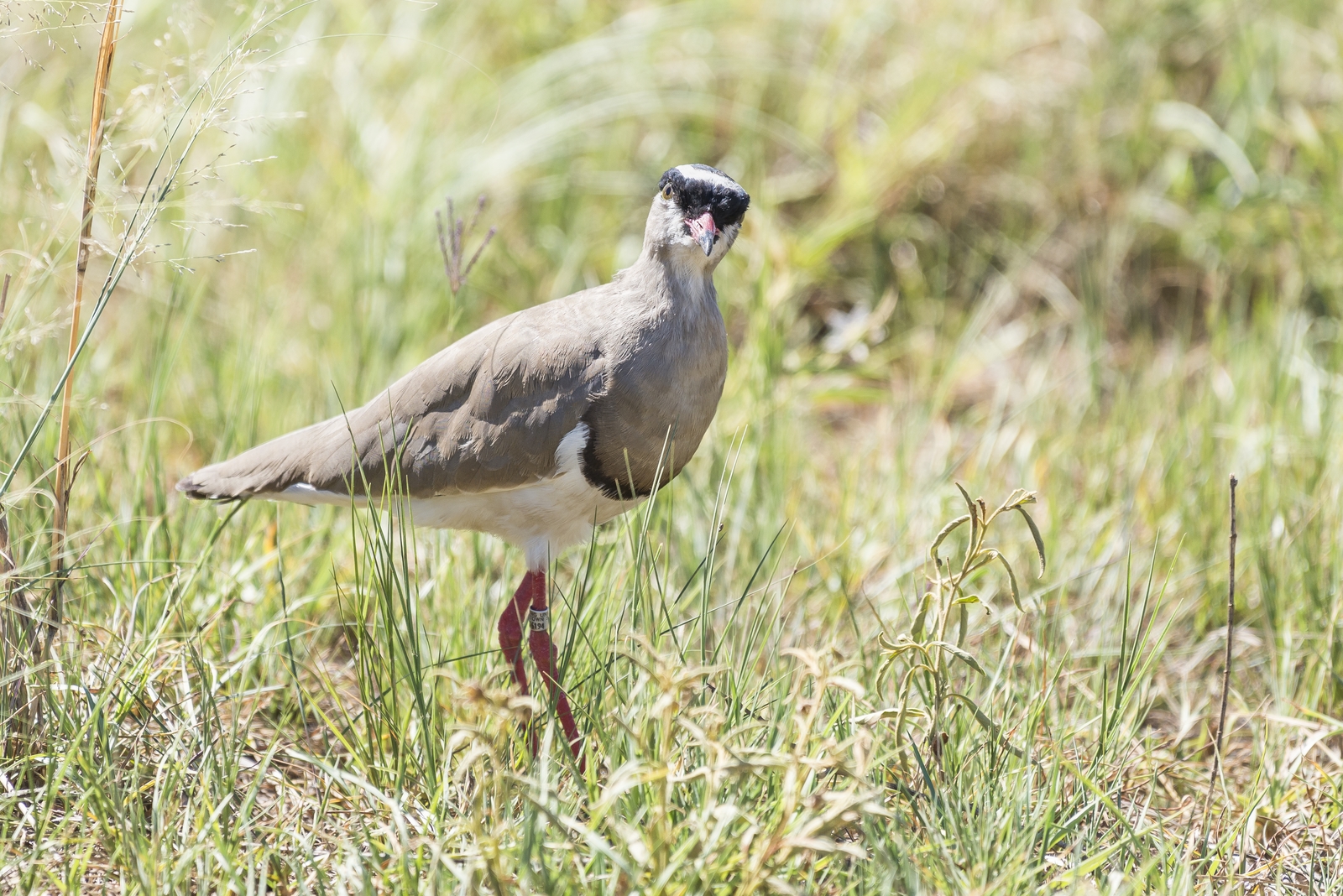 |
We recently received an interesting resighting of a Crowned Lapwing (Vanellus coronatus) from Mr Leon Swart (photographed in Rietvlei Nature Reserve) on the 30th December 2015. Even though this was a resighting, we were able to verify the ring number as photos were submitted (the numbers 36194 were visible), and through a process of elimination the prefix “D” could be determined. This individual was first ringed as an adult by Mr Andrew Tucker (from Pretoria) exactly 15 years and 1 day before this resighting, on the 29th December 2000. This is an important resighting as it has nearly doubled our previous longevity record for this species (longevity: 7y 11m 19d; ring number: 524023). Over the last 15 years this individual has not travelled very far as it was first ringed in Rietvlei Nature Reserve and was seen only 2km from this site.
| ||||||||||||||||||||||||||||||||||||||||||||||||||||||||||||||||||||||||||||||||||||||||||||||||||||||||||||||||||||||||||||||||||||||||||||||||||||||||||||||||||||||||||||||||||||||||||||||||||||||||||||||||||||||||||||||||||||||||||||||||||||||||||||||||||||||||||||||||||||||||||||||||||||||||||||||||||||||||||||||||||||||||||||||||||||||||||||||||||||||||||||||||||||||||||||||||||||||||||||||||||||||||||||||||||||||||||||||||||||||||||||||||||||||||||||||||||||||||||||||||||||||||||||||||||||||||||||||||||||||||||||||||||||||||||||||||||||||||||||||||||||||||||||||||||||||||||||
Visiting Russian Osprey Dane Paijmans (2016-03-02) | |||||||||||||||||||||||||||||||||||||||||||||||||||||||||||||||||||||||||||||||||||||||||||||||||||||||||||||||||||||||||||||||||||||||||||||||||||||||||||||||||||||||||||||||||||||||||||||||||||||||||||||||||||||||||||||||||||||||||||||||||||||||||||||||||||||||||||||||||||||||||||||||||||||||||||||||||||||||||||||||||||||||||||||||||||||||||||||||||||||||||||||||||||||||||||||||||||||||||||||||||||||||||||||||||||||||||||||||||||||||||||||||||||||||||||||||||||||||||||||||||||||||||||||||||||||||||||||||||||||||||||||||||||||||||||||||||||||||||||||||||||||||||||||||||||||||||||||
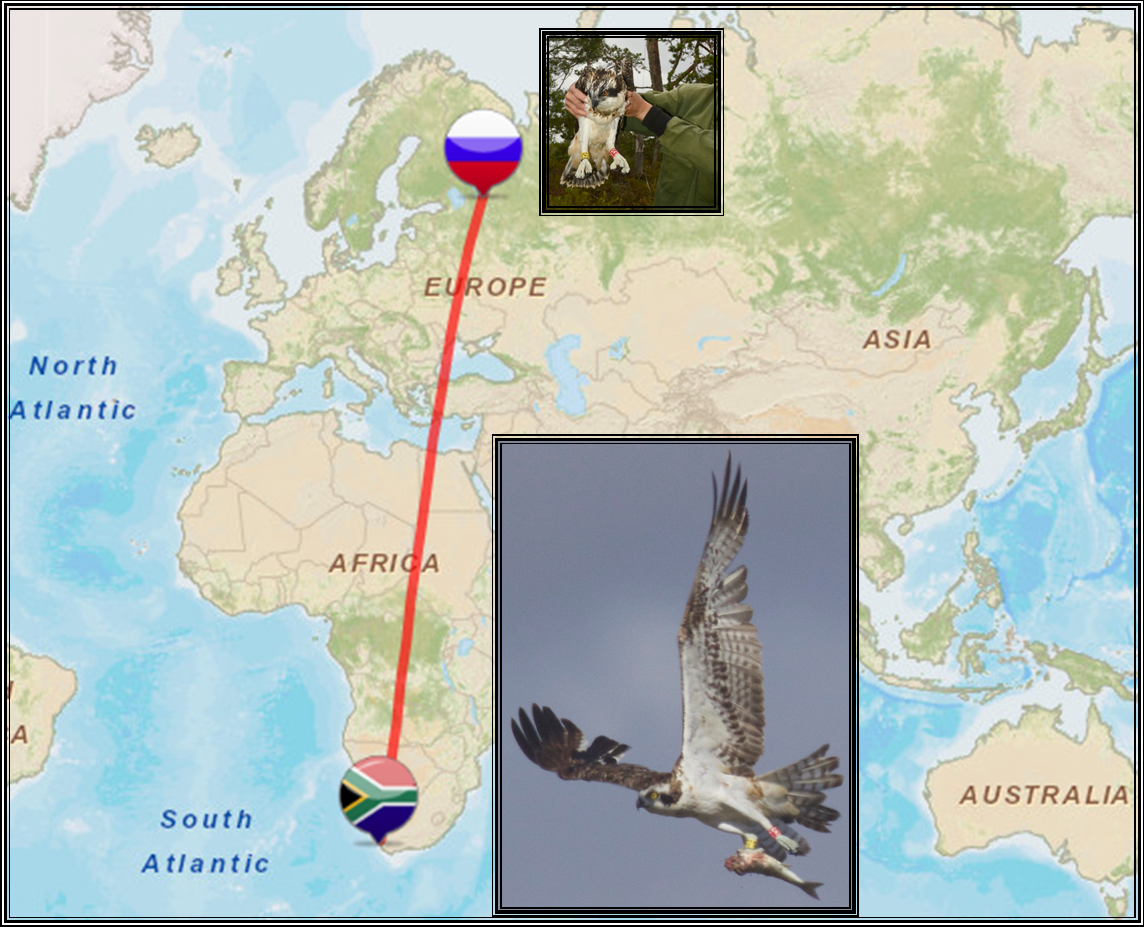 | We received an interesting sighting recently from one of our ADU members; Michael Buckham. This sighting is not only interesting due to it being one of only a few Osprey (Pandion haliaetus) records, but also due the fact that this is the first SAFRING recorded Osprey from Russia.
| ||||||||||||||||||||||||||||||||||||||||||||||||||||||||||||||||||||||||||||||||||||||||||||||||||||||||||||||||||||||||||||||||||||||||||||||||||||||||||||||||||||||||||||||||||||||||||||||||||||||||||||||||||||||||||||||||||||||||||||||||||||||||||||||||||||||||||||||||||||||||||||||||||||||||||||||||||||||||||||||||||||||||||||||||||||||||||||||||||||||||||||||||||||||||||||||||||||||||||||||||||||||||||||||||||||||||||||||||||||||||||||||||||||||||||||||||||||||||||||||||||||||||||||||||||||||||||||||||||||||||||||||||||||||||||||||||||||||||||||||||||||||||||||||||||||||||||||
Printed Bird Ringers Data Book Available Dane Paijmans (2016-02-22) | |||||||||||||||||||||||||||||||||||||||||||||||||||||||||||||||||||||||||||||||||||||||||||||||||||||||||||||||||||||||||||||||||||||||||||||||||||||||||||||||||||||||||||||||||||||||||||||||||||||||||||||||||||||||||||||||||||||||||||||||||||||||||||||||||||||||||||||||||||||||||||||||||||||||||||||||||||||||||||||||||||||||||||||||||||||||||||||||||||||||||||||||||||||||||||||||||||||||||||||||||||||||||||||||||||||||||||||||||||||||||||||||||||||||||||||||||||||||||||||||||||||||||||||||||||||||||||||||||||||||||||||||||||||||||||||||||||||||||||||||||||||||||||||||||||||||||||||
 | One of our ringers has taken initiative and designed and printed a great addition to any ringers tool box; a bird ringers data book with all tables laid out for ease of use.
| ||||||||||||||||||||||||||||||||||||||||||||||||||||||||||||||||||||||||||||||||||||||||||||||||||||||||||||||||||||||||||||||||||||||||||||||||||||||||||||||||||||||||||||||||||||||||||||||||||||||||||||||||||||||||||||||||||||||||||||||||||||||||||||||||||||||||||||||||||||||||||||||||||||||||||||||||||||||||||||||||||||||||||||||||||||||||||||||||||||||||||||||||||||||||||||||||||||||||||||||||||||||||||||||||||||||||||||||||||||||||||||||||||||||||||||||||||||||||||||||||||||||||||||||||||||||||||||||||||||||||||||||||||||||||||||||||||||||||||||||||||||||||||||||||||||||||||||
Longevity of the Hooded Vulture Dane Paijmans (2016-02-19) | |||||||||||||||||||||||||||||||||||||||||||||||||||||||||||||||||||||||||||||||||||||||||||||||||||||||||||||||||||||||||||||||||||||||||||||||||||||||||||||||||||||||||||||||||||||||||||||||||||||||||||||||||||||||||||||||||||||||||||||||||||||||||||||||||||||||||||||||||||||||||||||||||||||||||||||||||||||||||||||||||||||||||||||||||||||||||||||||||||||||||||||||||||||||||||||||||||||||||||||||||||||||||||||||||||||||||||||||||||||||||||||||||||||||||||||||||||||||||||||||||||||||||||||||||||||||||||||||||||||||||||||||||||||||||||||||||||||||||||||||||||||||||||||||||||||||||||||
 |
Carrying on with the vulture longevities we will be taking a look at the longevity of one of the smaller species; the Hooded Vulture (Necrosyrtes monachus). With an estimated global population of 197,000 individuals (with a extremely rapid decline) this species is listed as Critically Endangered by the IUCN redlist[ref]. The major factors for this decline are similar to that of the other vultures (previous Safring Stories), and include reduced food availability (carrion), hunting for trade (muti), persecution, power line collisions poisoning (accidental strychnine poisoning) and loss of habitat.
| ||||||||||||||||||||||||||||||||||||||||||||||||||||||||||||||||||||||||||||||||||||||||||||||||||||||||||||||||||||||||||||||||||||||||||||||||||||||||||||||||||||||||||||||||||||||||||||||||||||||||||||||||||||||||||||||||||||||||||||||||||||||||||||||||||||||||||||||||||||||||||||||||||||||||||||||||||||||||||||||||||||||||||||||||||||||||||||||||||||||||||||||||||||||||||||||||||||||||||||||||||||||||||||||||||||||||||||||||||||||||||||||||||||||||||||||||||||||||||||||||||||||||||||||||||||||||||||||||||||||||||||||||||||||||||||||||||||||||||||||||||||||||||||||||||||||||||||
Longevity of the Lappet-faced Vulture Dane Paijmans (2016-02-09) | |||||||||||||||||||||||||||||||||||||||||||||||||||||||||||||||||||||||||||||||||||||||||||||||||||||||||||||||||||||||||||||||||||||||||||||||||||||||||||||||||||||||||||||||||||||||||||||||||||||||||||||||||||||||||||||||||||||||||||||||||||||||||||||||||||||||||||||||||||||||||||||||||||||||||||||||||||||||||||||||||||||||||||||||||||||||||||||||||||||||||||||||||||||||||||||||||||||||||||||||||||||||||||||||||||||||||||||||||||||||||||||||||||||||||||||||||||||||||||||||||||||||||||||||||||||||||||||||||||||||||||||||||||||||||||||||||||||||||||||||||||||||||||||||||||||||||||||
 |
This week we will get back to vultures by taking a look at the longevity of the Lappet-faced Vulture (Torgos tracheliotus). With an estimated global population of only 8,500 individuals (with a decreasing trend) this species has good reason to be listed as Endangered by the IUCN redlist[ref]. The major factors for this decline are similar to that of the White-backed and Cape Vultures, and include reduced food availability (carrion), hunting for trade (muti), persecution, power line collisions and poisoning (accidental strychnine poisoning). On reviewing our database, most recorded deaths appear to be a result of poisoning (either intentional or unintentional) with a very low number of power line collisions. One individual was recorded as shot while two appeared to have drowned.
| ||||||||||||||||||||||||||||||||||||||||||||||||||||||||||||||||||||||||||||||||||||||||||||||||||||||||||||||||||||||||||||||||||||||||||||||||||||||||||||||||||||||||||||||||||||||||||||||||||||||||||||||||||||||||||||||||||||||||||||||||||||||||||||||||||||||||||||||||||||||||||||||||||||||||||||||||||||||||||||||||||||||||||||||||||||||||||||||||||||||||||||||||||||||||||||||||||||||||||||||||||||||||||||||||||||||||||||||||||||||||||||||||||||||||||||||||||||||||||||||||||||||||||||||||||||||||||||||||||||||||||||||||||||||||||||||||||||||||||||||||||||||||||||||||||||||||||||
New New Longevity record of the Martial Eagle Dane Paijmans (2016-02-02) | |||||||||||||||||||||||||||||||||||||||||||||||||||||||||||||||||||||||||||||||||||||||||||||||||||||||||||||||||||||||||||||||||||||||||||||||||||||||||||||||||||||||||||||||||||||||||||||||||||||||||||||||||||||||||||||||||||||||||||||||||||||||||||||||||||||||||||||||||||||||||||||||||||||||||||||||||||||||||||||||||||||||||||||||||||||||||||||||||||||||||||||||||||||||||||||||||||||||||||||||||||||||||||||||||||||||||||||||||||||||||||||||||||||||||||||||||||||||||||||||||||||||||||||||||||||||||||||||||||||||||||||||||||||||||||||||||||||||||||||||||||||||||||||||||||||||||||||
 | In September 2014 we announced a new longevity record for the Martial Eagle. That new record belonged to an individual that was recovered after being electrocuted on power lines in the Kruger National Park (ring number: G19094 ). As it was an adult at the time of initial ringing the age was estimated to be over 27 years. Although the individual may have been older than that, no guarantee could be made. After receiving another Martial Eagle recovery in December last year (on a farm along the Nossob River, Namibia) we discovered our record had been beaten. The recovery was from an individual ringed as a juvenile in Kgalagadi Transfrontier Park in 1984, which made our new longevity record for this species a confirmed age of 31.44 years.
If you feel you know of an older record please contact us at SAFRING with the details.
| ||||||||||||||||||||||||||||||||||||||||||||||||||||||||||||||||||||||||||||||||||||||||||||||||||||||||||||||||||||||||||||||||||||||||||||||||||||||||||||||||||||||||||||||||||||||||||||||||||||||||||||||||||||||||||||||||||||||||||||||||||||||||||||||||||||||||||||||||||||||||||||||||||||||||||||||||||||||||||||||||||||||||||||||||||||||||||||||||||||||||||||||||||||||||||||||||||||||||||||||||||||||||||||||||||||||||||||||||||||||||||||||||||||||||||||||||||||||||||||||||||||||||||||||||||||||||||||||||||||||||||||||||||||||||||||||||||||||||||||||||||||||||||||||||||||||||||||
Oldest Ringed Grey Heron in Southern Africa Laurie Johnson (2016-01-20) | |||||||||||||||||||||||||||||||||||||||||||||||||||||||||||||||||||||||||||||||||||||||||||||||||||||||||||||||||||||||||||||||||||||||||||||||||||||||||||||||||||||||||||||||||||||||||||||||||||||||||||||||||||||||||||||||||||||||||||||||||||||||||||||||||||||||||||||||||||||||||||||||||||||||||||||||||||||||||||||||||||||||||||||||||||||||||||||||||||||||||||||||||||||||||||||||||||||||||||||||||||||||||||||||||||||||||||||||||||||||||||||||||||||||||||||||||||||||||||||||||||||||||||||||||||||||||||||||||||||||||||||||||||||||||||||||||||||||||||||||||||||||||||||||||||||||||||||
 | This week we will be looking at the Grey Heron (Ardea cinerea) for which a new longevity record has been recorded. The Grey Heron has a large population and is found in temperate Europe, Asia and parts of Africa, in shallow waters near trees; as it is an arboreal nester. The estimated population size is between 790 000 and 3700 000 individuals (ref). A re-sighting of a ringed Grey Heron earlier this year has seen the longevity record being broken by an individual spotted at Olifantsbos on the 2nd of January. The combination of the metal ring on the left leg and the red colour ring on the right leg confirms that this bird was ringed in 2003 at Rondevlei Nature Reserve as a juvenile. This makes the individual 13 years as of October 2015 and the oldest ringed Grey Heron in South Africa that SAFRING has on record. Our previous longevity record for this species was 11 years and 9 months. If you know of an older record please contact us at SAFRING with the details. This record breaking individual is still alive and could possibly break its own record by the end of the year; so please report any sighting of these and other colour ringed (here) and ringed birds (here) that you come across to us. This is a great example of how ringing birds and colour ringing projects are able to gather new information on various aspects of species ecology; in this case their longevity! Thank you to Simon Fogarty for reporting this Grey Heron which was ringed by Dalton Gibbs. The image used in this article comes from Michael Brooks and was linked from BirdPix
| ||||||||||||||||||||||||||||||||||||||||||||||||||||||||||||||||||||||||||||||||||||||||||||||||||||||||||||||||||||||||||||||||||||||||||||||||||||||||||||||||||||||||||||||||||||||||||||||||||||||||||||||||||||||||||||||||||||||||||||||||||||||||||||||||||||||||||||||||||||||||||||||||||||||||||||||||||||||||||||||||||||||||||||||||||||||||||||||||||||||||||||||||||||||||||||||||||||||||||||||||||||||||||||||||||||||||||||||||||||||||||||||||||||||||||||||||||||||||||||||||||||||||||||||||||||||||||||||||||||||||||||||||||||||||||||||||||||||||||||||||||||||||||||||||||||||||||||
New Ringer Tool: You are now able to Edit Dane Paijmans (2016-01-13) | |||||||||||||||||||||||||||||||||||||||||||||||||||||||||||||||||||||||||||||||||||||||||||||||||||||||||||||||||||||||||||||||||||||||||||||||||||||||||||||||||||||||||||||||||||||||||||||||||||||||||||||||||||||||||||||||||||||||||||||||||||||||||||||||||||||||||||||||||||||||||||||||||||||||||||||||||||||||||||||||||||||||||||||||||||||||||||||||||||||||||||||||||||||||||||||||||||||||||||||||||||||||||||||||||||||||||||||||||||||||||||||||||||||||||||||||||||||||||||||||||||||||||||||||||||||||||||||||||||||||||||||||||||||||||||||||||||||||||||||||||||||||||||||||||||||||||||||
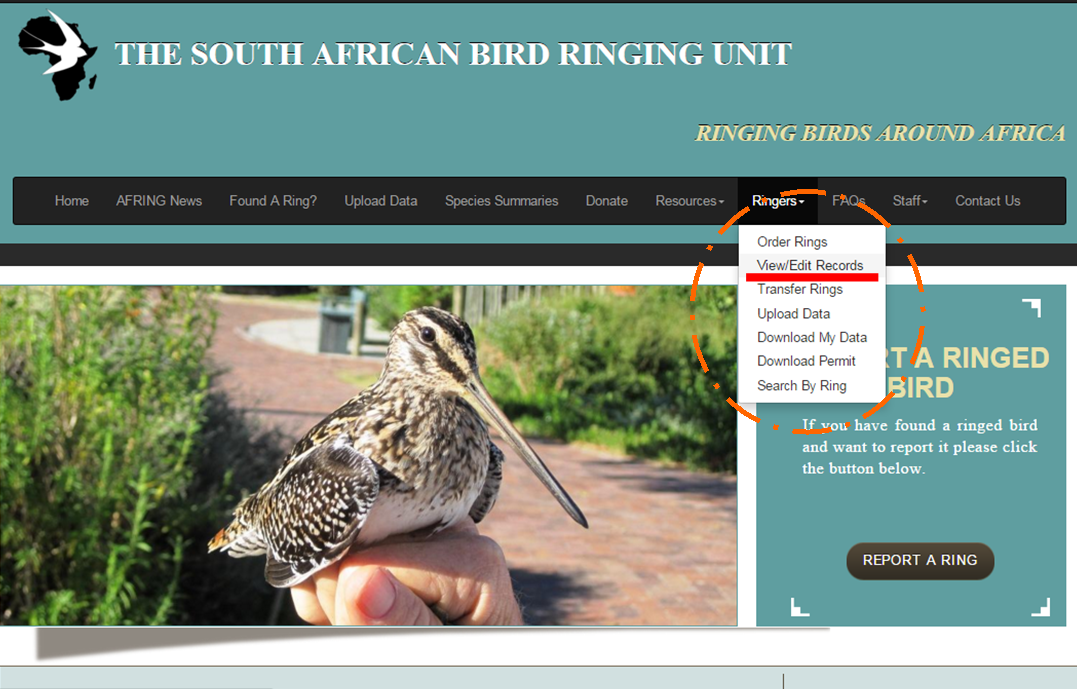 | After months and months of sweat and tears we have finally activated the record editing tool for registered ringers. This tool will allow you to edit your own records through a fairly simply search menu. This page will be undergoing some edits in future so we are happy to receive any comments and improvements.
I hope you enjoy this new function, and if you notice any bugs or errors please let us know. | ||||||||||||||||||||||||||||||||||||||||||||||||||||||||||||||||||||||||||||||||||||||||||||||||||||||||||||||||||||||||||||||||||||||||||||||||||||||||||||||||||||||||||||||||||||||||||||||||||||||||||||||||||||||||||||||||||||||||||||||||||||||||||||||||||||||||||||||||||||||||||||||||||||||||||||||||||||||||||||||||||||||||||||||||||||||||||||||||||||||||||||||||||||||||||||||||||||||||||||||||||||||||||||||||||||||||||||||||||||||||||||||||||||||||||||||||||||||||||||||||||||||||||||||||||||||||||||||||||||||||||||||||||||||||||||||||||||||||||||||||||||||||||||||||||||||||||||
Longevity of the Cape Vulture Dane Paijmans (2016-01-12) | |||||||||||||||||||||||||||||||||||||||||||||||||||||||||||||||||||||||||||||||||||||||||||||||||||||||||||||||||||||||||||||||||||||||||||||||||||||||||||||||||||||||||||||||||||||||||||||||||||||||||||||||||||||||||||||||||||||||||||||||||||||||||||||||||||||||||||||||||||||||||||||||||||||||||||||||||||||||||||||||||||||||||||||||||||||||||||||||||||||||||||||||||||||||||||||||||||||||||||||||||||||||||||||||||||||||||||||||||||||||||||||||||||||||||||||||||||||||||||||||||||||||||||||||||||||||||||||||||||||||||||||||||||||||||||||||||||||||||||||||||||||||||||||||||||||||||||||
 |
This week we will be taking a look at the longevity of the Cape Vulture (Gyps coprotheres). With an estimated global population of only 9400 mature individuals (estimated in 2013 and decreasing rapidly) [ref] this species is already of great concern. The major factors in this decline are similar to that of the White-backed Vulture; reduced food availability (carrion), hunting for trade (muti), persecution, powerline collisions and poisoning. Extensive work is being done to stop this decline by establishing/maintaining vulture restaurants and reducing powerline deaths.
| ||||||||||||||||||||||||||||||||||||||||||||||||||||||||||||||||||||||||||||||||||||||||||||||||||||||||||||||||||||||||||||||||||||||||||||||||||||||||||||||||||||||||||||||||||||||||||||||||||||||||||||||||||||||||||||||||||||||||||||||||||||||||||||||||||||||||||||||||||||||||||||||||||||||||||||||||||||||||||||||||||||||||||||||||||||||||||||||||||||||||||||||||||||||||||||||||||||||||||||||||||||||||||||||||||||||||||||||||||||||||||||||||||||||||||||||||||||||||||||||||||||||||||||||||||||||||||||||||||||||||||||||||||||||||||||||||||||||||||||||||||||||||||||||||||||||||||||
Longevity of the White-backed Vulture Dane Paijmans (2016-01-04) | |||||||||||||||||||||||||||||||||||||||||||||||||||||||||||||||||||||||||||||||||||||||||||||||||||||||||||||||||||||||||||||||||||||||||||||||||||||||||||||||||||||||||||||||||||||||||||||||||||||||||||||||||||||||||||||||||||||||||||||||||||||||||||||||||||||||||||||||||||||||||||||||||||||||||||||||||||||||||||||||||||||||||||||||||||||||||||||||||||||||||||||||||||||||||||||||||||||||||||||||||||||||||||||||||||||||||||||||||||||||||||||||||||||||||||||||||||||||||||||||||||||||||||||||||||||||||||||||||||||||||||||||||||||||||||||||||||||||||||||||||||||||||||||||||||||||||||||
 |
I hope you have all had a merry festive season full of family, friends and a good helping of bird watching on these warm summer days. We will get the longevity stories for this year started with some of our endangered vultures. First up is the White-backed Vulture (Gyps africanus). With an estimated global population of 270,000 individuals (which has decreased over 50% in the last 15 years) [ref] this species is quickly becoming one of great concern. Some of the major factors in this decline are; reduced food availability (carrion), hunting for trade (muti), persecution, powerline collisions and poisoning (this occurs when landowners attempt to poison livestock preditors with poisoned meat).
| ||||||||||||||||||||||||||||||||||||||||||||||||||||||||||||||||||||||||||||||||||||||||||||||||||||||||||||||||||||||||||||||||||||||||||||||||||||||||||||||||||||||||||||||||||||||||||||||||||||||||||||||||||||||||||||||||||||||||||||||||||||||||||||||||||||||||||||||||||||||||||||||||||||||||||||||||||||||||||||||||||||||||||||||||||||||||||||||||||||||||||||||||||||||||||||||||||||||||||||||||||||||||||||||||||||||||||||||||||||||||||||||||||||||||||||||||||||||||||||||||||||||||||||||||||||||||||||||||||||||||||||||||||||||||||||||||||||||||||||||||||||||||||||||||||||||||||||
Sad outcome for a visiting Arctic Tern from Iceland Dane Paijmans (2015-11-02) | |||||||||||||||||||||||||||||||||||||||||||||||||||||||||||||||||||||||||||||||||||||||||||||||||||||||||||||||||||||||||||||||||||||||||||||||||||||||||||||||||||||||||||||||||||||||||||||||||||||||||||||||||||||||||||||||||||||||||||||||||||||||||||||||||||||||||||||||||||||||||||||||||||||||||||||||||||||||||||||||||||||||||||||||||||||||||||||||||||||||||||||||||||||||||||||||||||||||||||||||||||||||||||||||||||||||||||||||||||||||||||||||||||||||||||||||||||||||||||||||||||||||||||||||||||||||||||||||||||||||||||||||||||||||||||||||||||||||||||||||||||||||||||||||||||||||||||||
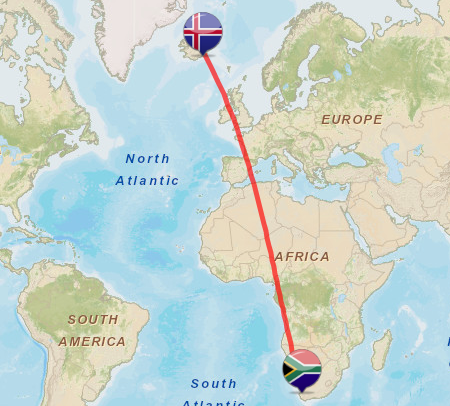 | We at SAFRING recently received an interesting Arctic Tern (Sterna paradisaea) recovery from our friends at SANCCOB Rehabilitation Centre. Initially thought to be a Common Tern, it was found weak and exhausted (due to being tangled in plastic) on Kommetjie beach (34 ° 08' S 18 ° 19' E), on the 18 October 2015. It was admitted to SANCCOB but sadly didn't survive due to its poor condition. This record is very interesting as it was intially ringed by the Icelandic Ringing Scheme in Ósland, Höfn, Iceland. This is only the third ring record we have received from Iceland and only the second such record of an Arctic Tern. This individual was ringed as a juvenile on the 13 July 2013 (ring number: 776621), and was not seen again until now. We would like to thank the Icelandic Ringing Scheme for the initial ring record and SANCCOB for all they do for our seabirds. | ||||||||||||||||||||||||||||||||||||||||||||||||||||||||||||||||||||||||||||||||||||||||||||||||||||||||||||||||||||||||||||||||||||||||||||||||||||||||||||||||||||||||||||||||||||||||||||||||||||||||||||||||||||||||||||||||||||||||||||||||||||||||||||||||||||||||||||||||||||||||||||||||||||||||||||||||||||||||||||||||||||||||||||||||||||||||||||||||||||||||||||||||||||||||||||||||||||||||||||||||||||||||||||||||||||||||||||||||||||||||||||||||||||||||||||||||||||||||||||||||||||||||||||||||||||||||||||||||||||||||||||||||||||||||||||||||||||||||||||||||||||||||||||||||||||||||||||
Longevity of the Rock Pigeon Dane Paijmans (2015-10-01) | |||||||||||||||||||||||||||||||||||||||||||||||||||||||||||||||||||||||||||||||||||||||||||||||||||||||||||||||||||||||||||||||||||||||||||||||||||||||||||||||||||||||||||||||||||||||||||||||||||||||||||||||||||||||||||||||||||||||||||||||||||||||||||||||||||||||||||||||||||||||||||||||||||||||||||||||||||||||||||||||||||||||||||||||||||||||||||||||||||||||||||||||||||||||||||||||||||||||||||||||||||||||||||||||||||||||||||||||||||||||||||||||||||||||||||||||||||||||||||||||||||||||||||||||||||||||||||||||||||||||||||||||||||||||||||||||||||||||||||||||||||||||||||||||||||||||||||||
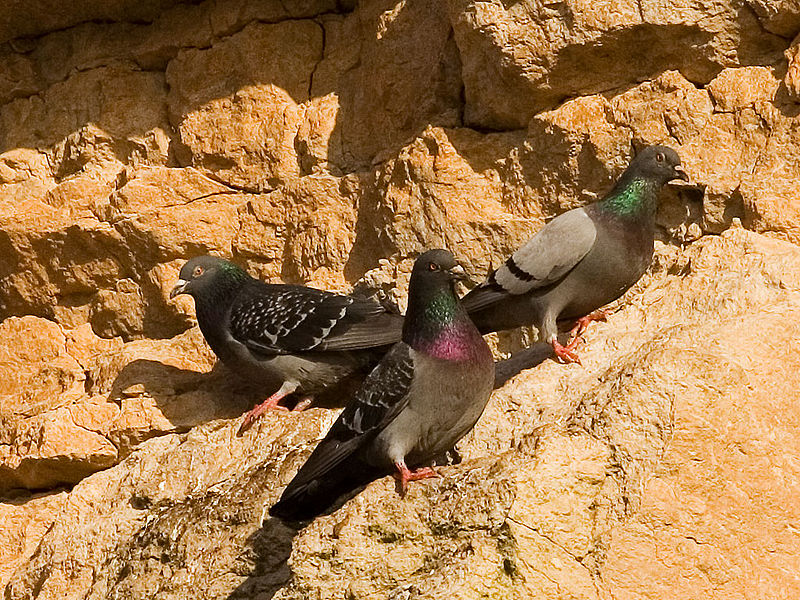 |
A common site within most of our cities around the world is the Rock Pigeon or "winged rats" as some people may call them. Their success in these environments is likely due to their ability to adapt so well to our urban expansions that tend to be void of their natural predators and full of discarded food. This has lead to an estimated population of 260 million birds around the world [ref].
| ||||||||||||||||||||||||||||||||||||||||||||||||||||||||||||||||||||||||||||||||||||||||||||||||||||||||||||||||||||||||||||||||||||||||||||||||||||||||||||||||||||||||||||||||||||||||||||||||||||||||||||||||||||||||||||||||||||||||||||||||||||||||||||||||||||||||||||||||||||||||||||||||||||||||||||||||||||||||||||||||||||||||||||||||||||||||||||||||||||||||||||||||||||||||||||||||||||||||||||||||||||||||||||||||||||||||||||||||||||||||||||||||||||||||||||||||||||||||||||||||||||||||||||||||||||||||||||||||||||||||||||||||||||||||||||||||||||||||||||||||||||||||||||||||||||||||||||
Ring Information Photos Dane Paijmans (2015-09-04) | |||||||||||||||||||||||||||||||||||||||||||||||||||||||||||||||||||||||||||||||||||||||||||||||||||||||||||||||||||||||||||||||||||||||||||||||||||||||||||||||||||||||||||||||||||||||||||||||||||||||||||||||||||||||||||||||||||||||||||||||||||||||||||||||||||||||||||||||||||||||||||||||||||||||||||||||||||||||||||||||||||||||||||||||||||||||||||||||||||||||||||||||||||||||||||||||||||||||||||||||||||||||||||||||||||||||||||||||||||||||||||||||||||||||||||||||||||||||||||||||||||||||||||||||||||||||||||||||||||||||||||||||||||||||||||||||||||||||||||||||||||||||||||||||||||||||||||||
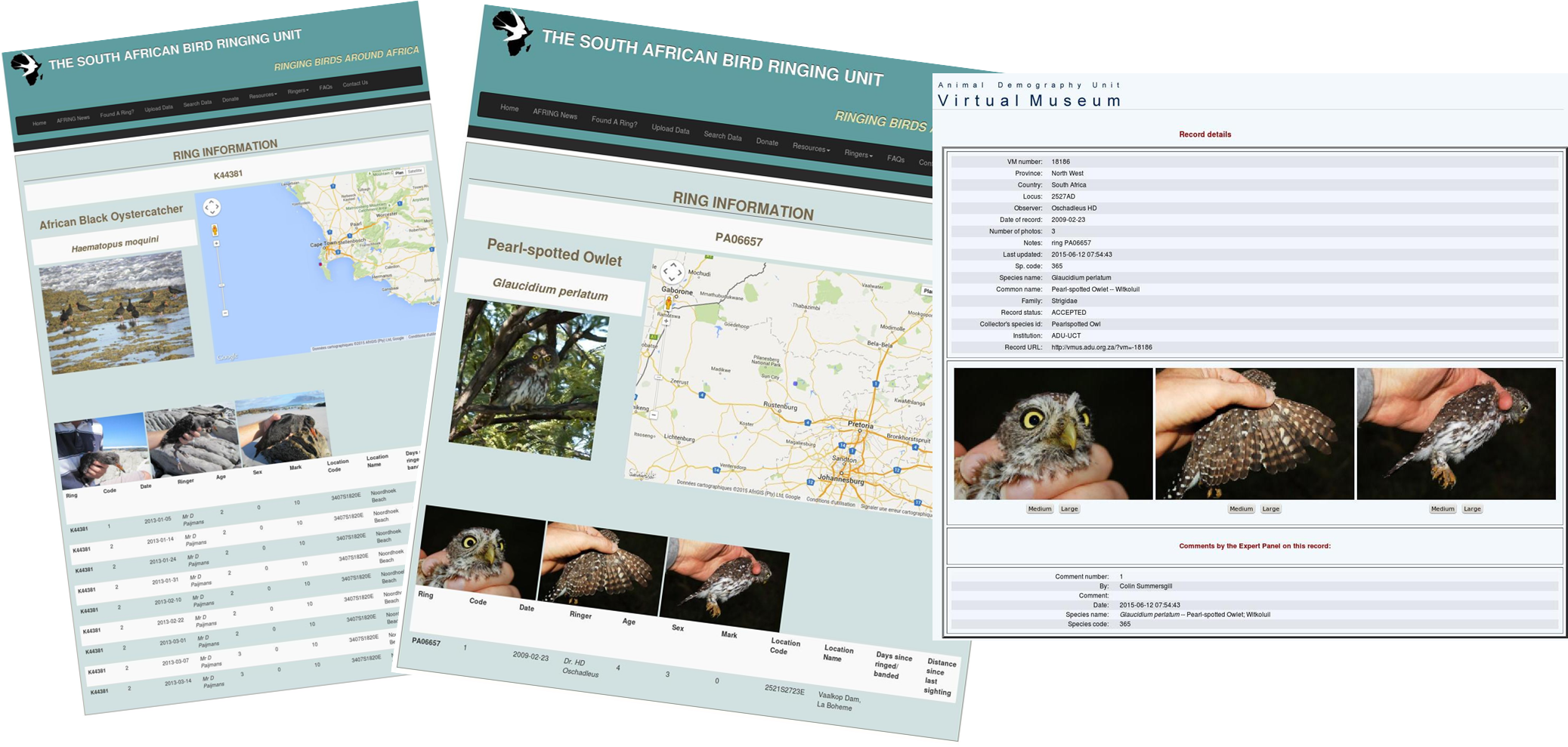 | We at SAFRING have made a small addition to our ring record page by linking it to Birdpix. This means that it is now possible for ringers to upload their ringing photos to be displayed above the ringing details of each record (by following the instructions below). Non-ringers will also be able to take part by uploading your re-sighting photos and sending us the link when alerting us. INSTRUCTIONS 1. Upload your ringing data to the SAFRING web.(Only for ringers) 2. Upload 1-3 photos of the ringed bird to Birdpix (part of the ADU Virtual Museum). To do this Login/or sign up to http://vmus.adu.org.za with the same login as for the SAFRING web. Upload your photos and make sure the ring number is mentioned in the Notes - the ring number must be in the SAFRING format, eg 412345 (not 4-12345) or BC12345 (not BC 12345), ie one alpha-numeric number with no spaces or hyphens. There is a pdf help guide on the http://vmus.adu.org.za site if you have not uploaded any photos there before. 3. You will need to wait for the Birdpix panel to accept the record before you will see it (this usually happens within less than a day). Examples of this is ring record: PA06657, 729577, K44381 To see a larger version of the photos, you can click on the image and a new tab opens with the Birdpix site where there is an option to view the photos at highest resolution. Enjoy this new feature and I look forward to seeing all your interesting photos. Share this via Twitter by clicking | ||||||||||||||||||||||||||||||||||||||||||||||||||||||||||||||||||||||||||||||||||||||||||||||||||||||||||||||||||||||||||||||||||||||||||||||||||||||||||||||||||||||||||||||||||||||||||||||||||||||||||||||||||||||||||||||||||||||||||||||||||||||||||||||||||||||||||||||||||||||||||||||||||||||||||||||||||||||||||||||||||||||||||||||||||||||||||||||||||||||||||||||||||||||||||||||||||||||||||||||||||||||||||||||||||||||||||||||||||||||||||||||||||||||||||||||||||||||||||||||||||||||||||||||||||||||||||||||||||||||||||||||||||||||||||||||||||||||||||||||||||||||||||||||||||||||||||||
AFRING News Revamp Dane Paijmans (2015-08-26) | |||||||||||||||||||||||||||||||||||||||||||||||||||||||||||||||||||||||||||||||||||||||||||||||||||||||||||||||||||||||||||||||||||||||||||||||||||||||||||||||||||||||||||||||||||||||||||||||||||||||||||||||||||||||||||||||||||||||||||||||||||||||||||||||||||||||||||||||||||||||||||||||||||||||||||||||||||||||||||||||||||||||||||||||||||||||||||||||||||||||||||||||||||||||||||||||||||||||||||||||||||||||||||||||||||||||||||||||||||||||||||||||||||||||||||||||||||||||||||||||||||||||||||||||||||||||||||||||||||||||||||||||||||||||||||||||||||||||||||||||||||||||||||||||||||||||||||||
 | In 1972 SAFRING produced their first self published journal SAFRING News (seen in this image). This publication continued for the next 30 years fairly unchanged until 2001 when it had a name change and became AFRING News, which finally became the online journal we have today (Click Here).
| ||||||||||||||||||||||||||||||||||||||||||||||||||||||||||||||||||||||||||||||||||||||||||||||||||||||||||||||||||||||||||||||||||||||||||||||||||||||||||||||||||||||||||||||||||||||||||||||||||||||||||||||||||||||||||||||||||||||||||||||||||||||||||||||||||||||||||||||||||||||||||||||||||||||||||||||||||||||||||||||||||||||||||||||||||||||||||||||||||||||||||||||||||||||||||||||||||||||||||||||||||||||||||||||||||||||||||||||||||||||||||||||||||||||||||||||||||||||||||||||||||||||||||||||||||||||||||||||||||||||||||||||||||||||||||||||||||||||||||||||||||||||||||||||||||||||||||||
Tern-eating Baboons in Rooi-Els Christie Craig (2015-08-18) | |||||||||||||||||||||||||||||||||||||||||||||||||||||||||||||||||||||||||||||||||||||||||||||||||||||||||||||||||||||||||||||||||||||||||||||||||||||||||||||||||||||||||||||||||||||||||||||||||||||||||||||||||||||||||||||||||||||||||||||||||||||||||||||||||||||||||||||||||||||||||||||||||||||||||||||||||||||||||||||||||||||||||||||||||||||||||||||||||||||||||||||||||||||||||||||||||||||||||||||||||||||||||||||||||||||||||||||||||||||||||||||||||||||||||||||||||||||||||||||||||||||||||||||||||||||||||||||||||||||||||||||||||||||||||||||||||||||||||||||||||||||||||||||||||||||||||||||
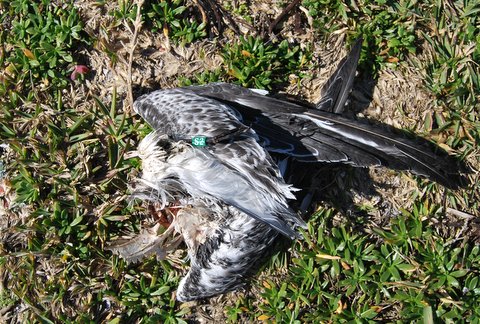 | This week we received an interesting recovery of a Swift Tern from Rooi-Els (Ring number: 5H53976). Helen Jones found the bird beheaded and suspected that it had met the same fate as some previous terns (See Promerops September 2013). Locals have seen baboons taking out terns and eating them. Baboons are omnivores, their diets consist of mainly shoots, fruit, seeds and roots but they will take meat from time to time. Meat is usually taken by males and by the more dominant members of the troop (see article ). There are also records of flamingos being taken as well as ground nesting bird fledglings. This particular bird was a juvenile and it is likely that most terns that are taken by baboons are young birds. If you have witnessed baboons killing and eating birds, we would be interested to hear about it. | ||||||||||||||||||||||||||||||||||||||||||||||||||||||||||||||||||||||||||||||||||||||||||||||||||||||||||||||||||||||||||||||||||||||||||||||||||||||||||||||||||||||||||||||||||||||||||||||||||||||||||||||||||||||||||||||||||||||||||||||||||||||||||||||||||||||||||||||||||||||||||||||||||||||||||||||||||||||||||||||||||||||||||||||||||||||||||||||||||||||||||||||||||||||||||||||||||||||||||||||||||||||||||||||||||||||||||||||||||||||||||||||||||||||||||||||||||||||||||||||||||||||||||||||||||||||||||||||||||||||||||||||||||||||||||||||||||||||||||||||||||||||||||||||||||||||||||||
Helping SAFRING with Colour Projects Dane Paijmans (2015-08-03) | |||||||||||||||||||||||||||||||||||||||||||||||||||||||||||||||||||||||||||||||||||||||||||||||||||||||||||||||||||||||||||||||||||||||||||||||||||||||||||||||||||||||||||||||||||||||||||||||||||||||||||||||||||||||||||||||||||||||||||||||||||||||||||||||||||||||||||||||||||||||||||||||||||||||||||||||||||||||||||||||||||||||||||||||||||||||||||||||||||||||||||||||||||||||||||||||||||||||||||||||||||||||||||||||||||||||||||||||||||||||||||||||||||||||||||||||||||||||||||||||||||||||||||||||||||||||||||||||||||||||||||||||||||||||||||||||||||||||||||||||||||||||||||||||||||||||||||||
 | Here at the ADU (Animal demography Unit) we promote Citizen Science as a very important means of collecting expansive data sets and improving the spread of knowledge throughout southern Africa. Sadly it is not always possible for citizen scientists to take part in the projects offered by SAFRING as not everyone can get a ringing permit (as it requires a lot of training and time) and looking for dead birds to help with recoveries tends to be a little macabre, and quite disturbing when people see us rummaging around a maggot filled corpse to see if there is a ring.
This does not mean that our non-ringing citizen scientists have nothing to offer us here at SAFRING. We have been placing a lot of effort into coordinating the Colour Projects throughout Southern Africa. Colour Projects are an important method for scientists to monitor the short term movements and population dynamics of focus species or genera. Within southern Africa this is done by attaching either a unique sequence of coloured rings on the birds’ legs, or a numbered tag onto the birds’ wing. This method offers less disturbance to the species than retrapping and allows for easy identification within the field by any observer (whether trained or a novice).
When a colour ring is seen it is very important that the correct data is collected and sent to us. So as a request to all our passionate, dedicated and selfless citizen scientists out there helping on the various ADU projects; please keep an additional eye out for any colour ringed/ tagged birds and report them to us at SAFRING through our "Found a Colour Ring" page. Furthermore, to our colour project coordinators, please ensure your project details are up to date and that all colour ring projects are in our system as an overlap between any of the colour sequences or numbers would jeopardise all the studies involved as uncertainty would arise for each sighting. Share this via Twitter by clicking | ||||||||||||||||||||||||||||||||||||||||||||||||||||||||||||||||||||||||||||||||||||||||||||||||||||||||||||||||||||||||||||||||||||||||||||||||||||||||||||||||||||||||||||||||||||||||||||||||||||||||||||||||||||||||||||||||||||||||||||||||||||||||||||||||||||||||||||||||||||||||||||||||||||||||||||||||||||||||||||||||||||||||||||||||||||||||||||||||||||||||||||||||||||||||||||||||||||||||||||||||||||||||||||||||||||||||||||||||||||||||||||||||||||||||||||||||||||||||||||||||||||||||||||||||||||||||||||||||||||||||||||||||||||||||||||||||||||||||||||||||||||||||||||||||||||||||||||
New SAFRING Website (Under Construction) Dane Paijmans (2015-07-22) | |||||||||||||||||||||||||||||||||||||||||||||||||||||||||||||||||||||||||||||||||||||||||||||||||||||||||||||||||||||||||||||||||||||||||||||||||||||||||||||||||||||||||||||||||||||||||||||||||||||||||||||||||||||||||||||||||||||||||||||||||||||||||||||||||||||||||||||||||||||||||||||||||||||||||||||||||||||||||||||||||||||||||||||||||||||||||||||||||||||||||||||||||||||||||||||||||||||||||||||||||||||||||||||||||||||||||||||||||||||||||||||||||||||||||||||||||||||||||||||||||||||||||||||||||||||||||||||||||||||||||||||||||||||||||||||||||||||||||||||||||||||||||||||||||||||||||||||
 | For quite some time (longer than I would like to say) we have been working on our new website. We have tried to put our limited resources to good use to make some necessary improvements to the functionality and aesthetics of our website. Due to these limited resources however this project will be ongoing for quite some time and the site will likely change slightly day to day, as extra pages/options get added and improvements are made. Do not stress however as the primary functions (Uploads, Found a Ring? etc.) should vary very little.
Some of the new additions to our website are; We would like to thank all those who have helped during this process, as web testers and guinea pigs, and if you yourself have any ideas on improvements please let us know by emailing a list through to us at SAFRING. Personally I would also like to give a special thanks to Nosipho Mali, without whom none of this could have happened. | ||||||||||||||||||||||||||||||||||||||||||||||||||||||||||||||||||||||||||||||||||||||||||||||||||||||||||||||||||||||||||||||||||||||||||||||||||||||||||||||||||||||||||||||||||||||||||||||||||||||||||||||||||||||||||||||||||||||||||||||||||||||||||||||||||||||||||||||||||||||||||||||||||||||||||||||||||||||||||||||||||||||||||||||||||||||||||||||||||||||||||||||||||||||||||||||||||||||||||||||||||||||||||||||||||||||||||||||||||||||||||||||||||||||||||||||||||||||||||||||||||||||||||||||||||||||||||||||||||||||||||||||||||||||||||||||||||||||||||||||||||||||||||||||||||||||||||||
Longevity of the Malachite Kingfisher Dane Paijmans (2015-07-08) | |||||||||||||||||||||||||||||||||||||||||||||||||||||||||||||||||||||||||||||||||||||||||||||||||||||||||||||||||||||||||||||||||||||||||||||||||||||||||||||||||||||||||||||||||||||||||||||||||||||||||||||||||||||||||||||||||||||||||||||||||||||||||||||||||||||||||||||||||||||||||||||||||||||||||||||||||||||||||||||||||||||||||||||||||||||||||||||||||||||||||||||||||||||||||||||||||||||||||||||||||||||||||||||||||||||||||||||||||||||||||||||||||||||||||||||||||||||||||||||||||||||||||||||||||||||||||||||||||||||||||||||||||||||||||||||||||||||||||||||||||||||||||||||||||||||||||||||
 | The longevity record I decided to look into this week is the Malachite Kingfisher.
Although this record does not appear to be that impressive (6y 4m 23d) it is one of the oldest records we have for any kingfisher within the SAFRING database. The oldest of these belongs to the Woodland Kingfisher which just exceeds 8 years (ring number: E34901). After looking at kingfisher the recovery data there appears to be a high number (16 of 53 records) of collision related fatalities (windows, cars etc).
| ||||||||||||||||||||||||||||||||||||||||||||||||||||||||||||||||||||||||||||||||||||||||||||||||||||||||||||||||||||||||||||||||||||||||||||||||||||||||||||||||||||||||||||||||||||||||||||||||||||||||||||||||||||||||||||||||||||||||||||||||||||||||||||||||||||||||||||||||||||||||||||||||||||||||||||||||||||||||||||||||||||||||||||||||||||||||||||||||||||||||||||||||||||||||||||||||||||||||||||||||||||||||||||||||||||||||||||||||||||||||||||||||||||||||||||||||||||||||||||||||||||||||||||||||||||||||||||||||||||||||||||||||||||||||||||||||||||||||||||||||||||||||||||||||||||||||||||
New Longevity record of the Eastern Golden (Yellow) Weaver Dane Paijmans (2015-07-01) | |||||||||||||||||||||||||||||||||||||||||||||||||||||||||||||||||||||||||||||||||||||||||||||||||||||||||||||||||||||||||||||||||||||||||||||||||||||||||||||||||||||||||||||||||||||||||||||||||||||||||||||||||||||||||||||||||||||||||||||||||||||||||||||||||||||||||||||||||||||||||||||||||||||||||||||||||||||||||||||||||||||||||||||||||||||||||||||||||||||||||||||||||||||||||||||||||||||||||||||||||||||||||||||||||||||||||||||||||||||||||||||||||||||||||||||||||||||||||||||||||||||||||||||||||||||||||||||||||||||||||||||||||||||||||||||||||||||||||||||||||||||||||||||||||||||||||||||
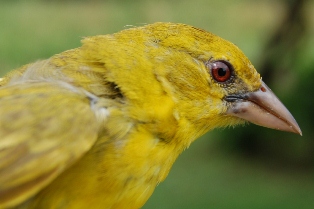 | On reviewing the longevity records within the SAFRING database I noticed an interesting retrap of an Eastern Golden (Yellow) Weaver by Andrew Pickles. This individual was initially ringed in the Umzumbe River Floodplain, Kwa-Zulu Natal on 7 December 2002 and coincidentally retrapped exactly 12 years later on 7 December 2014. This is a new longevity record for this species and as this individual was initially ringed as an adult and only retrapped it will be over the calculated age of 12 years. The previous longevity record for this species was held by an individual from these same floodplains (click here for article) which lived over 9 years (ring number: BH19329).
If you feel you know of an older record please contact us at SAFRING with the details.
Furthest sunbird movement Christie Craig (2015-06-24)  In general sunbirds are known to move little, most recaptures are from the same site that they were ringed at. However sometimes sunbirds are found a fair distance from where they were ringed, one such bird is a Scarlet-chested Sunbird (Nectarinia senegalensis). It was ringed (see record) at Chirawanoo Farm in Zimbabwe and then was found dead two years later at Chegato, Zimbabwe some 360km away. When looking at other records for this particular species, 76% of recaptures are at the site where it was ringed and the average movement for these birds is 10.82km. This makes this particular individual quite unusual. The Scarlet-chested Sunbird is widespread in Africa but occurs mainly in the eastern region of South Africa, with some individuals in the Northern Cape. These birds rely on nectar sources to sustain them but will also feed on arthropods from time to time. It is likely that sunbird movements are driven primarily by nectar availability. Sad, but interesting recovery of a Brown Snake-eagle Dane Paijmans (2015-06-17) 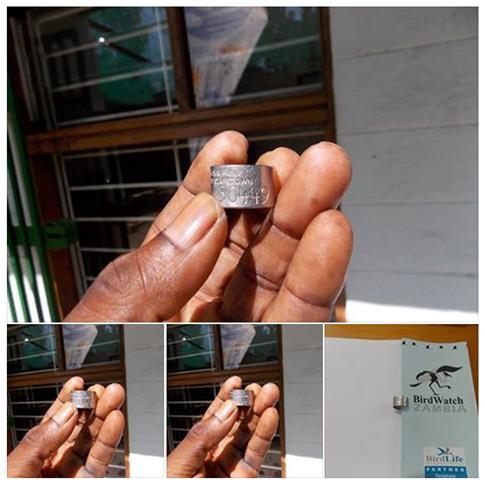
We received an interesting but sad recovery of a Brown Snake-eagle from our Facebook page last week (click here for facebook story). As the reporter (Kelvin Lighton Mkandawire) gave an interesting account I felt only his words would give the story justice. Please see his account below: "DRAMATIC RING RECOVERY : Details on the Recovered Ring - read as follows (INFORM SAFRING - UNIVERSITY CAPE TOWN 9A 30449) This steel Ring was found on unidentified raptor that caught a large snake and flew with it, while in flight, somehow the snake coiled on one wing of the bird and disrupting the birds flight, as a result of this dramatic scenario both the bird and the snake fell to the ground while locked together, this unusual wrestling encounter that began in the air now continued on the ground, the snake struggling to free its self from the tight grip of the Raptor while the Raptor on the other hand trying to free his entangled wing from the snakes body, the snake taking advantage of its length started pulling the Raptor along with it, unfortunately, the place where they landed from the air was on a dirty road in Simachila Village, this dirty road is one of the most frequented local routes for most people in the area, this means that all this was happening in full view of the so many local people that were present at the time, when all local concluded that this scenario was some form of Witchcraft or at least related (Wizards Fighting in disguised form), one resident came with a Shot Gun and killed both the snake and the bird. This spectacle drew so much attention in the area being the first time such an incident happened where a bird and snake would fight so strongly with none of the two being stronger than the other, had it not been for these two being shot at, the fight could have gone on for quite a long time, the two wrestlers now dead, were displayed on the roadside for would be onlookers to catch a glimpse, they were left there until the following day when the villagers decided to burn them, it was at this point when it was discovered that the bird had a Ring on one of its legs, among these villagers was a School Headmaster from Bbakasa Primary School in Mutolanganga Important Bird Area one of the sites where Birdwatch Zambia operates, this is the man who convinced the villagers to remove the Ring before burning it, he learned the importance of bird ringing and ring recoveries from the IBA School Education Program that Birdwatch Zambia runs in IBA Schools in Zambia. At this information being availed to them, they chopped off the head of the Raptor, and the leg where the Ring was and gave them to the headmaster who reported the incident to me, I couldn’t ID the bird from the chopped head and leg because they were poorly preserved and got rotten, however, I received the Ring which is at Birdwatch Zambia Offices, this incident happened in Mapanza area of Choma District in Zambia on the 22nd of August 2013."This Brown Snake Eagle (ring number :9A30449) was first ringed as an adult by John Robson in Bitterfontein, Steenbokpan on 26 January 2007. Although this was a controversial account we still greatly appreciate the information as it is important to get these details no matter what the circumstances. If you happen to know of any similar accounts whether they are deaths related to “muti” collection or individuals being shot as they were pests/fpr food please do let us know by contacting SAFRING or by using our Recovery Page. The photo and story accompanied by this article are accredited to Kelvin Lighton Mkandawire.
Longevity of the Black-capped Bulbul Dane Paijmans (2015-06-10) 
This week’s longevity record looks at the Dark-capped Bulbul. A few months ago I calculated the longevity
record for a Cape Bulbul
which lived in excess of 11 years (ring number: BB09354).
On reviewing the other bulbul species in our database I found this longevity bested by a Dark-capped Bulbul ringed and
retrapped a number of times by Trevor Snyman in Marionwood Nature Reserve, Pinetown. This individual was first ringed in 1987 as an adult female and since then has been retrapped an additional six times until it was last seen alive in 2002. This makes our longevity record over 14 years 10 months and 23 days.
If you feel you know of an older record please contact us at SAFRING with the details.
New longevity record for the White-breasted Cormorant Dane Paijmans (2015-06-03) 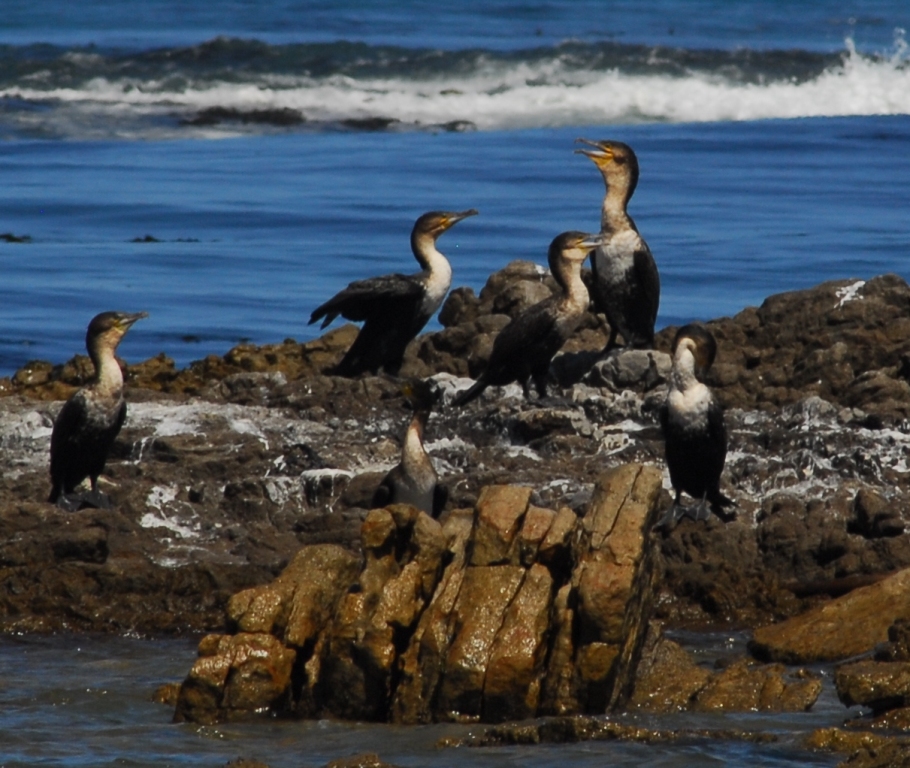 We recently received an interesting recovery of an older White-breasted Cormorant (ring number: 978110) by Mr Albert Schultz from Port Elizabeth. This individual was first ringed as a chick by Dr Paul Martin in the same area some 21 years 9 months before. I was interested to see that this record bested both our previous SAFRING longevity record (ring number: 902745) and the Roberts 7 longevity by 6 months. Our database did have one additional record that was older (25y1m27d; ring: 901054), although as this ring was recovered without the attached bird the record could not be counted as a longevity. If you feel you know of an older record please contact us at SAFRING with the details.
Urban Pull Factors for Hadedas Christie Craig (2015-05-27) 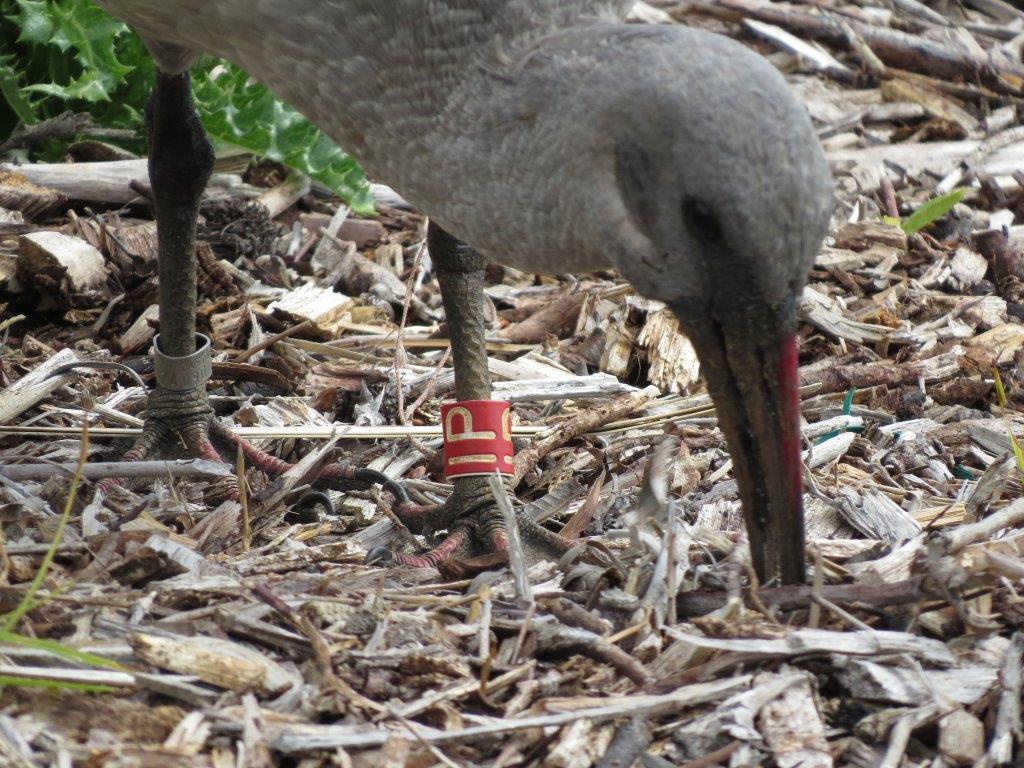
The Hadeda Ibis
(Bostrychia hagedash)
is a conspicuous bird, due to its large size and distinctive call. They are mainly sedentary with occasional movements in relation to rainfall. Our furthest map .
Longevity of the Grey-headed Gull Dane Paijmans (2015-05-20) 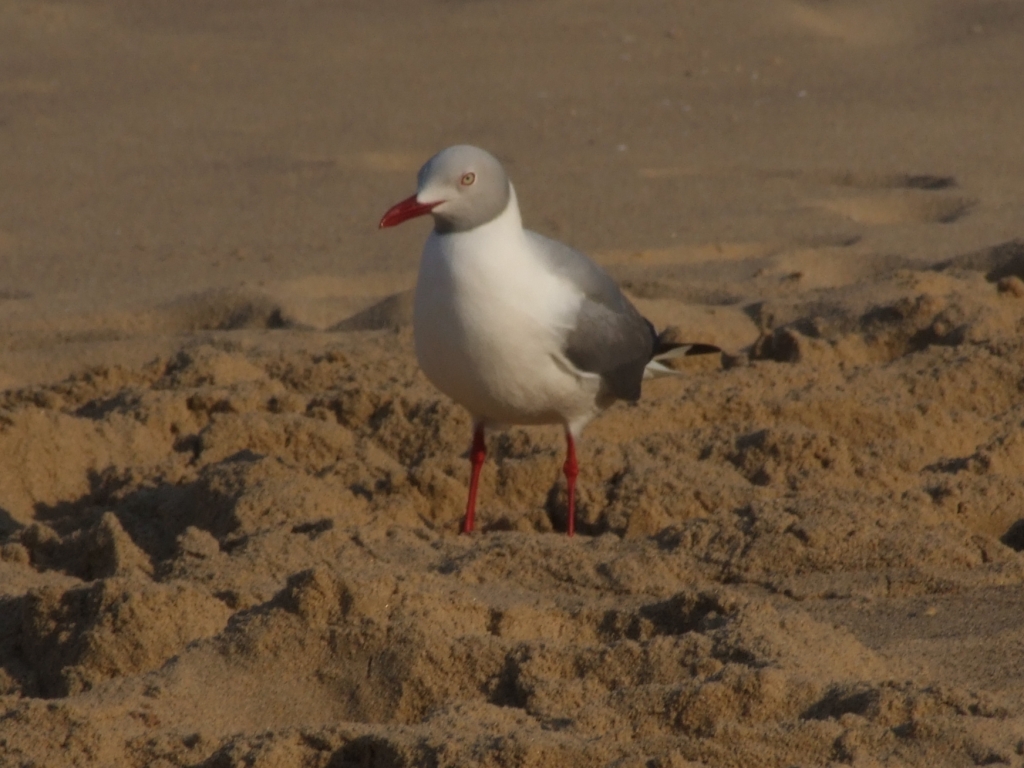 This week’s longevity record looks at the Grey-headed Gull. After seeing how old a Hartlaub's Gull can get I was curious about the longevity of their sister species. The Grey-headed Gull is a common companion to the Hartlaub's Gull and is found across a far greater range of this country. In a comparison of longevities however the Hartlaub's Gulls' 27.5 years is far greater than the Grey-headed Gulls' longevity of only 16.04 years. This is due to the limited retraps and recoveries for the Grey-headed Gull. This longevity record is likely to improve as more records come in and as this individual (longevity record) was only retrapped it may be seen again in the future.
If you feel you know of an older record please contact us at SAFRING with the details.
Longevity of the Hartlaub's Gull Dane Paijmans (2015-04-29) 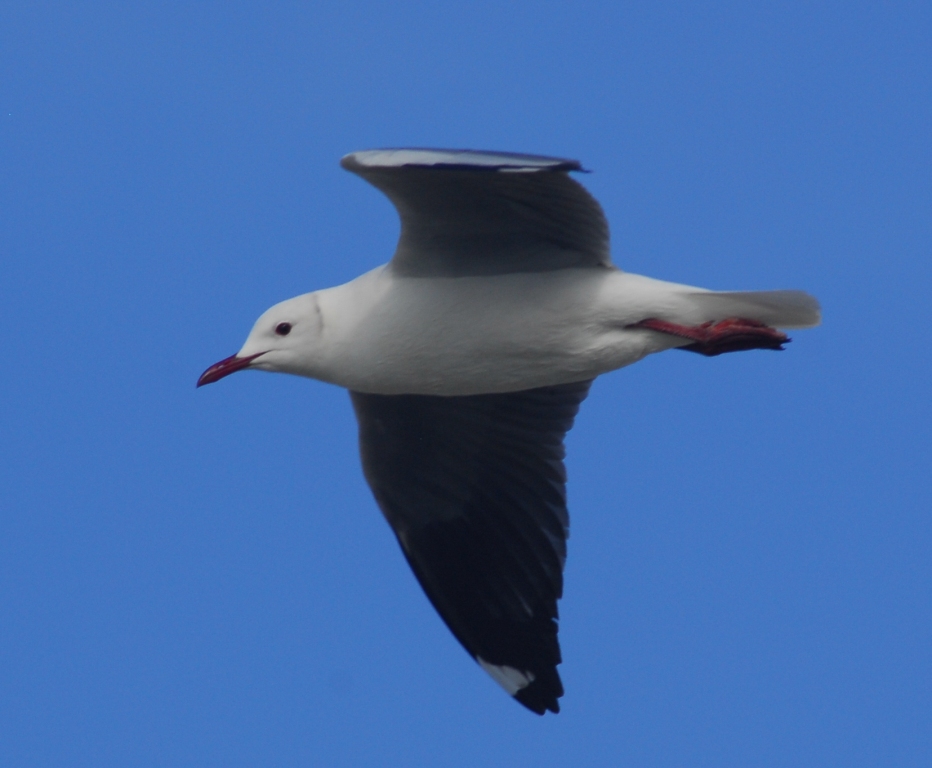 This week’s longevity record looks at the Hartlaub's Gull. After receiving a recent record of a 14 year old individual (582766) I felt that this may be an interesting species to compare. It turns out the recent record was still very young in terms of the maximum SAFRING recorded longevity of this species (27y 6m 8d). It falls very short of the title as it is only the 35th oldest Hartlaub's Gull record in our database. Both of these individuals sadly met the same fate and were euthanized as a result of injuries. This after a long life which started out on Robben island (in 1976 (oldest) and 2000 (our 14 year old individual)). Another random coincidence a few of the more observant readers may have noticed is that our oldest record was first ringed by the ADU directors father (George Underhill) and the younger individual ringed by the ADU director himself (Les Underhill).
If you feel you know of an older record please contact us at SAFRING with the details.
A White-faced Duck found a long way from home Christie Craig (2015-04-23) 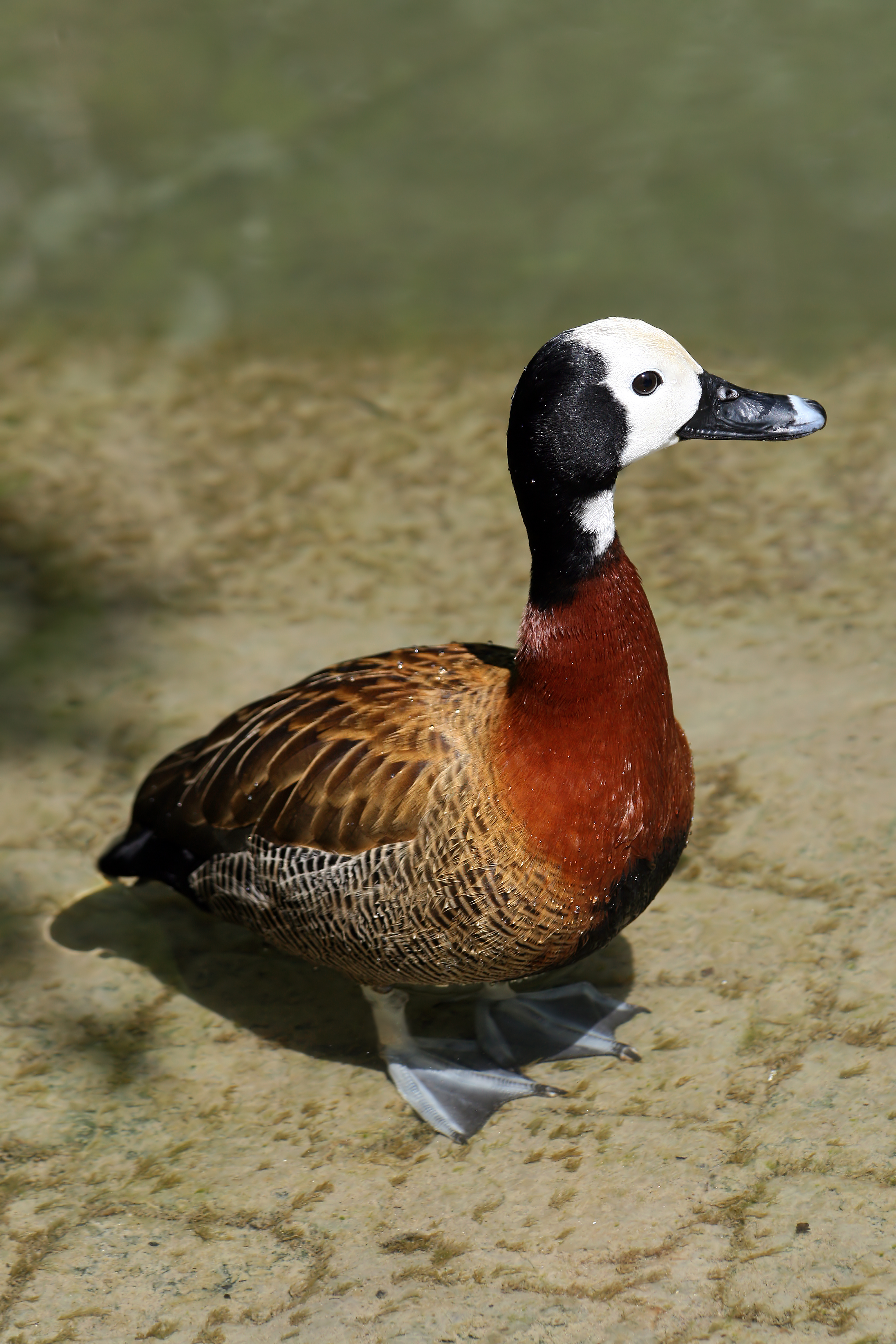
White-faced Ducks (Dendrocygna viduata) are a widespread species in Africa, south of the Saharan Desert, and in South America. The movements of these birds are unpredictable but tend to be restricted to local movements, not further than 500km. Our records of White-faced Duck show that 78% of the 125 recoveries we received were within 100km of where they were ringed. However a few White-faced Ducks seem to have a little more ambition than others and move much further. Last week a White-faced Duck was caught in Malolwane (Botswana) which was initially ringed by Dr Brown at Albert Falls (Pietermaritzburg), which meant that this duck had moved a distance of 668km!(see record)
Visiting Little Terns from Israel Dane Paijmans (2015-04-08) 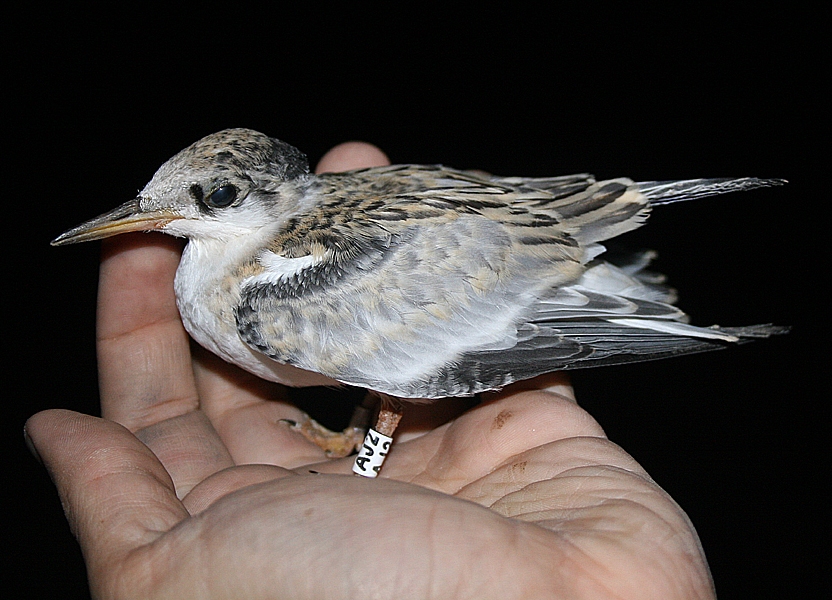
In March during a trip to Mozambique, Ian Sinclair photographed two Little Terns (Sterna albifrons) which were fitted with foreign metal rings as well as white plastic rings inscribed with AJ7 and AJ2. These photos were sent through to Tony Tree who knew exactly who to contact at the Israeli Bird Ringing Center regarding this sighting. The two Little Terns (B41693 and B41678) were ringed as juveniles in Atlit Salt-Pans, Israel by ringer Yosef Kiat in July 2012. This project has been ongoing since 2010 and further details can be seen by clicking here.
This species is rated Least Concern by the IUCN and we currently have 188 records of in our database. These low numbers are predominantly due to the fact that this species does not breed in Southern Africa and few of them are trapped. Their current breeding range is mostly in Europe and parts of Asia (click here for a map). They breed on open shorelines during periods of high fish and prey abundance before July. Once the breeding season is over they may visit Southern Africa (from late July) so this would be a good time to get some sightings in, and contact us with colour ring records. The photo accompanied by this article is accredited to Yosef Kiat.
Longevity of the Cape Batis Dane Paijmans (2015-04-01) 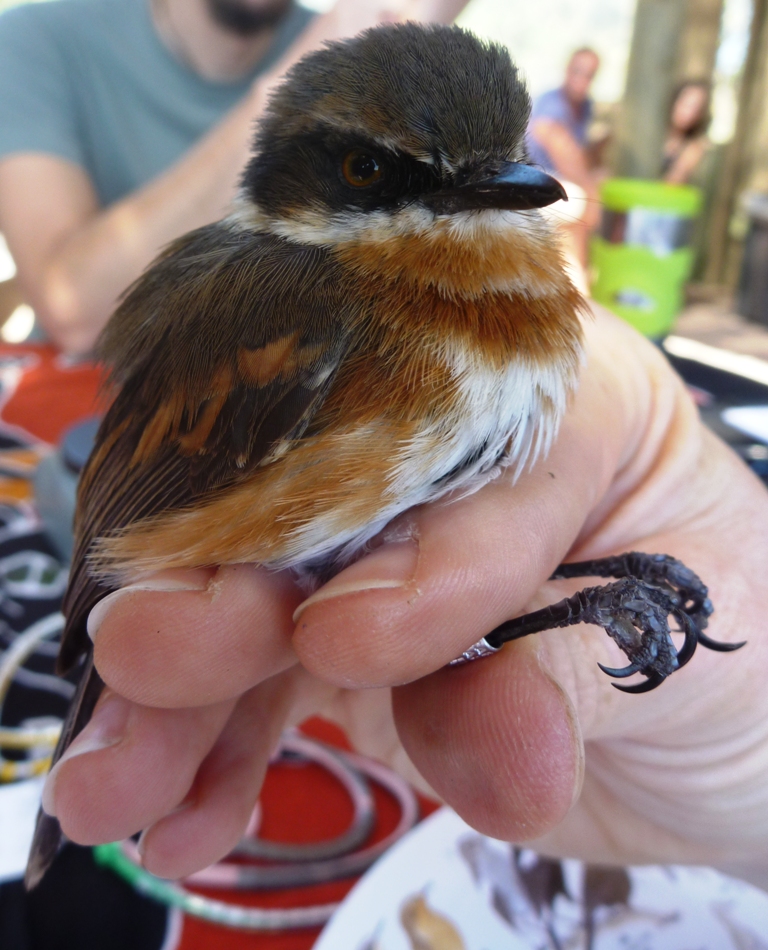 This week’s longevity record looks at the Cape Batis. I chose this species after I removed this one (in the photo) from a mist net. It was the first one I had handled and I was amazed at how gentle and relaxed it remained when handling. There haven't been too many recoveries for this species but just from the retraps we have calculated an impressive longevity. As this record was initially ringed as an adult and never recovered it is likely older than the calculated 13y 1m 12d.
If you feel you know of an older record please contact us at SAFRING with the details.
Visiting Lesser Spotted Eagle from Slovakia Dane Paijmans (2015-03-25) 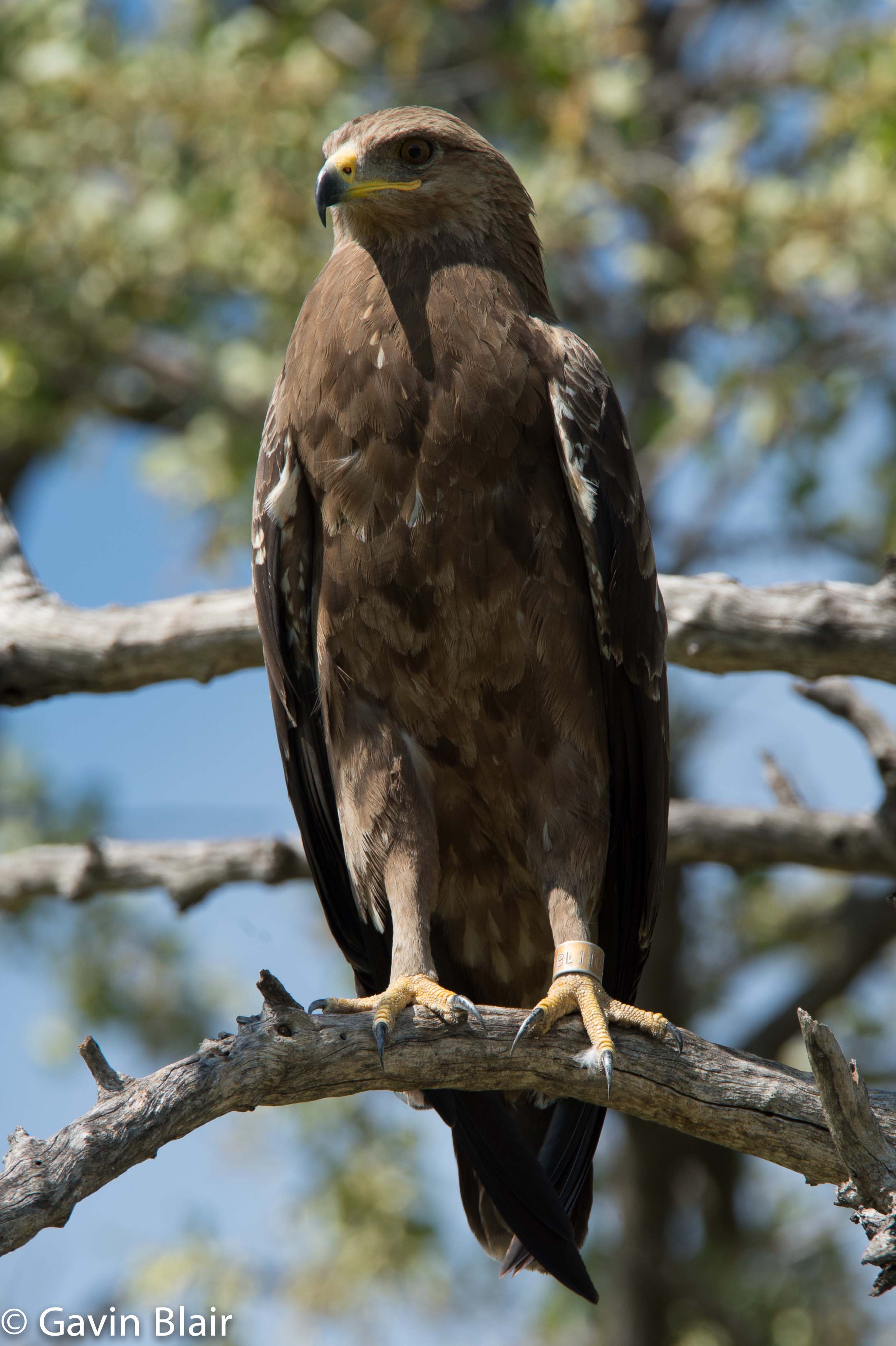
| In January during a trip to Chobe National Park in Botswana, Gavin & Marjorie Blair were fortunate enough to take a few photos of this Lesser Spotter Eagle (Aquila pomarina) which was fitted with an orange metal ring. Even though it was a very detailed photo, we at SAFRING had a hard time tracking down the initial ringing record as the ring had no ringing scheme inscribed. However, thanks to Stephanie Tyler who contacted a few ringing schemes we received a result. The individual (BL1109) was one of many chicks ringed in northern Slovakia by ringer Dusan Karaska in July 2012. This project has been ongoing since 2008 and further details can be seen by clicking here or here.
Although this species is rated Least Concern by the IUCN we currently only have 18 records of in our database. This is predominantly due to the fact that this species does not breed in Southern Africa and only visits the northern parts during their non-breeding season. Their current breeding range is mostly in Eastern Europe (click here for a map) near forest edges with a high prey abundance. If you happen to be in their non-breeding range and are on the look for one the best time would be between November and March. The photo accompanied by this article is accredited to Gavin & Marjorie Blair from Gavin Blair Safaris.
Longevity of the Common Waxbill Dane Paijmans (2015-03-18) 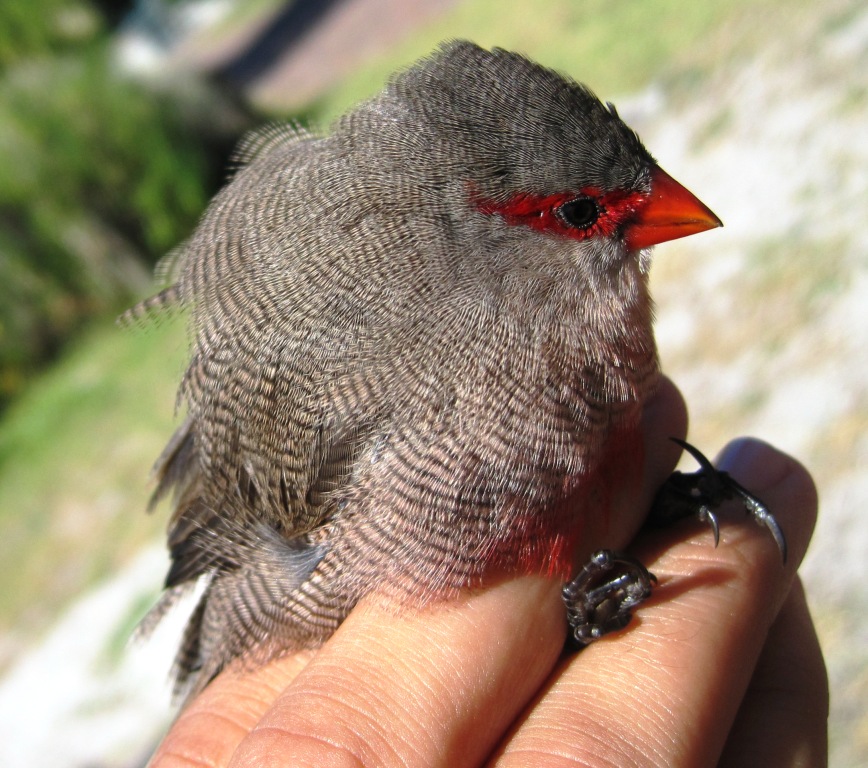 This week’s longevity record looks at the Common Waxbill. There have many retraps and recoveries for this species so we have a great source of data for our longevity records. Even so the longevity could be greater than calculated as this individual was ringed as an adult and only ever retrapped. Similar to the longevity of its cousin the Blue Waxbill (AD11424) this species should easily reach over 10 years old.
If you feel you know of an older record please contact us at SAFRING with the details.
Longevity of the Cape Bulbul Dane Paijmans (2015-03-11) 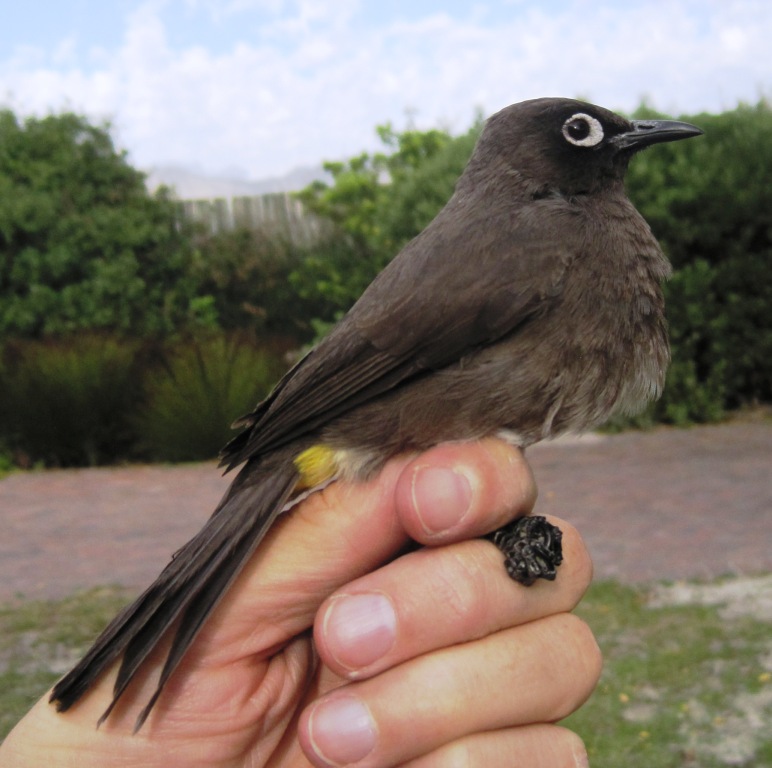 This week’s longevity record looks at the Cape Bulbul. After raising an injured bulbul chick some years ago I had personal reasons for calculating this longevity. I am happy to see that they live in excess of ten years and as this longevity record was only ever retrapped, I have hope my little friend may still be out there with many grand children. A more recent record is that of BD00938 which looks to be on its way to becoming our new longevity record for this species. If you feel you know of an older record please contact us at SAFRING with the details.
Longevity of the African Snipe Dane Paijmans (2015-03-04) This week’s longevity record looks at the African Snipe. There have been very few retraps or recoveries for this species which means that the calculate longevity of 7y 10m 9d is likely a good few years off. If their cousins the Common Snipe (Gallinago gallinago) (longevity record >16 years, BTO record) are anything to go on, African Snipes should have the potential to live a long life of ±20 years. If you feel you know of an older record please contact us at SAFRING with the details.
Longevity of the Barn Swallow Dane Paijmans (2015-02-25)  This week’s longevity record looks at the Barn Swallow. These little birds travel vast distances and many of our rings have been recovered across Europe and the UK. This individual is no different as it was initially ringed in Bloemfontein and recovered in Warton (England) 9479 km away. As this Barn Swallow was first ringed as an adult it is likely older than the calculated 9y 4m 25d. If you feel you know of an older record please contact us at SAFRING with the details.
Longevity of the Levaillant's Cisticola Dane Paijmans (2015-02-18) This week’s longevity record looks at the Levaillant's Cisticola. Not only is this individual’s longevity the greatest for the Levaillant's Cisticolas it is also the greatest longevity record we have for all the cisticola species. This individual has spent a fair amount of time in the mist nets at Rondevlei Nature Reserve, having been trapped a total of six times. As 'she' was first ringed as an adult and last seen alive and well, this individual has likely lived a fair amount longer than the calculated 7y 8m 5d. If you feel you know of an older record please contact us at SAFRING with the details.
Longevity of the Laughing Dove Dane Paijmans (2015-02-11) This week’s longevity record looks at one of the more commonly ringed birds; the Laughing Dove. We have an incredible 51753 ringing/retrap/recovery records for this species in our database so it offers itself to be a great subject for calculating the longevity. In addition it is easily retrapped so we have many longevity records to look at. Strangely the current maximum longevity record of 12 years 2 months has held for the last 20 years and no other individuals have come close with the runner-ups falling short at nearly ten years. If you feel you know of an older record please contact us at SAFRING with the details
Longevity of the Cape Glossy Starling Dane Paijmans (2015-02-04) This week’s longevity record looks at the Cape Glossy Starling. Being a common bird throughout most of the country we at SAFRING have received many initial ringing records (3248). The trouble with ringing the family Sturnidae however is that they are very clever and are unlikely retrapped in a similar method twice. This results in minimal numbers of retrap records occurring for these species. This longevity record for the Cape Glossy Starling was only trapped once when it was under 6 months old and then recovered soon after it died. If you feel you know of an older record please contact us at SAFRING with the details
Longevity of the Mountain Wheatear Dane Paijmans (2015-01-28)  This week’s longevity record looks at the Mountain Wheatear.
This individual has really seen his share of retraps and as of last month took his place as the oldest Mountain Wheatear in our database. This affinity to being resighted is primarily due to his love of mealworms as he regularly visits the ringer (Ursula Franke) at her holiday house to get these treats. He also enjoys the occasional beetle but does not fancy rose beetle grubs. As he was first ringed as an adult and has been sighted a few times since the last record he is likely older than the current record.
If you feel you know of an older record please contact us at SAFRING with the details.
Longevity of Methuselah the Great White Pelican Dane Paijmans (2015-01-21)  I hope everyone had a wonderful festive season and that 2015 has got off to a great start! To kick off this year's longevity stories we have a very special record: the oldest living individual currently in the SAFRING database. This title belongs to the Great White Pelican nicknamed "Methuselah" by Mark Boorman.
Longevity of the Groundscraper Thrush Dane Paijmans (2014-12-03) This week’s longevity record looks at the Groundscraper Thrush. Due to the limited retraps and recoveries this species does not have a representative sample to calculate the longevity from. Additionally this individual was ringed as an adult and only retrapped so it will be older then this current record. If you feel you know of an older record please contact us at SAFRING with the details.
Longevity of the Lilac-breasted Roller Dane Paijmans (2014-11-26) This week’s longevity record looks at the Lilac-breasted Roller. This is one of the species that requires additional records to establish a better longevity result. Although nearly eight hundred of these birds have been ringed we at SAFRING receive very few resigtings and recoveries. We have many species where this is a problem so representative longevity records are not available. Please think of this next time you go ringing and attempt to resight species with few retrap/recovery records. If you feel you know of an older record please contact us at SAFRING with the details.
Longevity of the Helmeted Guineafowl Dane Paijmans (2014-11-19) This week’s longevity record looks at the Helmeted Guineafowl. After nearly running one of these over the other day I was not surprised to discover that they had quite short life spans. There are a number of records around this 8 year mark, although many sites online state they may reach 15 years (none of these have references though). This specific individual was released into the Cape of Good Hope in 1955 as an adult so it may be a little older. If you feel you know of an older record please contact us at SAFRING with the details.
Longevity of the Cape Wagtail Dane Paijmans (2014-11-12) This week’s longevity record looks at the Cape Wagtail. These birds are a common sight throughout South Africa and easily recognisable by their namesake tail wag. This action has a few explanations although it is most likely used for social signalling and improving feeding efficiency. This longevity record may be quite a bit older as this individual was initially ringed as an adult and so far only retrapped. If you feel you know of an older record please contact us at SAFRING with the details.
Longevity of the Bank Cormorant Dane Paijmans (2014-11-05) This week’s longevity record looks at the Endangered Bank Cormorant. Due to all the research being done on these birds we have nearly as many re-traps/re-sightings as initial ringing records. This has resulted in many older records with one even exceeding 17 years although as the ring number was not clearly identified in the report we are not able to confidently verify it. We do urge you to try to recover the entire ring number and submit photos or actual rings when possible. If you feel you know of an older record please contact us at SAFRING with the details.
Longevity of the Kelp Gull Dane Paijmans (2014-10-29) This week’s longevity record looks at the Kelp Gull. Similar to other Charadriiformes Kelp Gulls can live quite a long time and due to various past projects we have a number of older individuals in our database. As these birds are not commonly retrapped most of our post-ringing records come from recovories sent in by the general public. This week’s longevity record (K05951) was found close to its 25th hatchday, and after an autopsy it was established that it had been shot. If you feel you know of an older record please contact us at SAFRING with the details.
Longevity of the Blue Waxbill Dane Paijmans (2014-10-22)  This weeks longevity record looks at the Blue Waxbill. These little birds can live quite a while and occur around the northern parts of southern Africa. This longevity record is probably a male first ringed as a juvenile in 1996. He has yet to be recovered so may be older. If you feel you know of an older record please contact us at SAFRING with the details.
Longevity of the White-browed Sparrow Weaver Dane Paijmans (2014-10-15)  This week’s longevity record looks at the White-browed Sparrow-Weaver. These birds have a number of records older than 11 years of both male and females. This specific individual is likely a female and as it was last retrapped and initially ringed as an adult it is likely a few years older than the calculated longevity of 11.3 years. If you feel you know of an older record please contact us at SAFRING with the details.
Longevity of the Southern Double-collard Sunbird Dane Paijmans (2014-10-08)  Another common resident of Kirstenbosch is the Southern Double-collared Sunbird. You would think a life spent eating only sugar would be very short, but this species has a number of longevity records of over 10 years. This record of 11.9 years may be bettered as this individuals death was due to drowning. If you feel you know of an older record please contact us at SAFRING with the details.
Longevity of the Martial Eagle Dane Paijmans (2014-09-30)  We received an interesting recovery this week of a Martial Eagle which sadly died after being electrocuted by power lines in the Kruger National Park. What makes the recovery so interesting is that the bird is estimated to be a minimum of 27 years old. This age is calculated by the fact that it was initially ringed as an adult (adult plumage is attained between 5-7 years) by Alan Kemp in 1992 as part of an earlier project on the species in the Park. The bird was also electrocuted close to the initial ringing site showing remarkable site fidelity over the last 22 years. This record was sent to us by Rowen van Eeden, a PhD student at the Percy FitzPatrick Institute, who is currently trying to identify the cause of the species population decline in the Kruger. If you would like to follow his work, please Click Here.
Longevity of the Spotted Eagle-Owl Dane Paijmans (2014-09-23)  If you stay in the Cape Town area, you can pop around to Kirstenbosch to see their resident pair of Spotted Eagle-Owls. This is where I took this weeks photo. The pair is currently breeding again and the female can easily be seen sitting on her eggs above the cycad garden. Be wary when getting too close as the male it keeping a close eye on her. If you aren't from around here don't worry as this is a common species found throughout southern Africa. If you feel you know of an older record please contact us at SAFRING with the details.
Longevity of the Common Tern Dane Paijmans (2014-09-17)  After reading Mark Boormans note in Laniarius 127 I though I would take a look at the Common Tern for this weeks longevity article. As per Marks note the SAFRING recorded longevity of the Common Tern is 33.67 years (AT055395). I have viewed the Euring, BTO, ABBBS and North American longevity lists to compare this record. It is infact the oldest record I could find and has been recently added to a list of sea bird longevities being compiled by the ABBBS for publication in calaboration with all the other ringing schemes. The previous longevity was 33 years ringed by the BTO and is recorded in the Euring database. If you feel you know of an older record please contact us at SAFRING with the details.
Swierstra's Francolin (Pternistis swierstrai) in Angola Dane Paijmans (2014-09-10) .jpg)
Here at SAFRING we get ringing records of many rare and interesting species from all over Africa and across the world. Occasionally we even get photos to back these up so I would like to show some of these on this site occasionally to inspire the pursuits (data records not hunting) of these rare and endangered species.
On an excursion during 2010 in Tundavala, Angola, Ursula Franke took these photos of Swierstra's Francolin (Pternistis swierstrai) which were trapped and ringed. She was in company of Steve, Louise and Dayne Braine and Mark Boorman along with a few others avid ringers. Their technique involved setting up large flap traps (assembled by Mark) at a site where Ursula had been observing the francolins taking their sandbath. They did managed to catch and ring two Swierstra's Francolins’ on this outing which in my opinion is a day very well spent.
We currently only have these two records in our database due to the fact that these birds are endangered (population estimated between 465-1052 and 1040-2080 pairs) as a result of deforestation and hunting. These birds only remain in isolated populations (click here for a map) within forests and forest edges where they feed on insects and seeds. The population of this species is on a decline and unless something is done to protect the habitats and individuals they may be in a lot of trouble. This information is taken from the IUCN website and for further reading on the Swierstra's Francolin please click here. Longevity of the Cape White-eye Dane Paijmans (2014-09-03)  For this week I chose to calculate the longevity of another common garden bird; the Cape White-eye. This species gave a few problems due to the fairly recent split forming Zosterops virens and Zosterops pallidus. This meant that a number of the older ring records were still assigned the old number, although as these two species have a very similar longevity (Z.pallidus: 10.65 years) it was not a big problem. If you feel you know of an older record please contact us at SAFRING with the details.
Longevity of the White-fronted Bee-eater Dane Paijmans (2014-08-27)  For this week I chose to calculate the longevity of a common bird found in the more northern parts of the country; the White-fronted Bee-eater. This species has far fewer ring records then the other birds I have listed so far, which may account for the short longevity of only 7 years. This individual however was ringed as an adult and only retrapped so far which means these birds definatly do live longer. If you feel you know of an older record please contact us at SAFRING with the details.
A recovery of a long distance traveller Dane Paijmans (2014-08-22) 
An Arctic Tern initially ringed on Wooden Ball Island, Maine, USA has recently been recovered 12,874 km away, in Mooi River, KwaZulu-Natal. This individual (ring # 133220783) was initially ringed in the summer of 2011 by an American ringer Stephen Kress, and was recovered just east of Mooi River on 3 May 2014. This is one of only three tern records that we have from North America, with the other two originating from Canada in 1928 and 1947 (000548138 and 047306032 respectively). I would like to thank Tony Tree for making us aware of this record and Trevor Hardaker for forwarding all the information to us. I would also like to thank all those involved in the identification process. When discovering any ringed bird please be sure to let us at SAFRING know so that we can add it to our database. Longevity of the Cape Sugarbird Dane Paijmans (2014-08-20) 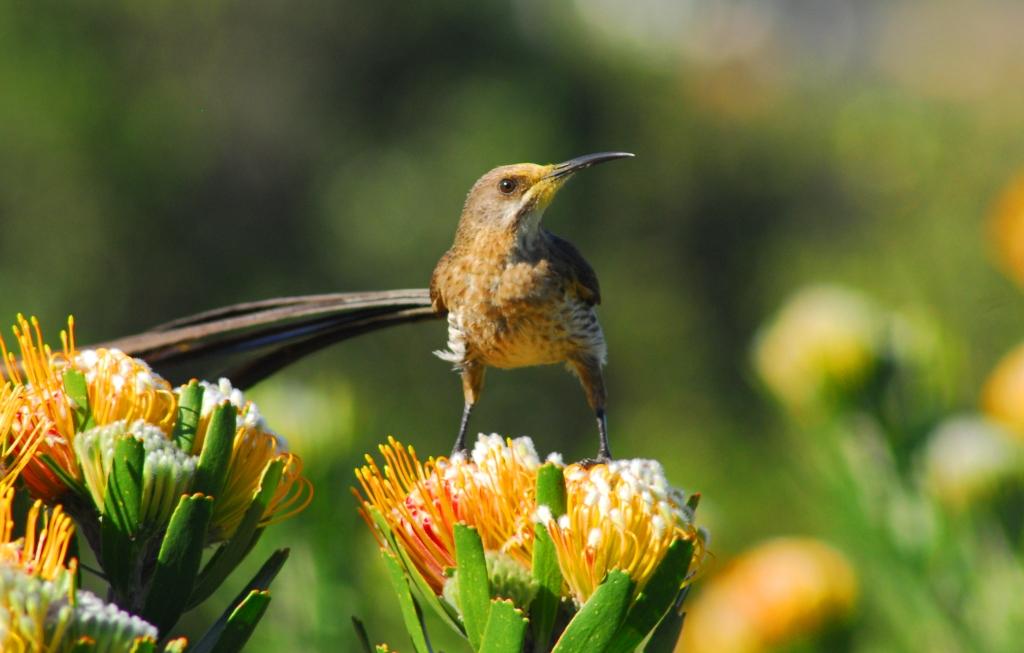 For this week I chose to calculate the longevity of a bird thats a common sight around the proteas in the Cape; the Cape Sugarbird. This individual was again a female and just like the Cape Sparrow last week has not left the initial ringing site. The longevity given by Roberst 7 is the runner up to this one and is a male ringed in Somerset West in the 80s. If you feel you know of an older record please contact us at SAFRING with the details.
Longevity of the Cape Sparrow Dane Paijmans (2014-08-13) For this week I chose to calculate the longevity of a more common garden visitor; the Cape Sparrow. This individual was a female and appears to have spent her whole life in Vanderbijlpark. This isn't to say the females live the longest as we also have a male longevity record of 10.55 years. If you feel you know of an older record please contact us at SAFRING with the details.
Vehicular Fatalities Dane Paijmans (2014-08-06)  Researchers for the Massachusetts Turnpike Authority found over 200 dead crows near greater Boston recently, and there was concern that they may have died from Avian Flu. A Bird Pathologist examined the remains of all the crows, and, to everyone's relief, confirmed the problem was definitely NOT Avian Flu. The cause of death appeared to be vehicular impacts. However, during the detailed analysis it was noted that varying colours of paints appeared on the bird's beaks and claws. By analysing these paint residues it was determined that 98% of the crows had been killed by impact with trucks, while only 2% were killed by an impact with a car. MTA then hired an Ornithological Behaviourist to determine if there was a cause for the disproportionate percentages of truck kills versus car kills. The Ornithological Behaviourist very quickly concluded the cause: when crows eat road kill, they always have a look-out crow in a nearby tree to warn of impending danger. They discovered that while all the lookout crows could shout "Cah", not a single one could shout "Truck”. On a more serious note I thought we could take a look at the of vehicular fatality statistics within the SAFRING database. On calculating the total deaths resulting from our various forms of transport I found that the total number of recovered birds is 666, and thankfully I’m not too superstitious or I would see a bad omen in that number. This total is made up of 152 different bird species, ranging from small weavers, sunbirds and doves, to the not so small Cape Vulture, Secretary Bird, and various eagle species. Strangely crows do not appear on this list, although this may be a result of very few ringed individuals. This is of course not an accurate count as most of the birds killed on our roads are not ringed and will not be reported. The main culprit of these fatalities are cars and trucks, although interestingly we also had a small number of collisions (>20) resulting from trains, planes and even ships. So if in future you come across a deceased bird along the road be sure to take a quick look to see if it has a ring and send these details to SAFRING. Longevity of the Spotted Thick-knee Dane Paijmans (2014-07-30) For this week I chose to calculate the longevity of the Spotted Thick-knee. This old individual was initially caught as an adult and retrapped so would be a few years older than 22. If you feel you know of an older record please contact us at SAFRING with the details.
Longevity of the Cape Gannet Dane Paijmans (2014-07-23) 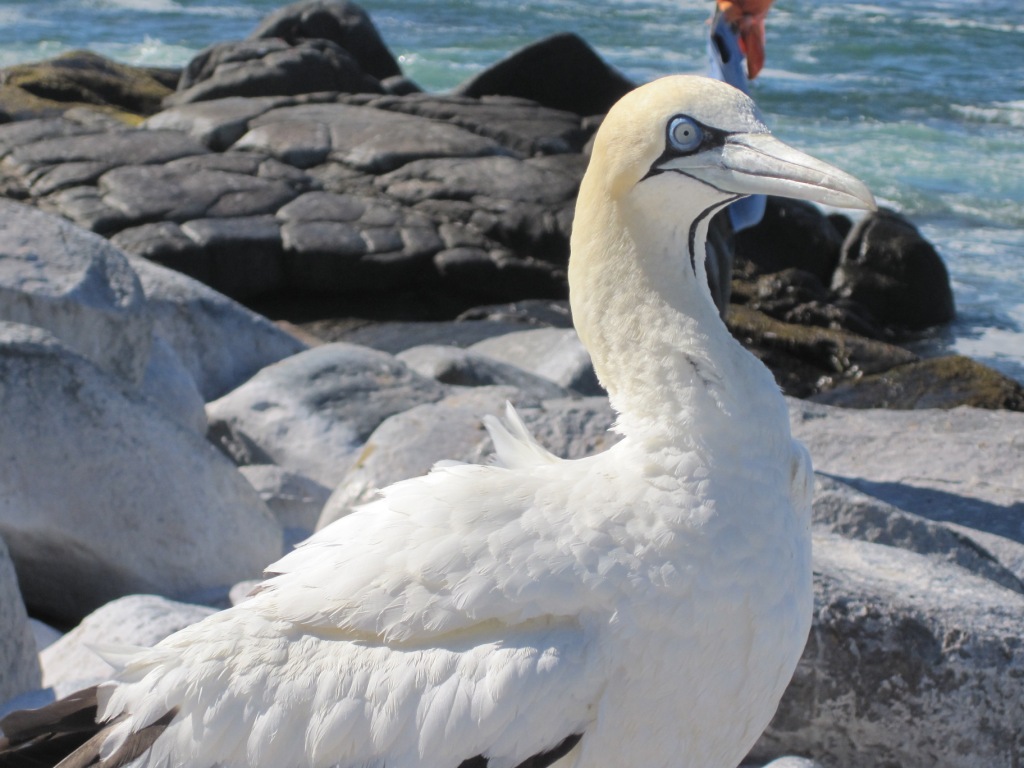 Sticking to birds I ran into during my personal field work (as these are the ones I have photos), I chose the Cape Gannets longevity this week. An interesting fact about this old bird is that it has not been recovered so if it is still alive today it would be 47 years old. If you feel you know of an older record please contact us at SAFRING with the details.
Longevity of the African Black Oystercatcher Dane Paijmans (2014-07-17)
As part of an effort to compile an up to date longevity list for southern African birds I will be uploading a regular maximum longevity of one species found within the SAFRING database. All these records will go into a complete list that we will hopefully publish before the end of the year. An interesting point to note about the record below is that this bird did not die from natural causes as it euthanized due to a broken leg. If you feel you know of an older record please contact us at SAFRING with the details.
An Interesting Article Utilising Bird Ringing Data Dane Paijmans (2014-07-03) 
| A new paper coauthored by Dr Mark Brown has just been published in Animal Conservation utilising bird ringing data. Abstract Previous studies that tracked the movements of single bird species within human-modified landscapes have shown that the ability of forest birds to move across matrix habitat differs among species. Functional guild specificity as well as landscape characteristics have been shown to influence bird movements, entailing different movement behaviour of birds within a community. Studies investigating how both these factors influence the movements of entire bird assemblages across fragmented landscapes are essential but have rarely been conducted. In this study, we determined how species’ traits and different forest matrices influence bird movements among nine forest patches in a highly fragmented South African landscape. We combined 90 h of bird observations with capture–mark–recaptures (104 754 mist-net hours) to distinguish between movements among patches (all birds that conduct long-distance movements across the landscape) and movements within patches (all resident birds that conduct only short-distance movements within a fragment). Overall, we detected a high bird movement activity across the fragmented landscape. Dietary specialization, habitat affinity and body mass strongly shaped the relative distribution of bird species across the nine fragments with frugivorous birds, forest specialists and large-bodied species showing the highest movement abilities. In contrast, resident insectivores and forest generalists tended to move only within particular forest fragments. Our results suggest that remnant forest fragments may represent valuable stepping stones as well as permanent habitat for local bird assemblages. We emphasize that beside the conservation of natural forests, the maintenance of nearby, structurally rich forest fragments is pivotal in maintaining regional forest bird assemblages in human-modified landscapes. If you are interested in this article click on the image on the left to be directed to the journal site. Re-sighting of a Subantarctic Skua (Catharacta antarctica) at Durban harbour Dane Paijmans (2014-06-11) 
On the 9th of June 2014 SAFRING received an email from David Allan from the Durban Natural Science Museum reporting a sighting of a Subantarctic Skua (Catharacta antarctica) which occurred at the mouth of Durban harbour on 8 June. This sighting was made more interesting by the fact that this bird was metal- and colour-ringed. Thanks to Peter Ryan from the Percy FitzPatrick Institute of African Ornithology we could trace the origins of this bird to Marion Island where it hatched during the 2008/2009 breeding season. Further details can be seen by clicking the ring number (854101). Although this skua is occasionally seen along our coasts these birds are rarely ringed. We at SAFRING only receive one record of ringed skuas every few years. Special thanks go to David Allan (Durban Natural Science Museum) for the photos and sighting details. Colour Rings on Swift Terns Dane Paijmans (2014-05-27)  Swift Terns are one of the few locally-breeding seabirds whose numbers are increasing. To help understand the main factors driving the positive trend of this species, a team of researchers from the Percy FitzPatrick Institute of African Ornithology and the Animal Demography Unit at the University of Cape Town marked 500 Swift Terns chicks from Robben Island in April 2013 and 2014 with metal and individually engraved colour rings. In 2013 members of the public reported how these birds dispersed, providing information on the fledging success, survival and dispersal of juvenile Swift Terns, which were re-sighted from Namibia to the Eastern Cape. Gathering dispersal records is a time consuming but important task that relies on assistance from volunteers across southern Africa. Rings in 2014 are orange and yellow (with black text) and green and blue (with white text), and are engraved with an “A” followed by a letter and a number (e.g. AU2). Rings from 2013 are yellow and white (with black text) and green and blue (with white text), and bear a code of one letter and one number (e.g. U2). The majority of the colour rings are top-down and all are on the right leg. If you see any ringed birds please record their location as accurately as possible (ideally GPS), the date and time of sighting, ring colour, letters on the ring (if legible) and age class (juvenile or immature). If a bird is found dead, please also record the number of the metal ring. Please send the information to Davide Gaglio: swift.terns@gmail.com Remember to always submit colour ringed bird records to SAFRING as well by clicking here Thanks for your help! Free English edition of Der Falke on bird migration Dane Paijmans (2014-05-13) 
|
An interesting special english edition of Der Falke has been released on bird migration. Take a look at this free copy by clicking on the image on the left (Filesize: 8.79MB). | |||||||||||||||||||||||||||||||||||||||||||||||||||||||||||||||||||||||||||||||||||||||||||||||||||||||||||||||||||||||||||||||||||||||||||||||||||||||||||||||||||||||||||||||||||||||||||||||||||||||||||||||||||||||||||||||||||||||||||||||||||||||||||||||||||||||||||||||||||||||||||||||||||||||||||||||||||||||||||||||||||||||||||||||||||||||||||||||||||||||||||||||||||||||||||||||||||||||||||||||||||||||||||||||||||||||||||||||||||||||||||||||||||||||||||||||||||||||||||||||||||||||||||||||||||||||||||||||||||||||||||||||||||||||||||||||||||||||||||||||||||||||||||||||||||||||||